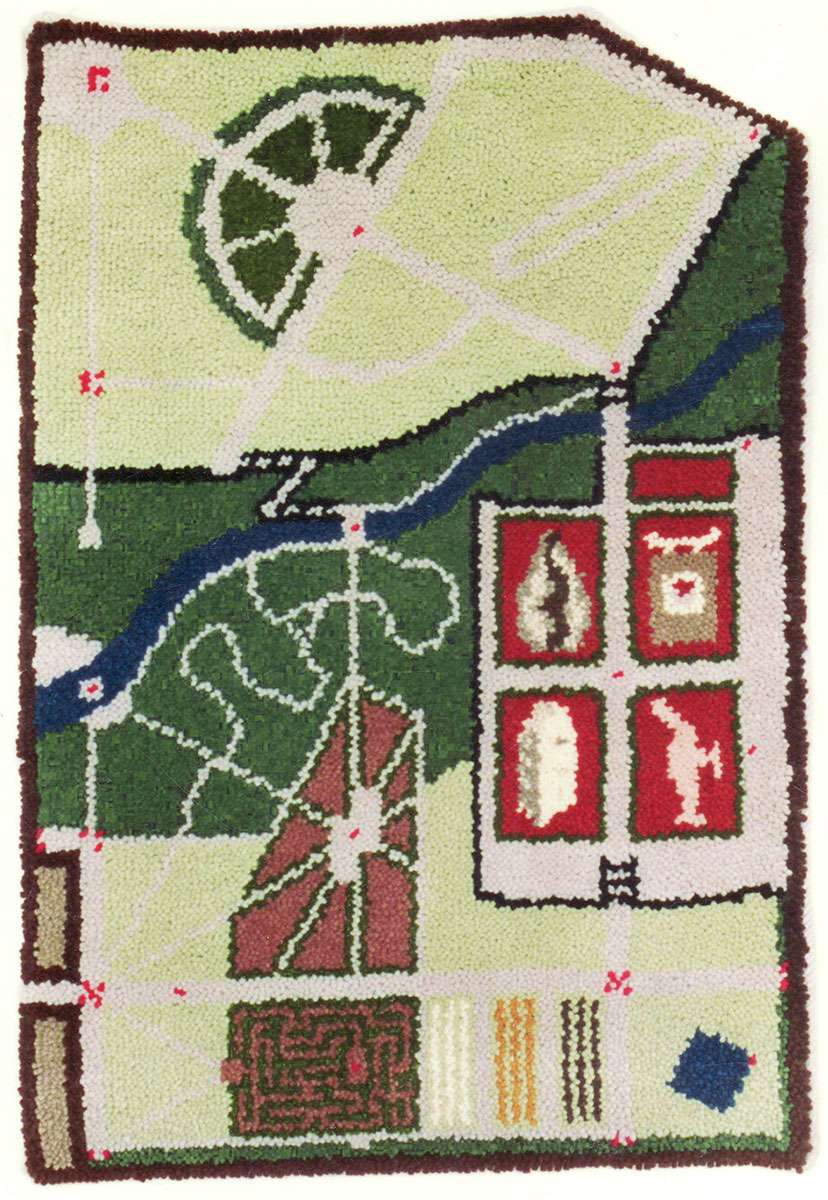
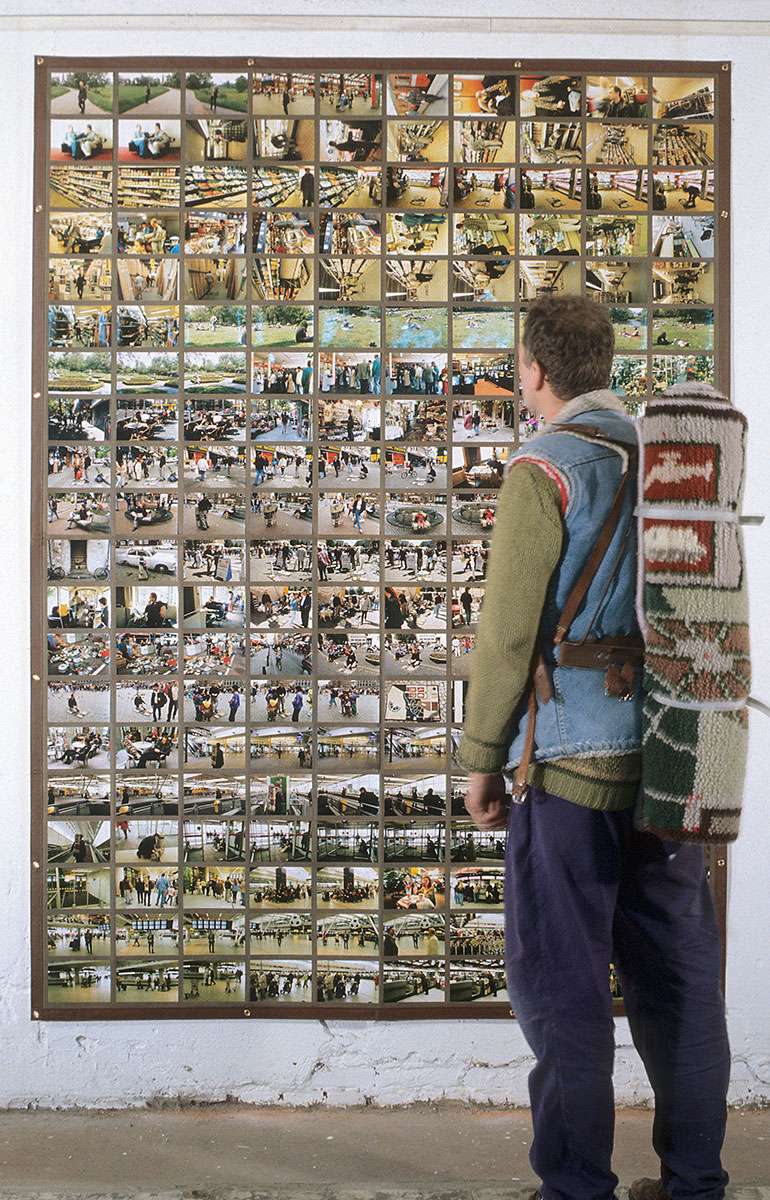
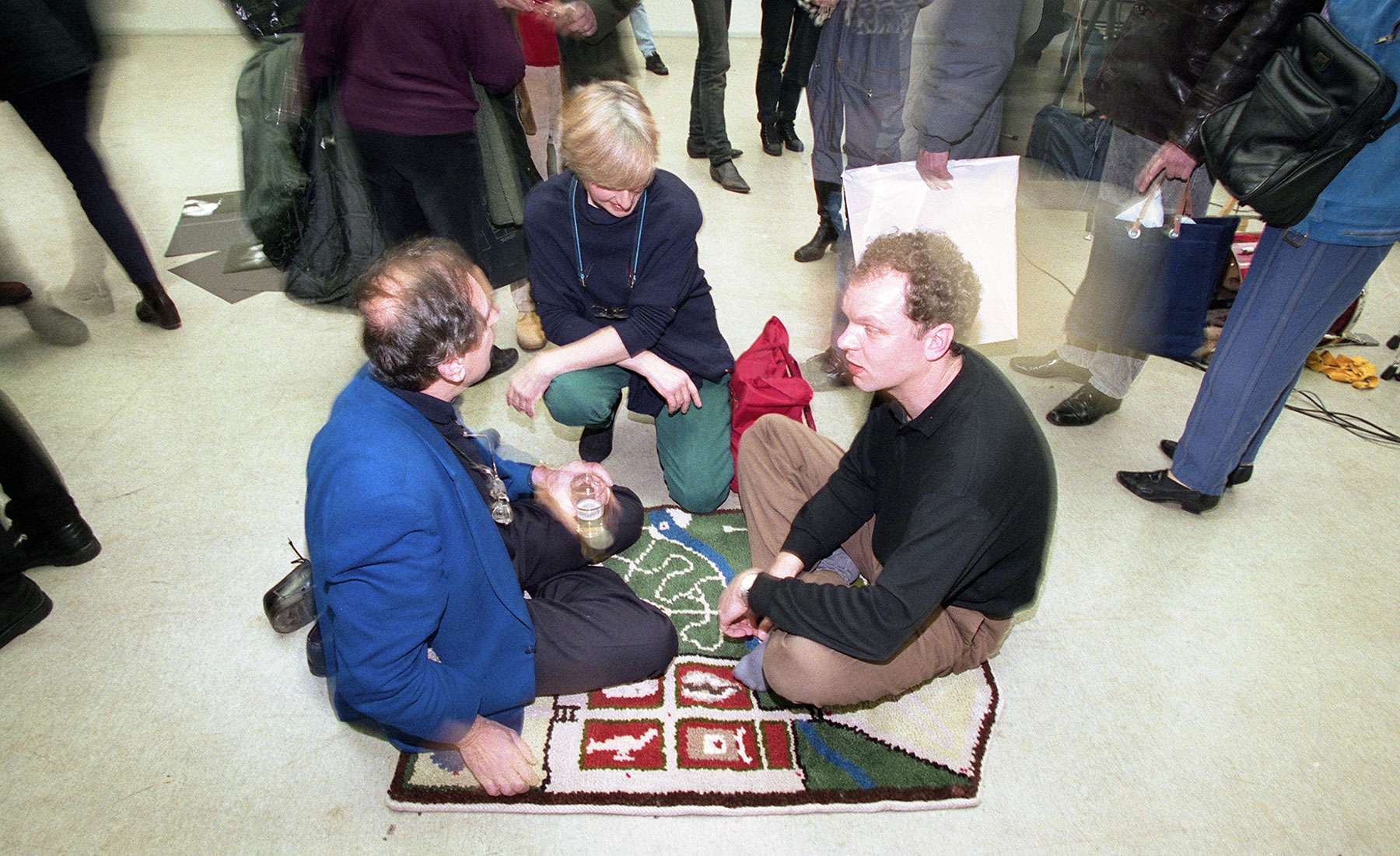
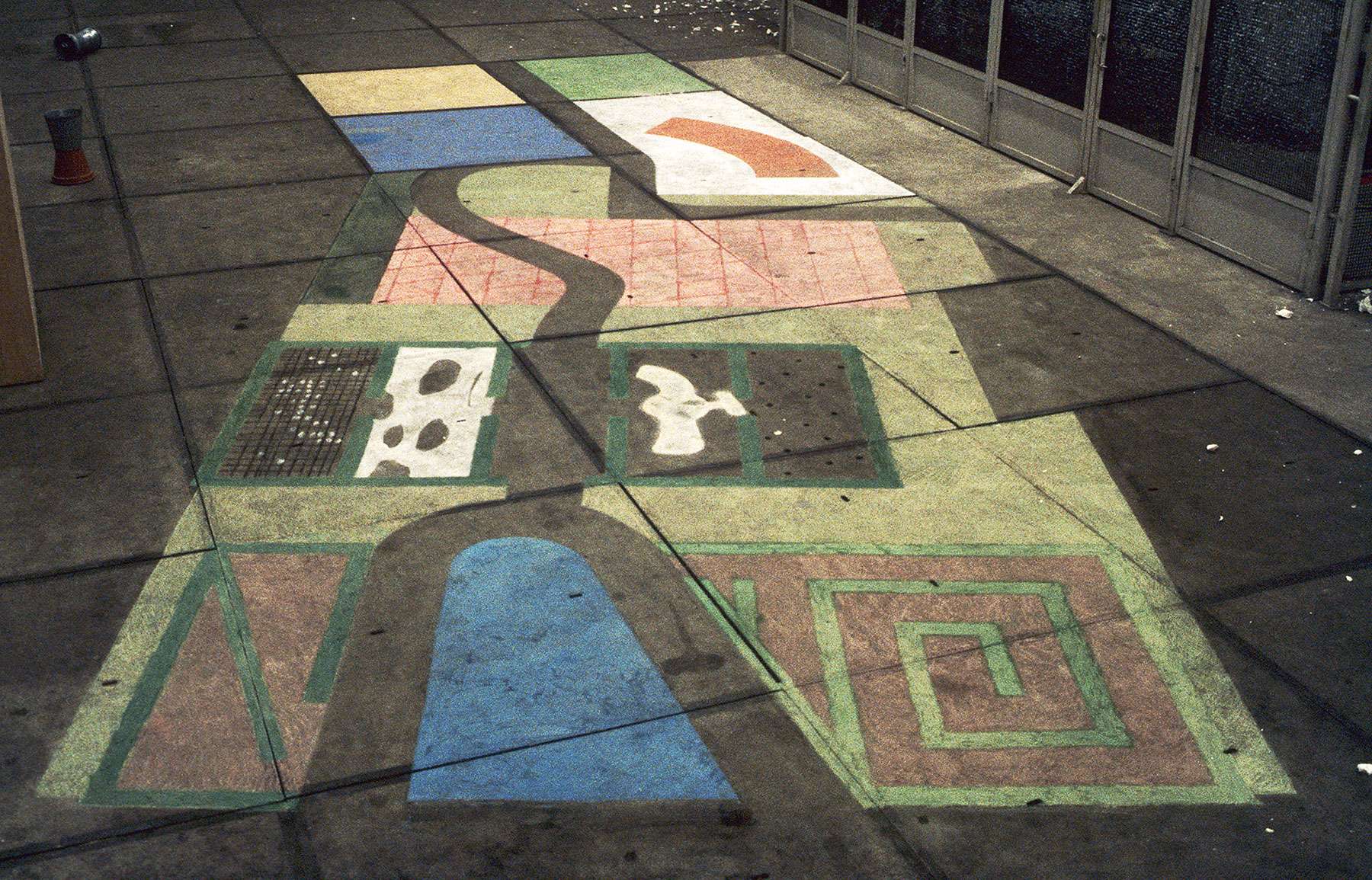
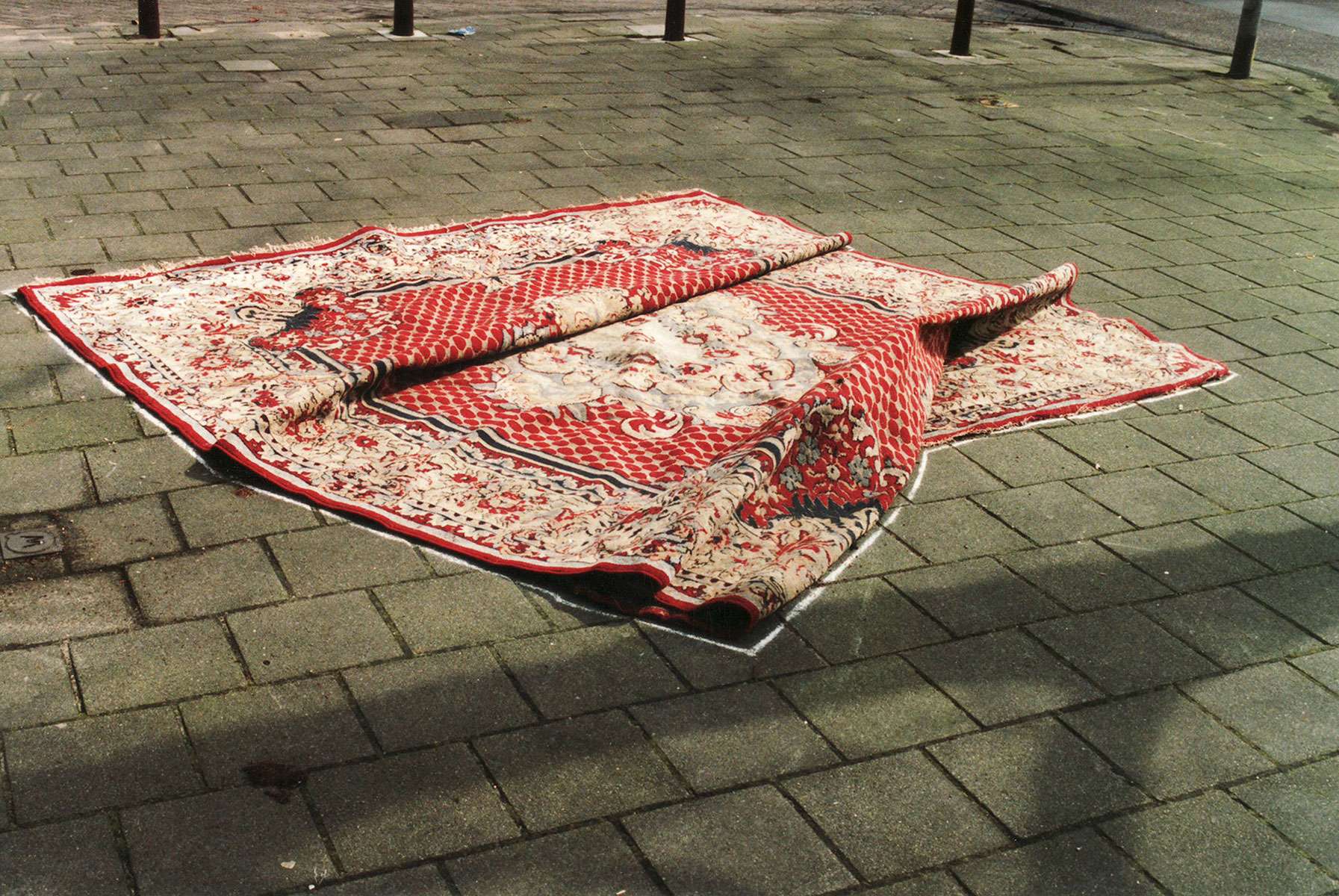
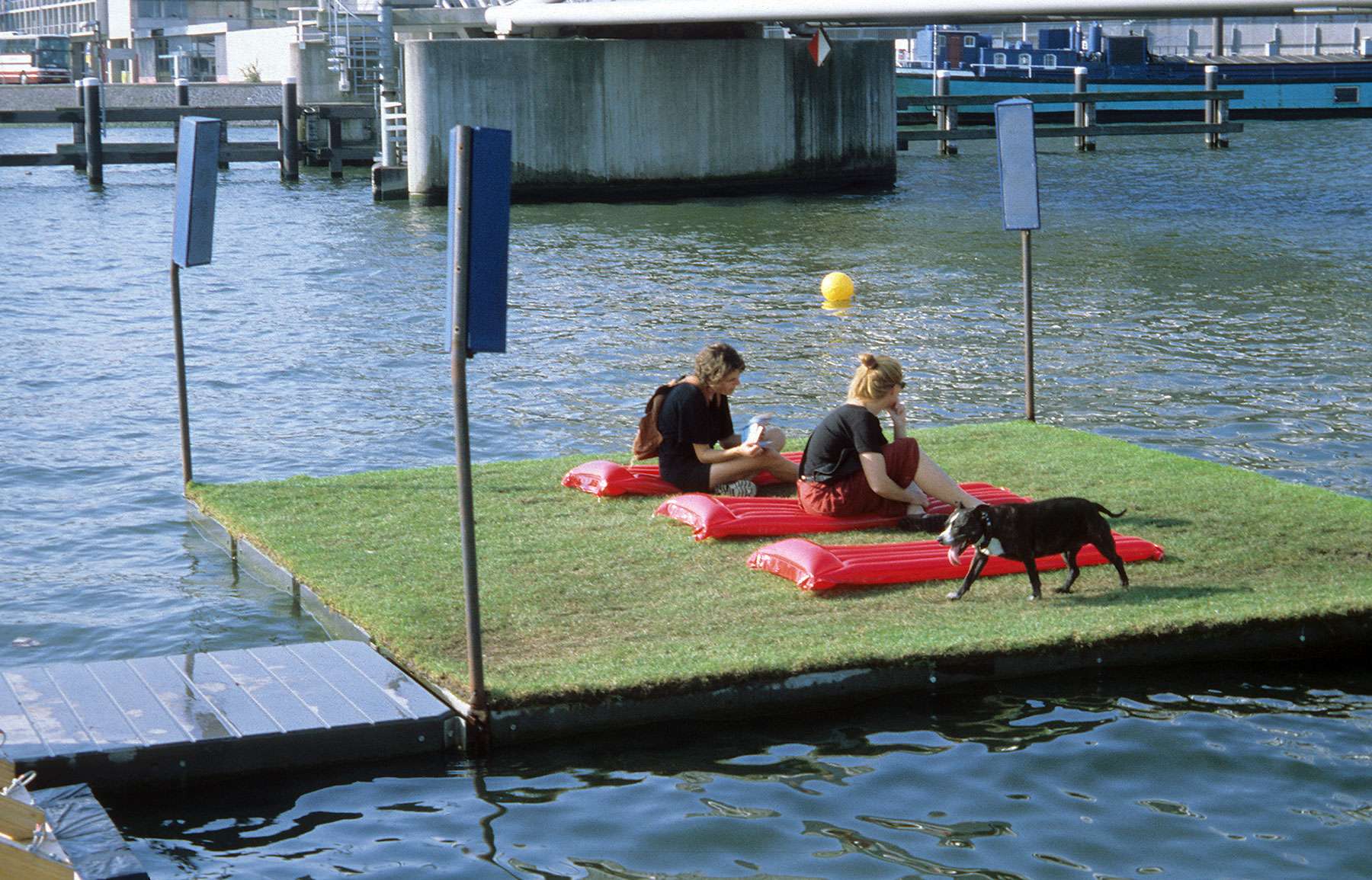
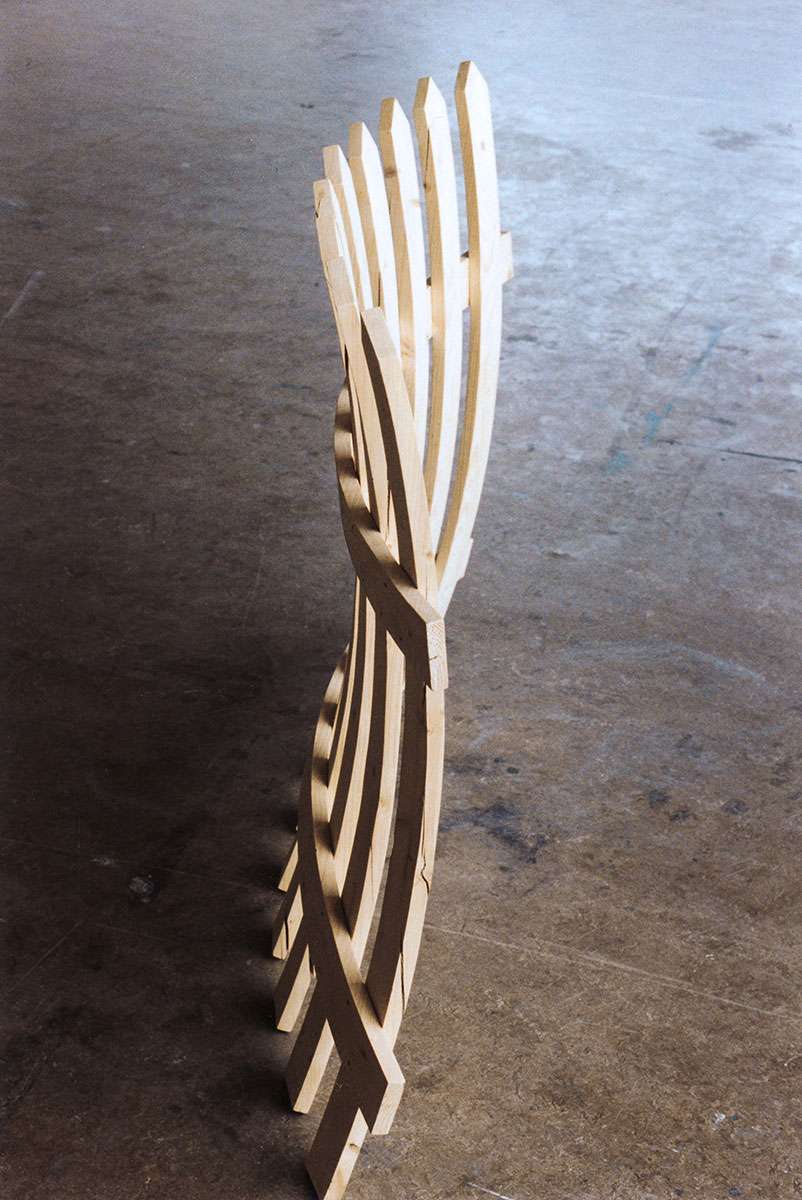
'A garden is an erotic situation between culture and nature.' (Ludger Gerdes, 1954-2008)







'A garden is an erotic situation between culture and nature.' (Ludger Gerdes, 1954-2008)
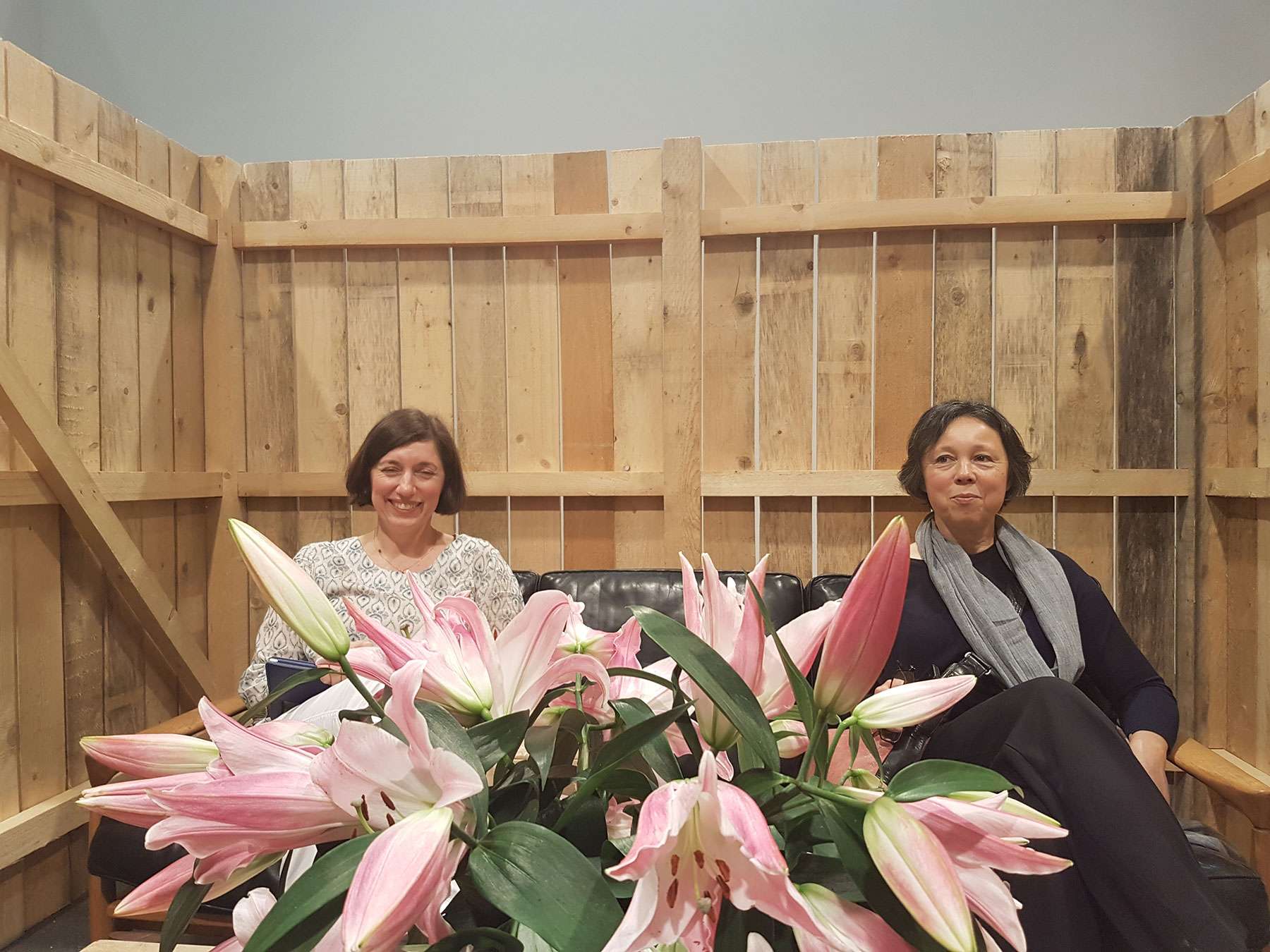 Sitting in a good fence, by artist Jim Hodges, 2008
Sitting in a good fence, by artist Jim Hodges, 2008
‘Gardens are by origin oases of peace and quiet, order and enjoyment in a chaotic and hostile world. Places where nature is kept out and at the same time made visible in water and coolness, fertile soil and a beautiful view (…)
The Dutch word for garden,’tuin’ comes from the word ‘teen’ meaning twig. The garden is an area enclosed by a fence of woven twigs (tenen in Dutch). Towards the landscape, the garden displays closed walls and in the garden the natural horizon is kept out and replaced by an internal horizon: the top edge of the fence. Within it, a wonderful paradise is depicted.’ (Rob Aben and Saskia de Wit)
Source: The enclosed garden: history and development of the hortus conclusus and its reintroduction in today’s city landscape, Rob Aben and Saskia de Wit, Rotterdam, Publisher 010, 1998, p. 10.
'The Arab-Islamic garden: garden = jannat = paradise' (Manar Hamad)
Source: Manar Hammad, ‘Earthly gardens, Heavenly gardens, gardens from elsewhere’, in: Heaven & Earth, Worlds of Imagination by Sorin Alexandrescu et al, Amsterdam, John Benjamins Publishing Company, 1991, p. 100. Catalogue by exhibition of the same name in the Bonnefanten museum in Maastricht.
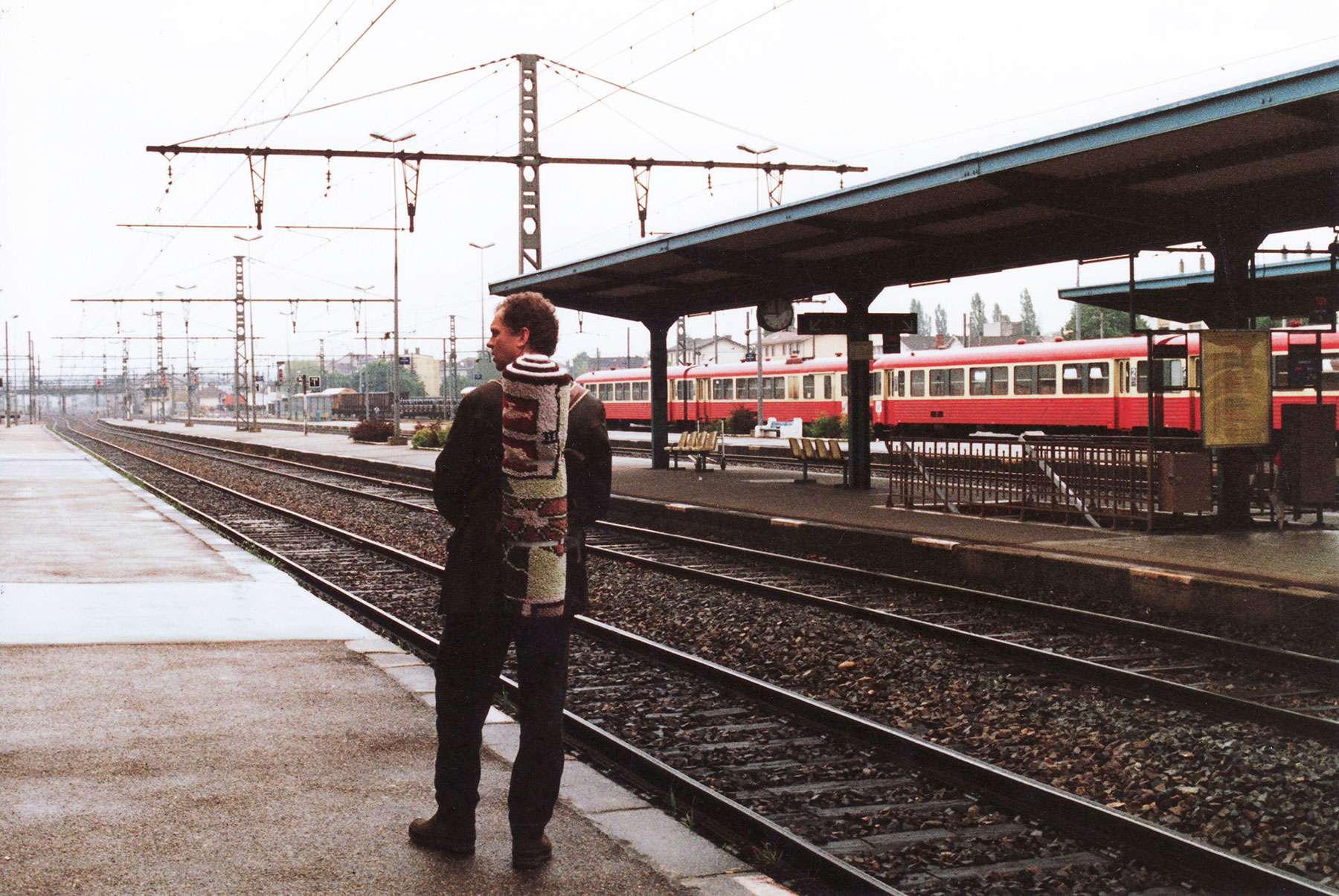
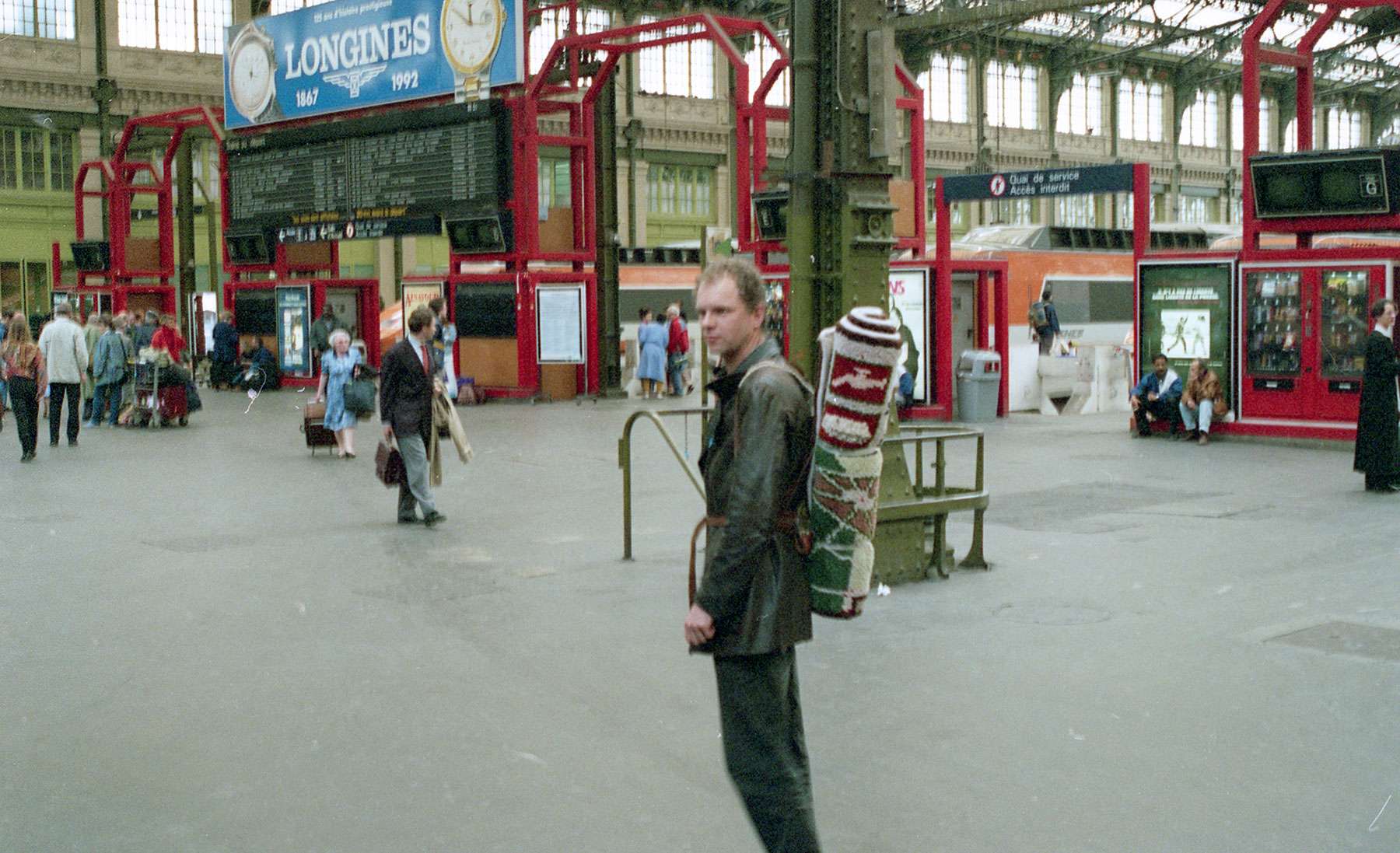
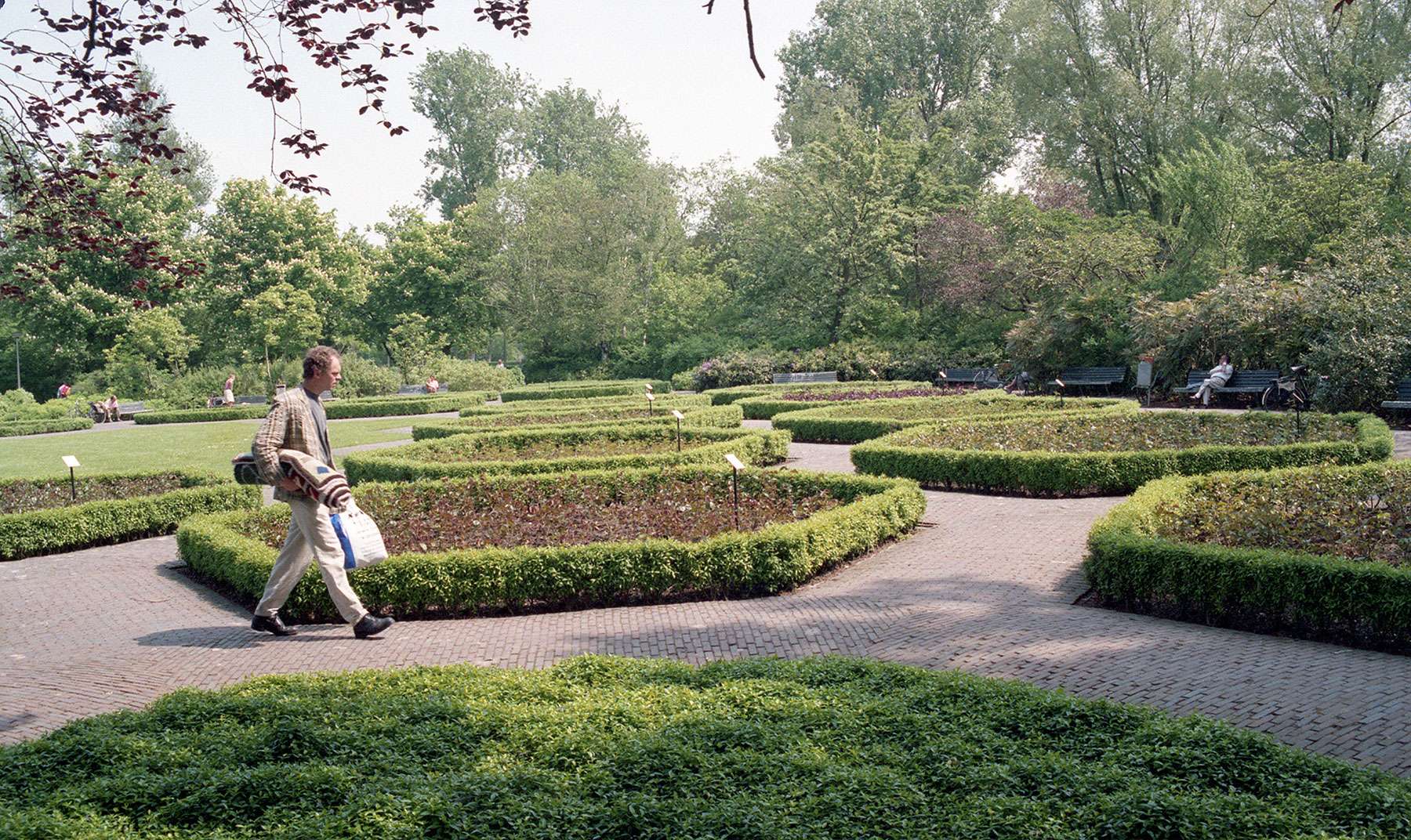
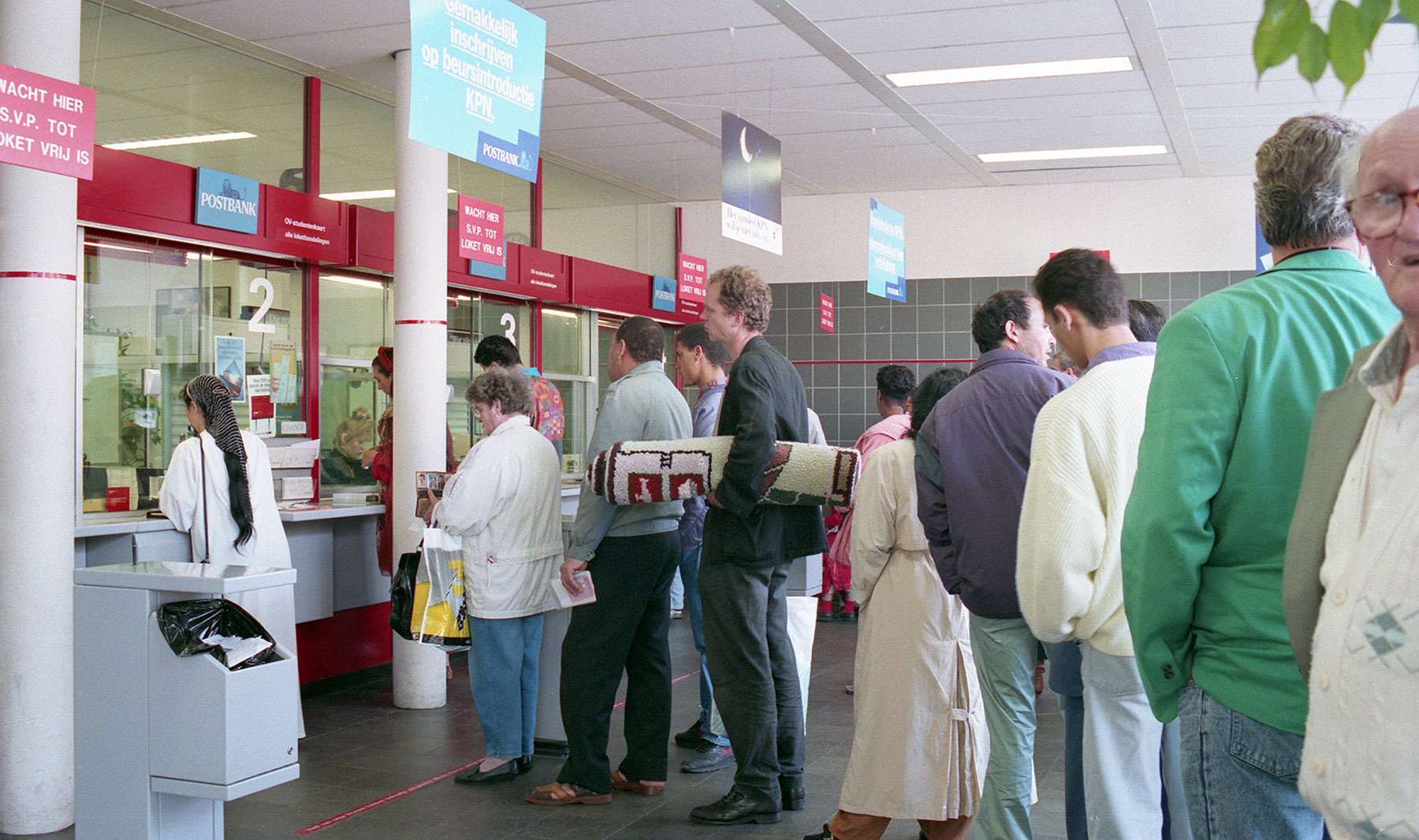
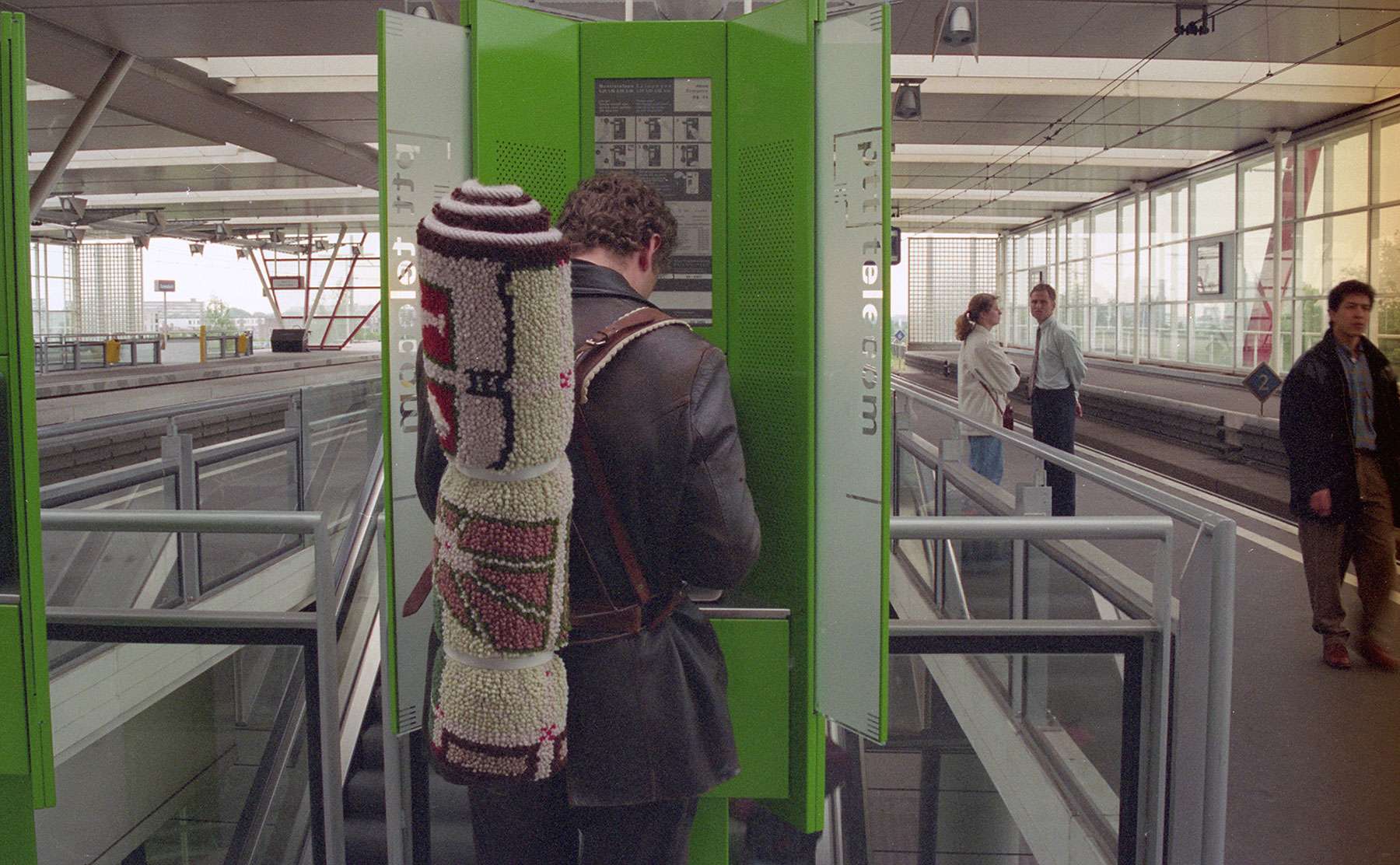
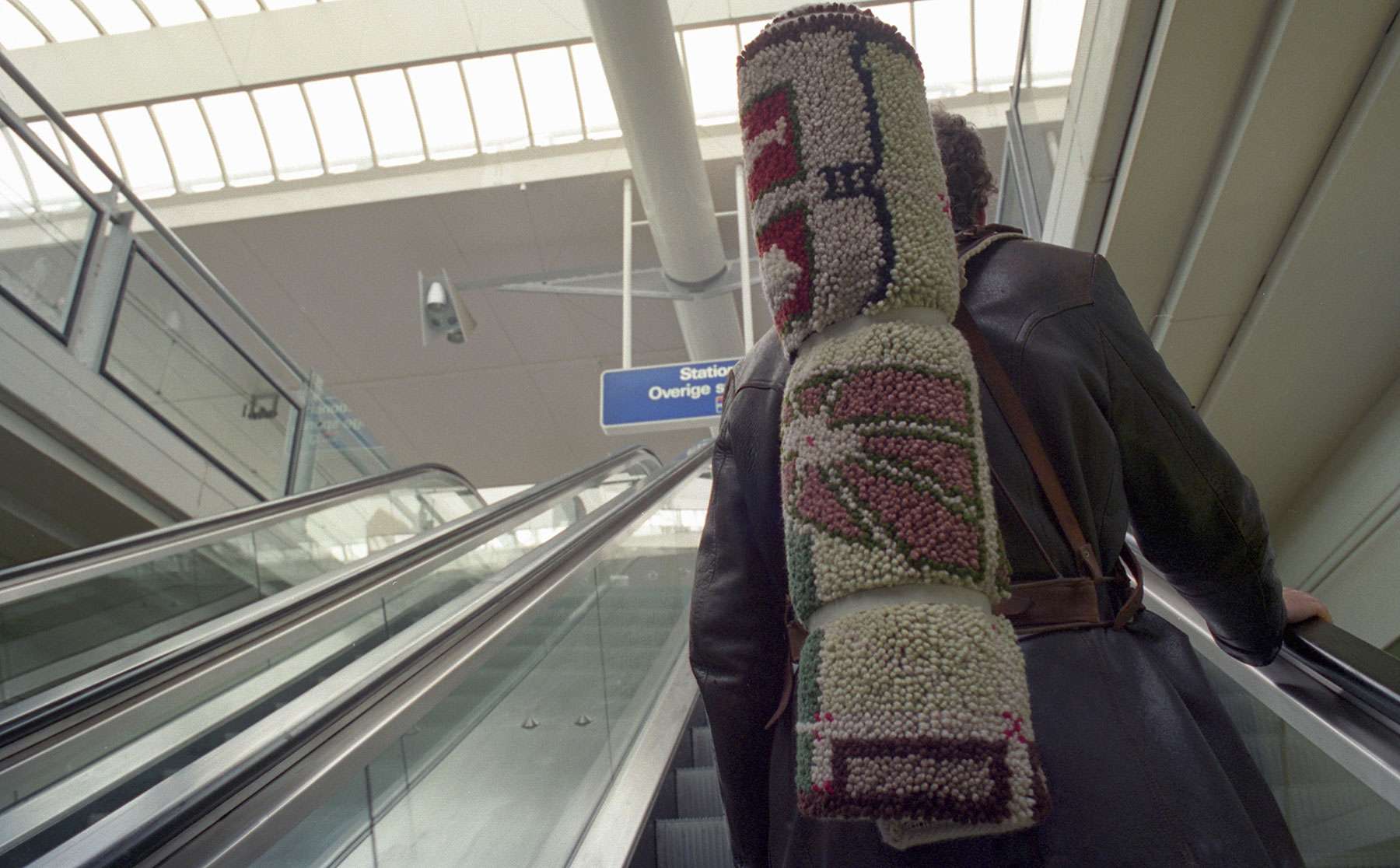
“But what really makes the carpet extraordinary, is its mobility. All you have to do is roll up this garden and put it on the back of an animal, and set it up as a protected and trusted world elsewhere.” (Manar Hammad).
Read more
Garden and carpet
“Some Arabian-Islamic gardens have become famous for their beauty, freshness, serenity or luxury. We will not go into that in more detail within the limited context of this essay. We prefer to discuss in more detail a type of garden that is endowed with an unexpected feature: mobility. The carpet (the normal, not the flying) very often displays a plant décor that resembles the visual image of a garden. In addition, through its boundaries and limited dimensions, it complies with one of the fundamental conditions of the garden. Because of its place between man and soil a carpet achieves, in the true sense, the mesological relationship.
Through the effect of isolation, that it guarantees (against the cold of the earth in the winter and against its hardness throughout the year), the carpet contributes to the effect of the necessary demarcation of the garden. But what really makes the carpet extraordinary, is its mobility. All you have to do is roll up this garden and put it on the back of an animal, and set it up as a protected and trusted world elsewhere. In fact, what is best achieved, is the non-verbal denial of a change of location. The nomad creates a home wherever he takes his carpet. He re-creates his home through recreating the fencing and the floor. All he needs are a few extra carpets to create partition walls that block the view of the landscape, and possibly a carpet from which to make a roof.
The stabilization of the relocated environment strongly influences the degree of continuity of the relationship between man and his direct, personal environment. She powerfully illustrates an implied idea that until now remained implicit.
The reference system of the garden is man. The garden is designed and created for him. The nomads move their carpets to provide him with his garden in the immense empty steppe, on the plains that have been flattened by the wind, in all his encampments..
(Source: Manar Hammad, ‘Earthly gardens, Heavenly gardens, gardens from elsewhere’, in: Heaven & Earth, Worlds of Imagination by Sorin Alexandrescu et al, Amsterdam, John Benjamins Publishing Company, 1991, p. 101-102. Catalogue by exhibition of the same name in the Bonnefanten museum in Maastricht.)

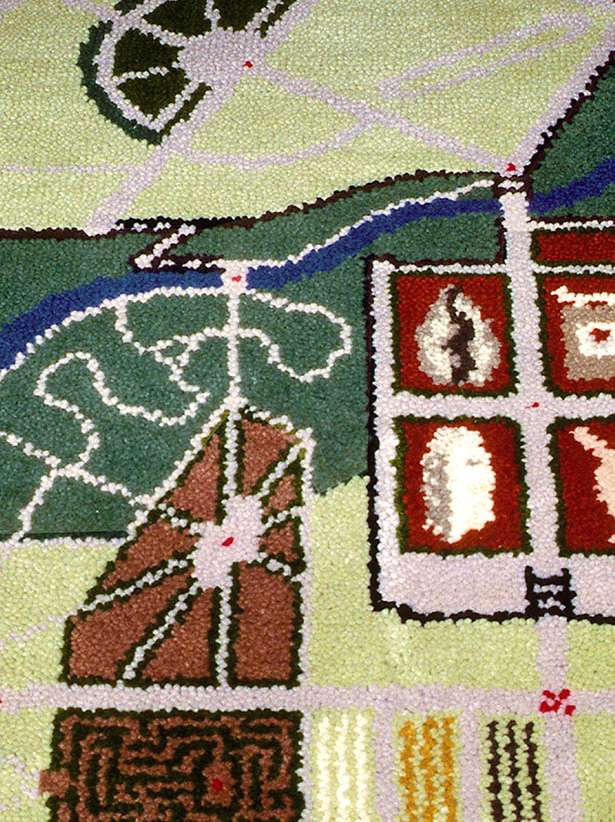
Greetings from Smyrna – portable garden / carpet of knotted wool / 80x120cm / 1993
In my youth, we sometimes sat with the whole family around the kitchen table in the winter working on a large carpet. Our mother taught us how to make smyrna knots.
Smyrna wool originally came from the Greek Smyrna in Asia Minor (currently Turkish Izmir). With the smyrna method you knot with the aid of a smyrna needle short woollen strands according to a pattern onto a surface (master) with holes in it. Because of the length of the wool threads and the use of the Gregorian knot the threads stay upright. The smyrna-weave resembles an embroidery surface: a chequered pattern with holes of tough, wear-resistant material.
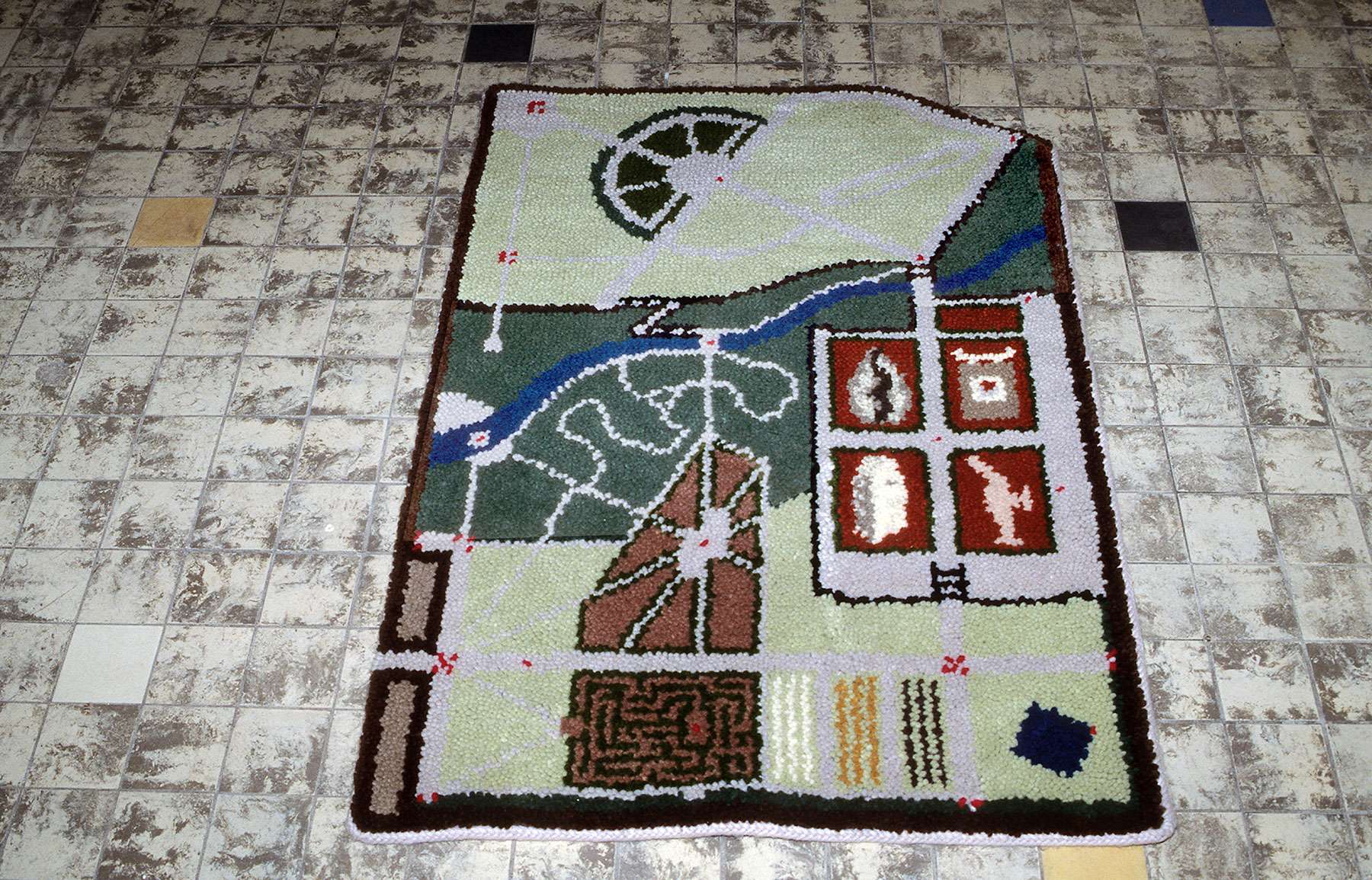 Greetings from Smyrna – portable garden / carpet of knotted wool / 80x120cm / 1993
Greetings from Smyrna – portable garden / carpet of knotted wool / 80x120cm / 1993
Greetings from Smyrna is a small woollen carpet of 80x120 cm that was made according to the smyrna method. My mother’s hobby combined with the old Eastern tradition of making carpets with geometric patterns and garden motifs such as flowers, plants and animals. I thought up the plan of a fictional garden, like a modern-day Garden of Eden.

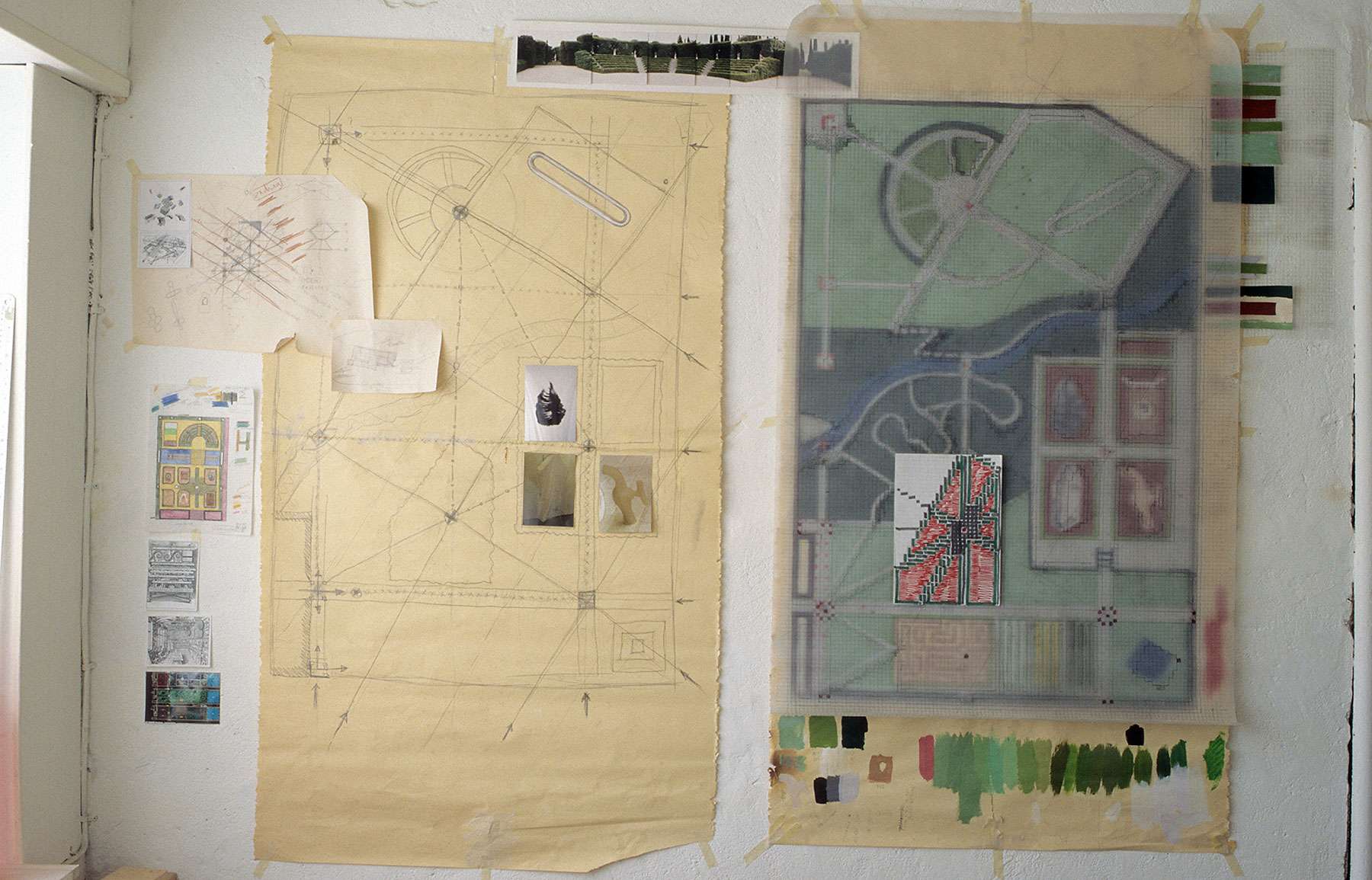 Sketches for Greetings from Smyrna – portable garden / carpet of knotted wool / 80x120cm / 1993
Sketches for Greetings from Smyrna – portable garden / carpet of knotted wool / 80x120cm / 1993
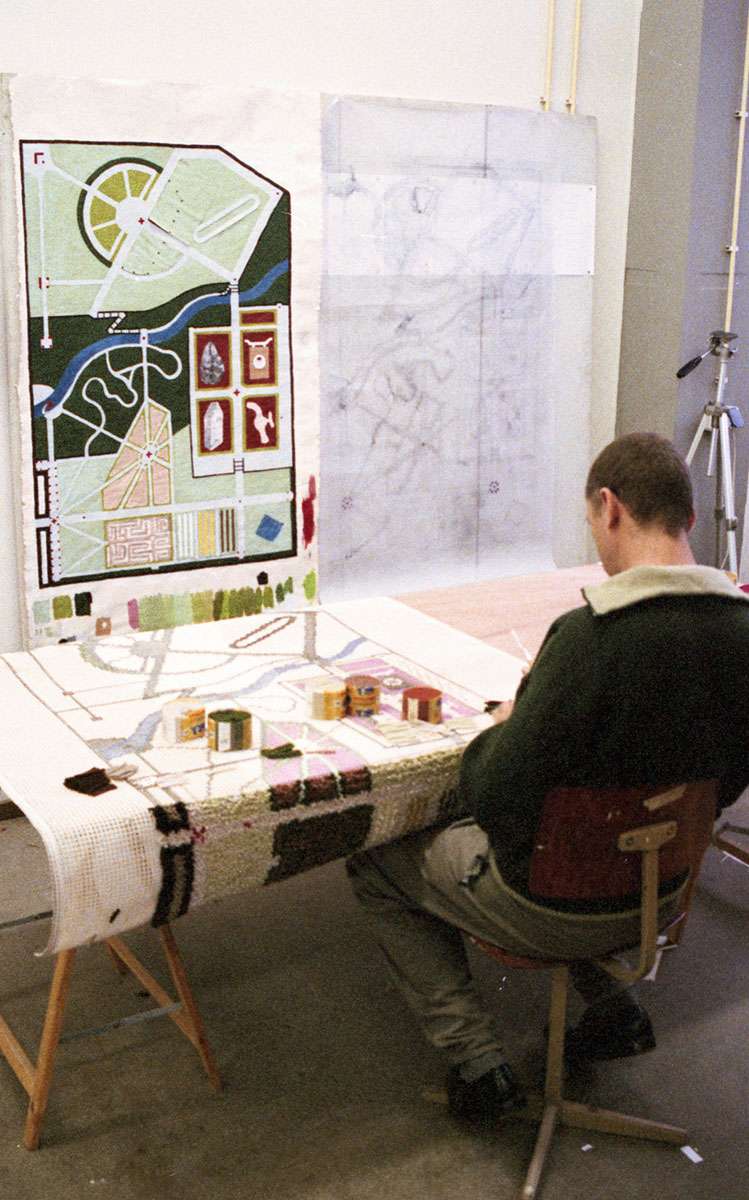
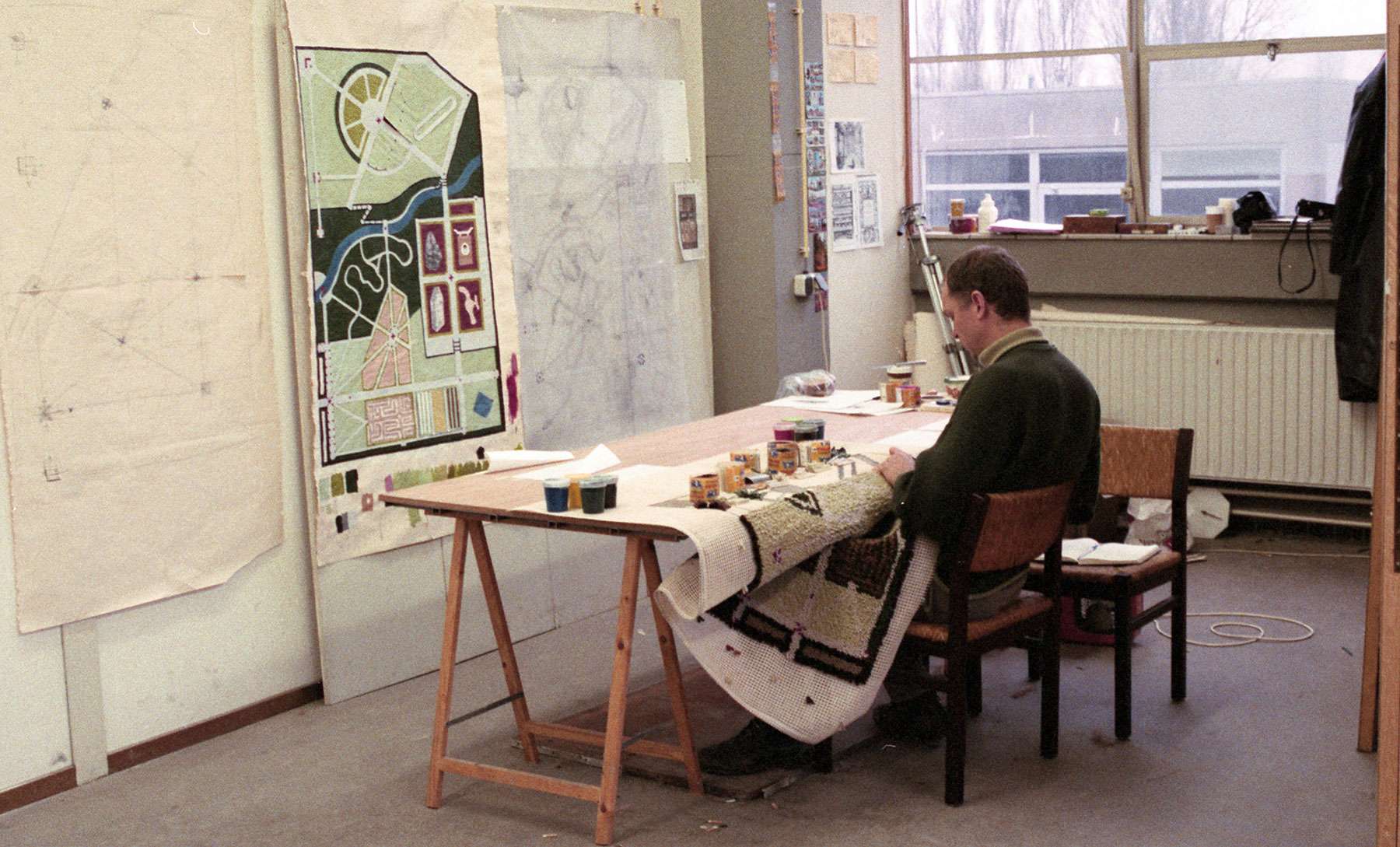 Knotting of Greetings from Smyrna – portable garden / carpet of knotted wool / 80x120cm / 1993 / photos JW
Knotting of Greetings from Smyrna – portable garden / carpet of knotted wool / 80x120cm / 1993 / photos JW
In the design, several layers of meaning can be distinguished:
- formal grid and form structures
- language and character structures
- organization structure
- historical development in garden and landscape culture
Designing the layout for Greetings from Smyrna – portable garden / carpet of knotted wool / 80x120cm / 1993
A gate takes you into the walled-in garden. Inside, the Early Renaissance garden, the English garden, the Art garden and the Modern garden all have their own place (partial gardens). Each partial garden has its own garden elements, such as the maze and the hortus conclusus in the Early Renaissance garden, the meandering path with the river in the English garden, the flower buxus beds inspired by works of art in the Art garden and the theatre and racecourse in the Modern garden.
Under the layout of the garden, there is a grid of imaginary horizontal, vertical and diagonal lines. Part of this is visible in the form of roads, paths and junctions. There are characteristic ‘signs’ or follies on these junctions.
A folly is a construction that is deliberately useless or bizarre. A folly is an unconventional building, generally unsuitable for housing or other functions. The most important goal is simply decoration.
In the past, follies were widely used for romantic additions to country estates and gardens. For instance, constructed ruins, grottos, fake chapels and so-called hermit dwellings were popular.
We find a newer form of follies, for example, in the Parc de la Villette in Paris, designed by Bernard Tschumi and set up in 1986. There are 26 red follies throughout the park, each with a different function.
Source: WikipediaThe carpet is an independent work, but it is also made to be carried around. On the move with your own garden, your own place. See also the following section Passage.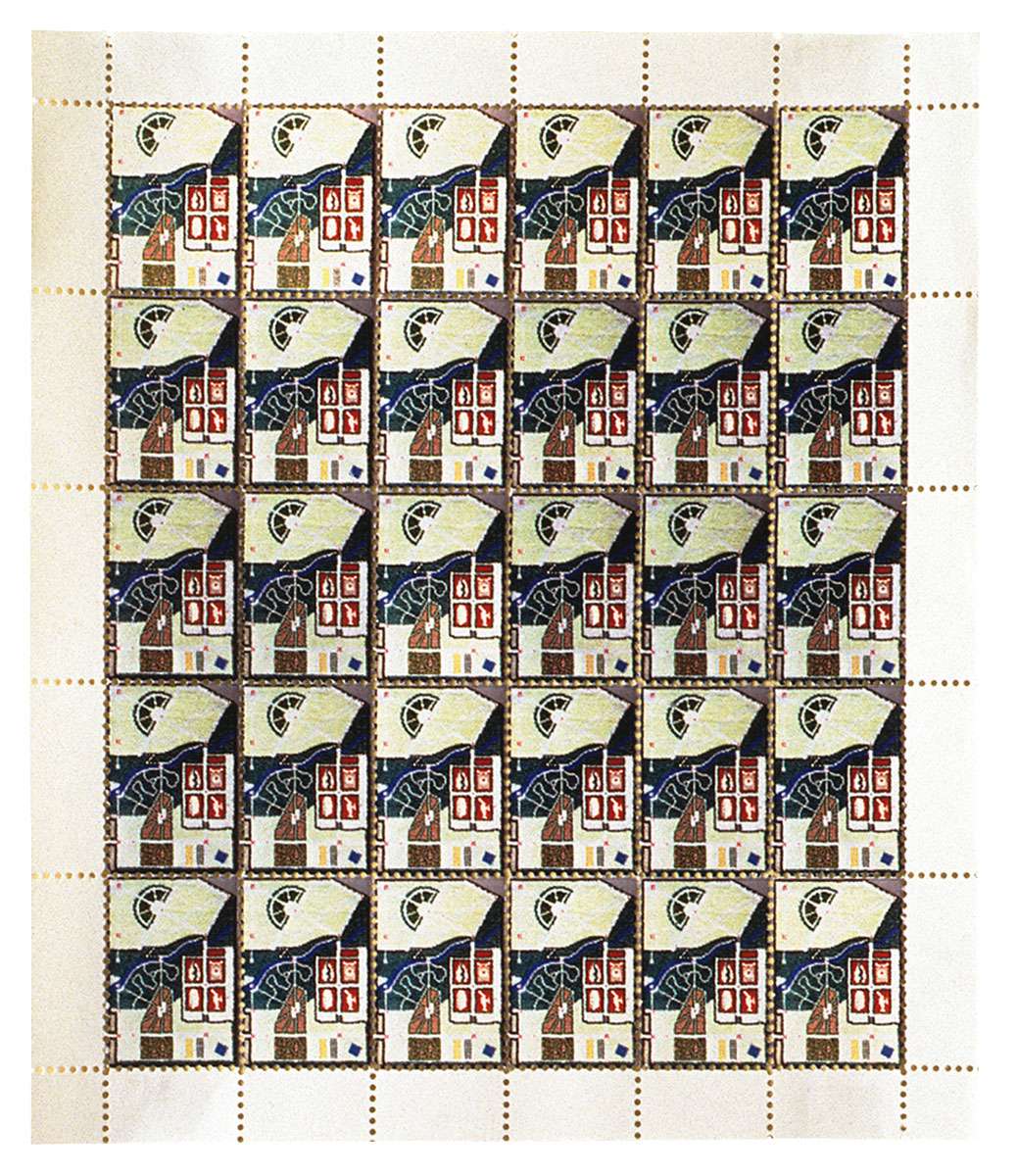 Greetings from Smyrna II – portable garden / sheet of perforated paper / 16x19cm / 1994
Greetings from Smyrna II – portable garden / sheet of perforated paper / 16x19cm / 1994
A picture of Greetings from Smyrna was used for producing a small edition of postage stamps. Stuck on a letter or card, this ‘small carpet’ goes out into the world. As was the case with the invitations to the exhibition, Passage.
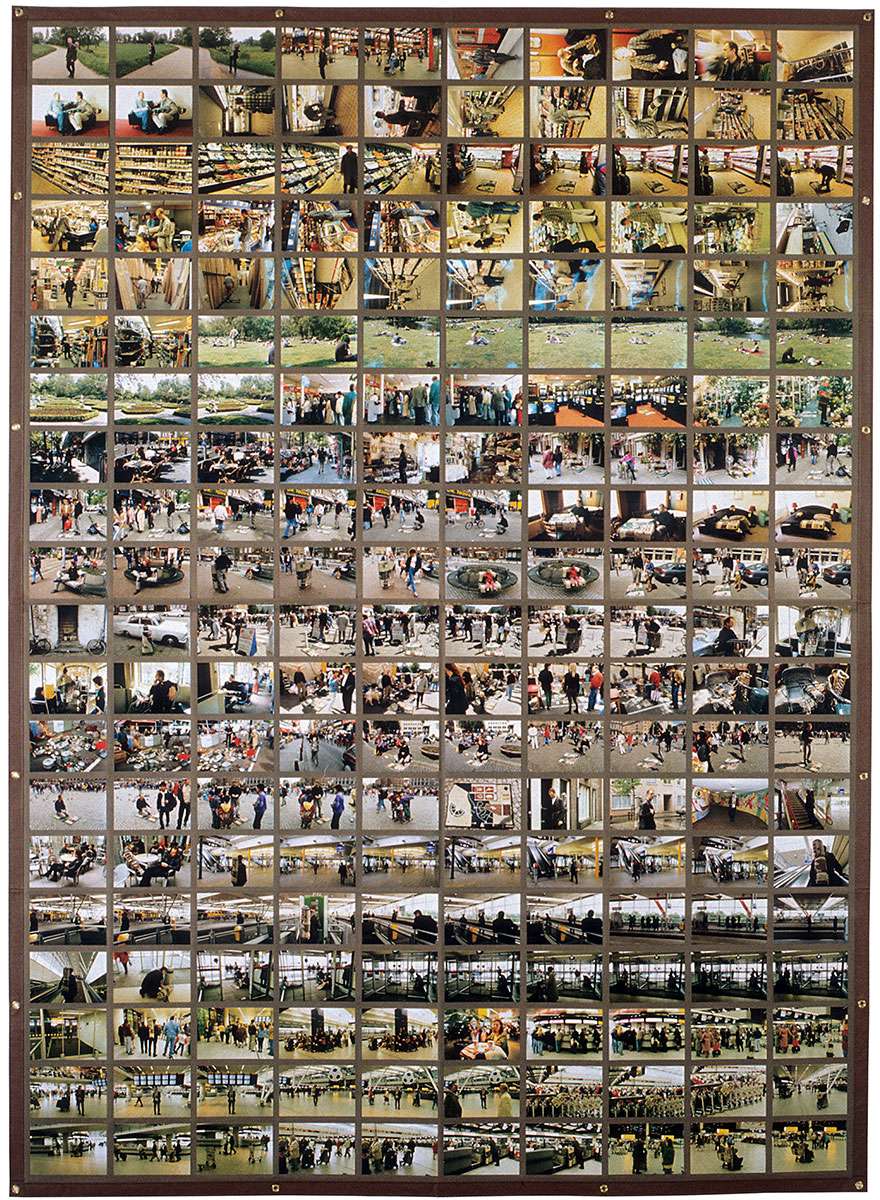
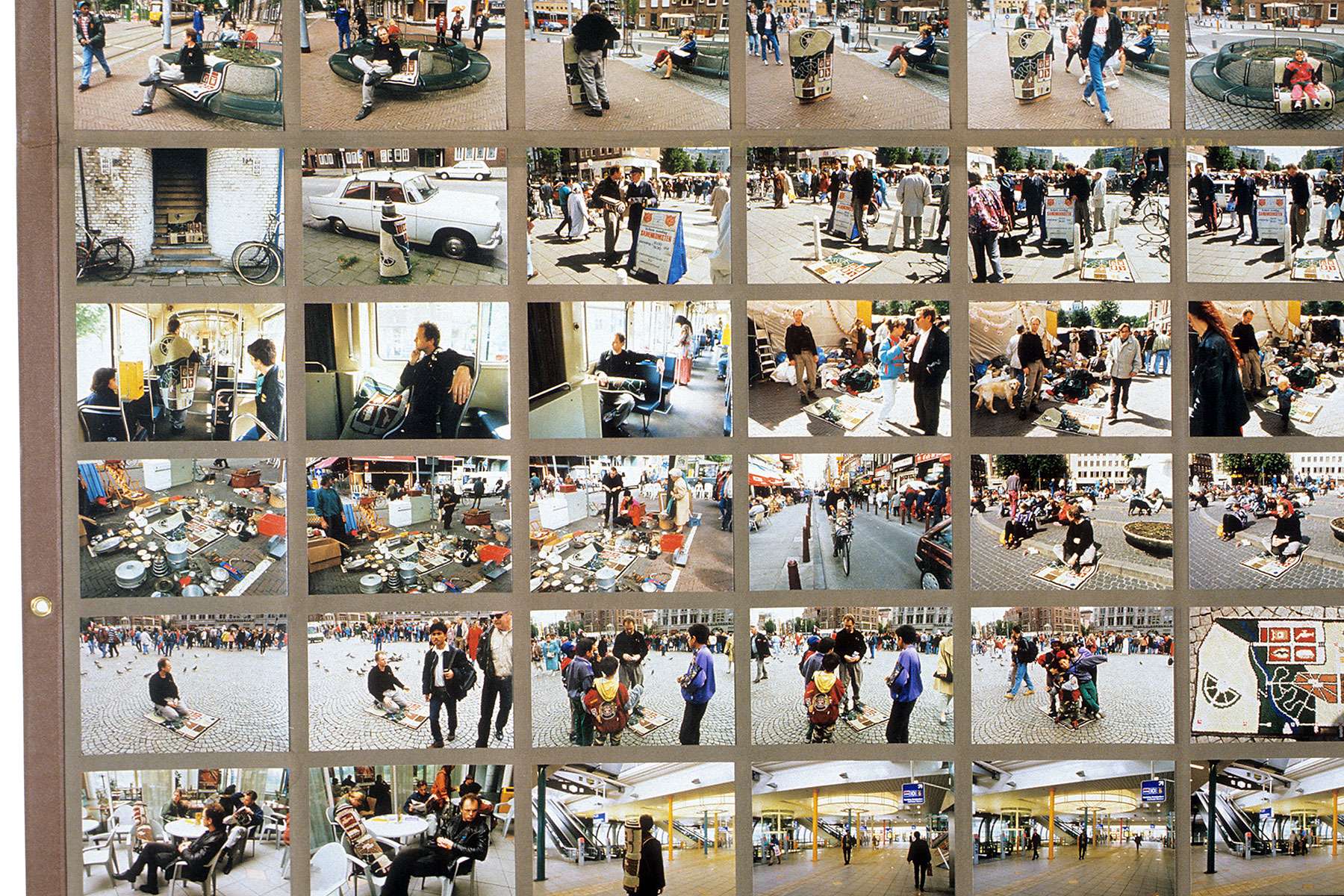

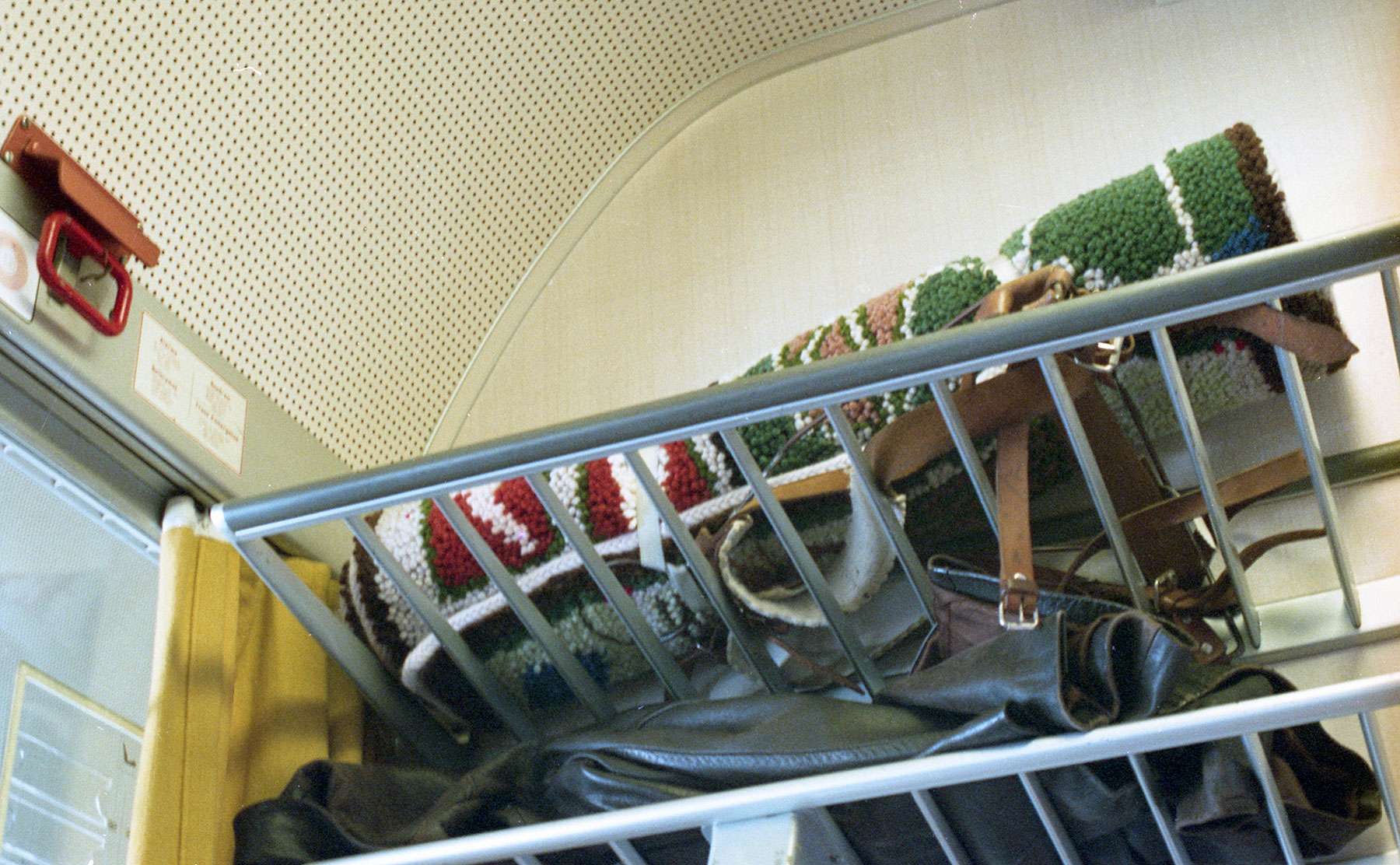
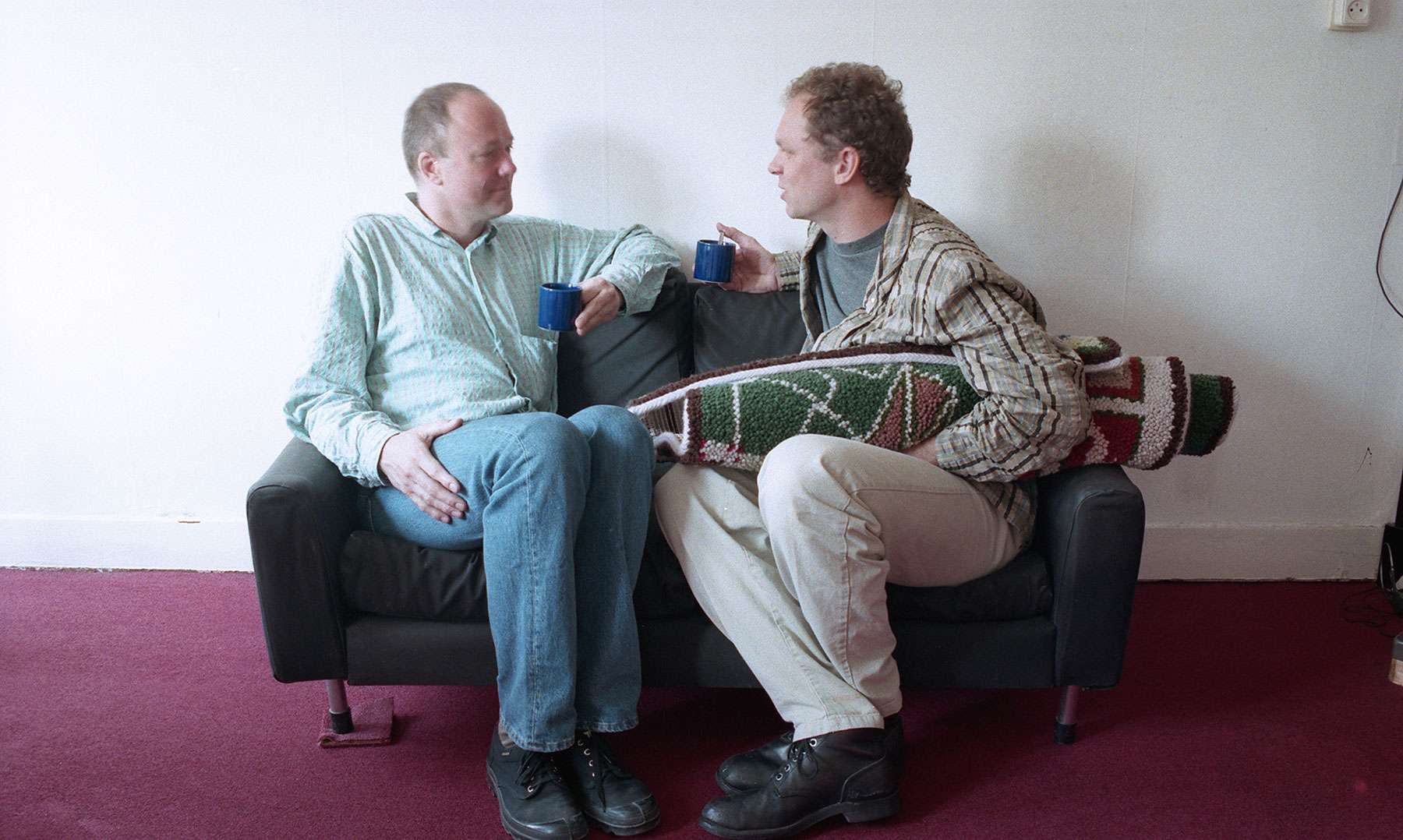
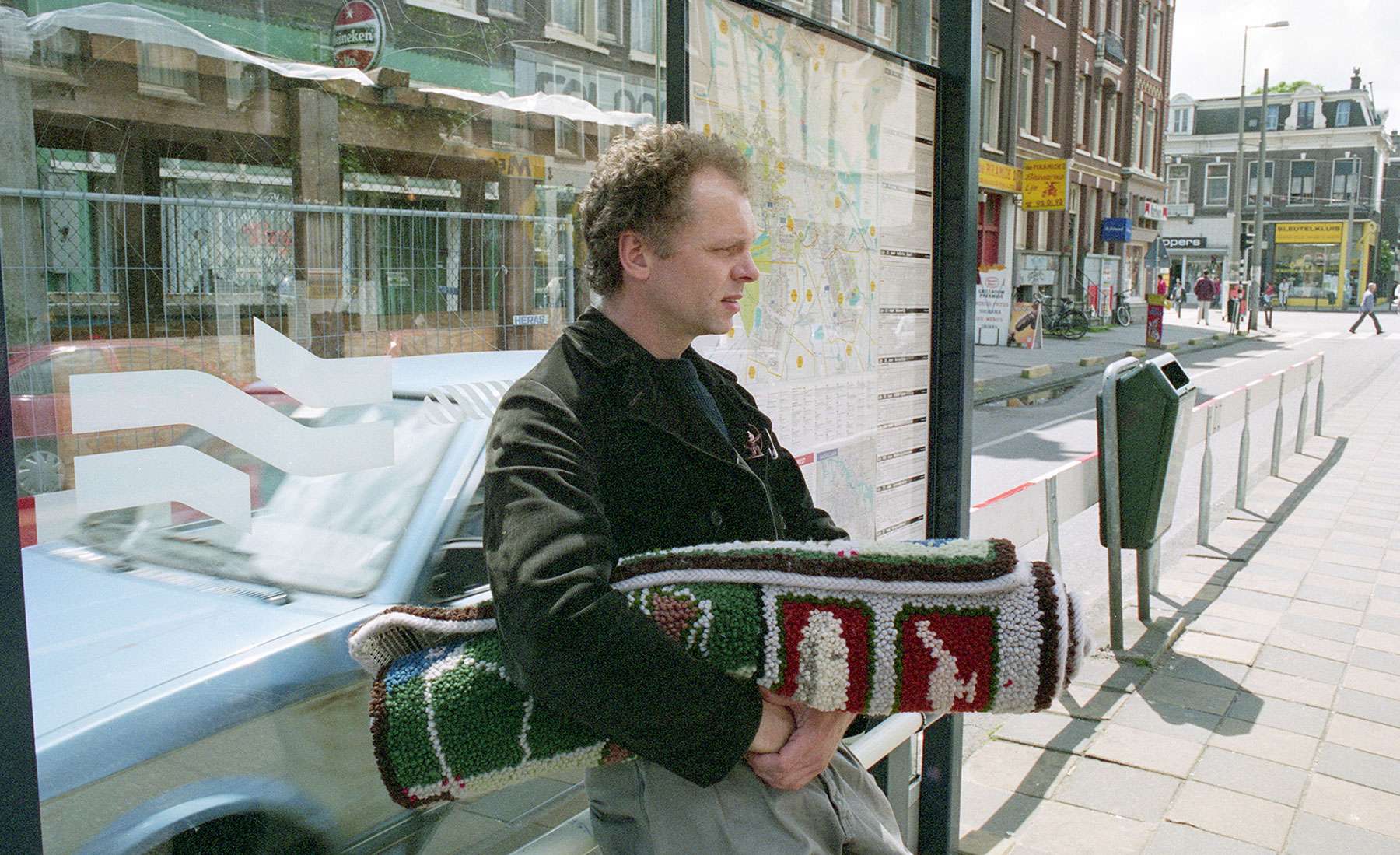
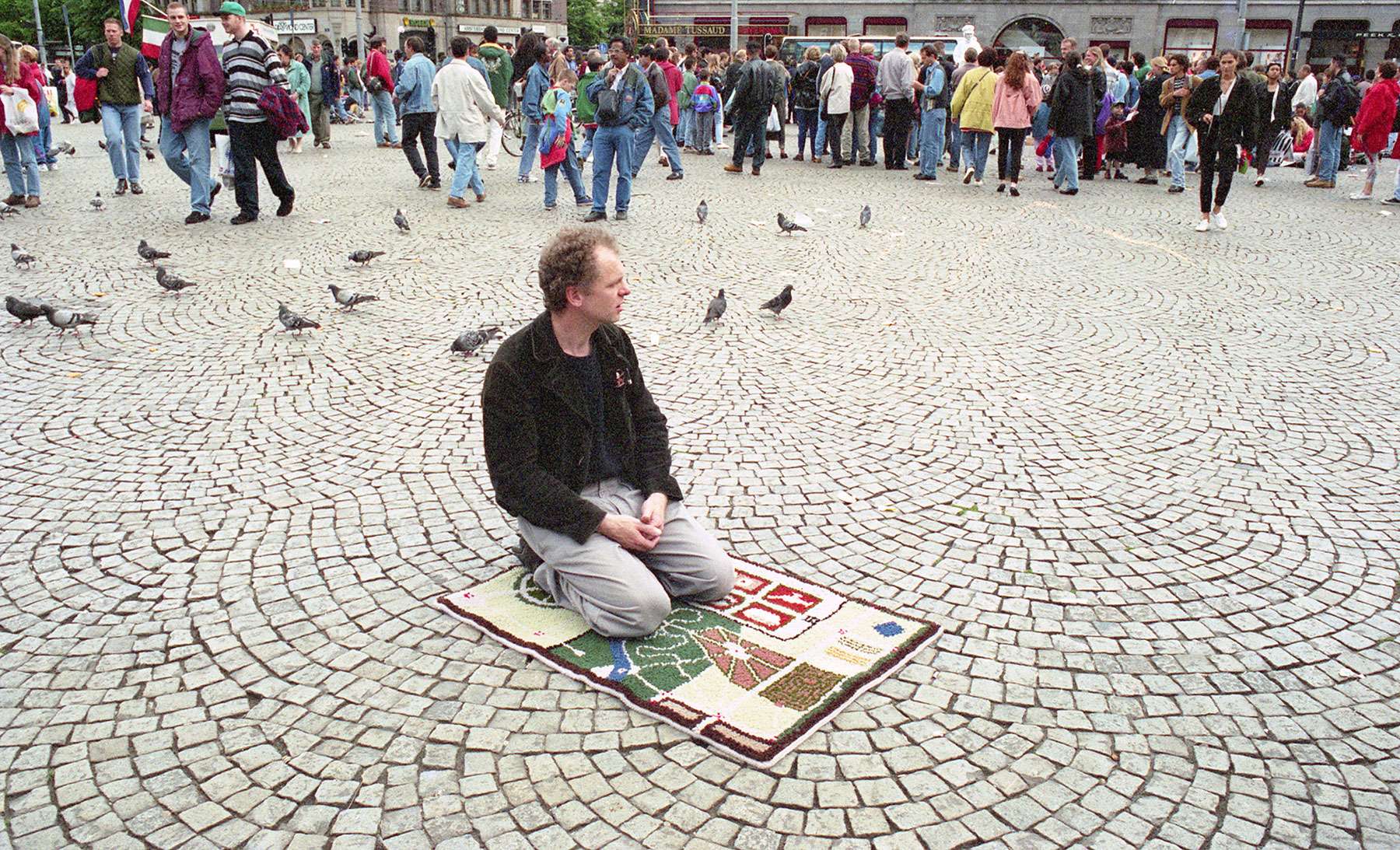
 Passage – portable garden / photos, suitcase cloth, metal rings / 172x237cm / 1994 / photos LSp, JW, AT
Passage – portable garden / photos, suitcase cloth, metal rings / 172x237cm / 1994 / photos LSp, JW, AT
I go out with the portable garden, Greetings from Smyrna, usually locally but also internationally. While I travel, I have my own area, my own portable garden with me. By putting down the carpet, I claim a spot for this garden and for myself. The next logical step is to stand, sit or lie in/on my own garden, or to invite people into or onto it.
In a modern variant, many people like to take a mobile ‘home with fitted carpet’ with them: the caravan.
A collage was made on foldable suitcase cloth of some of the photos taken, with the name: Passage – portable garden.
On the road with the carpet:
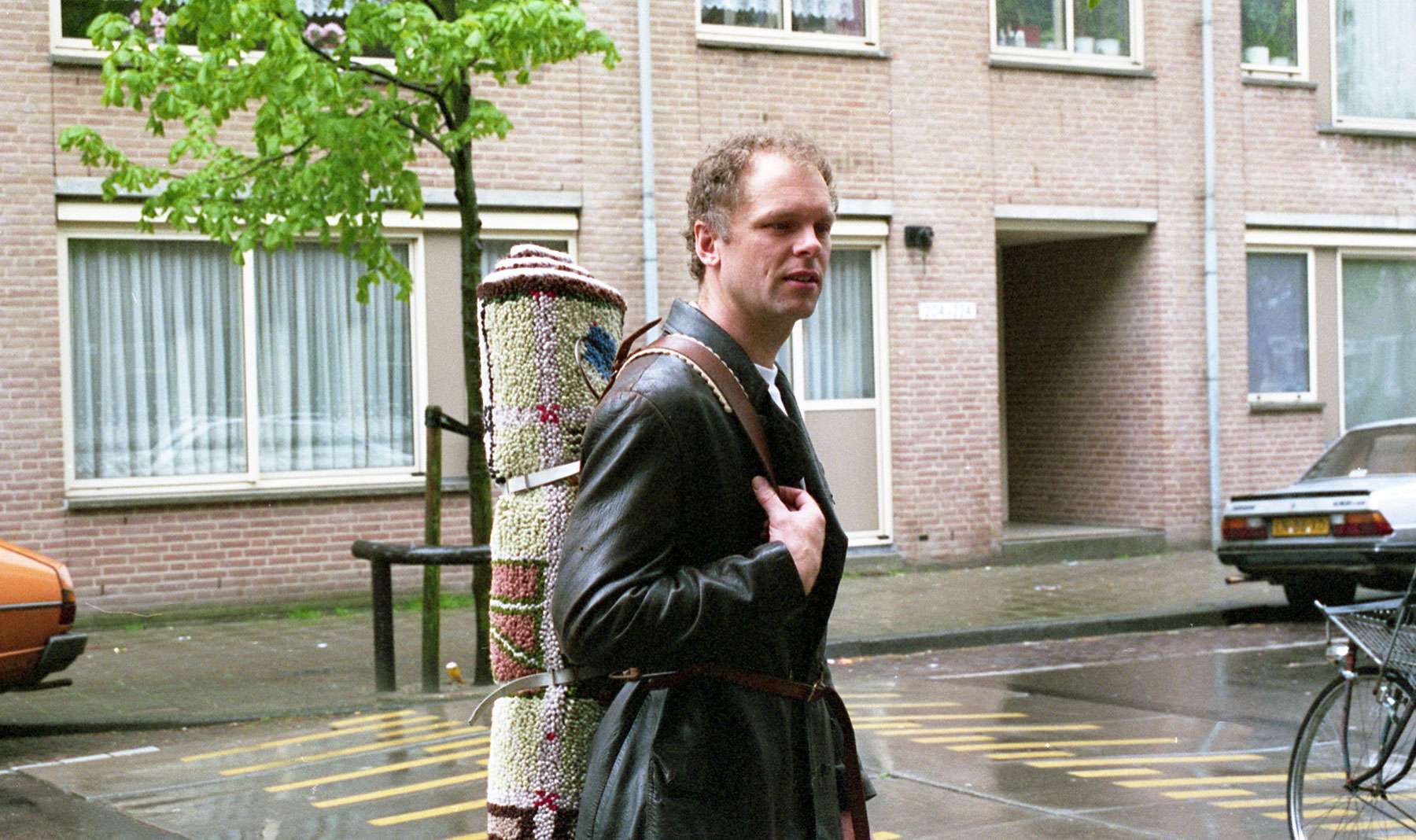
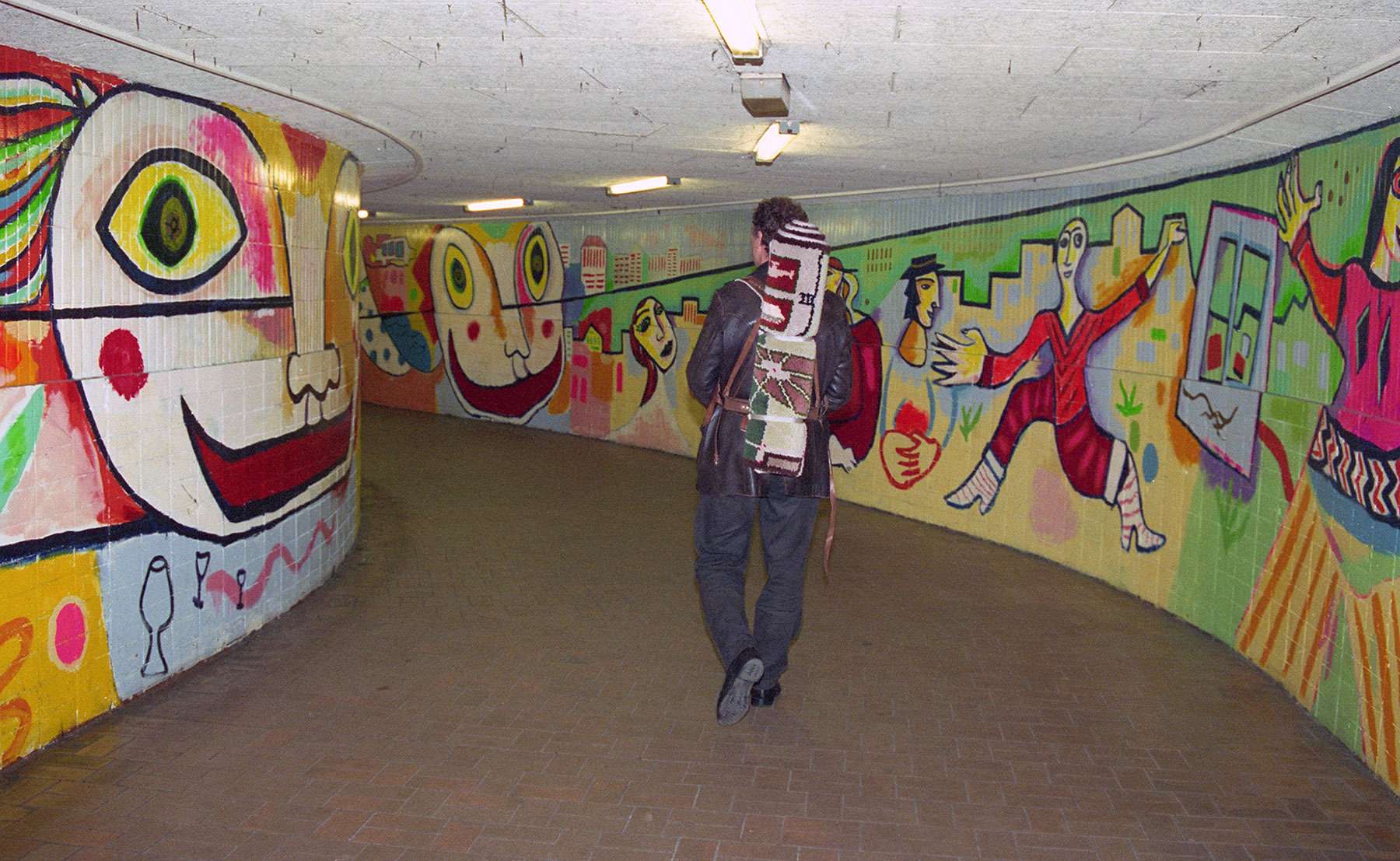
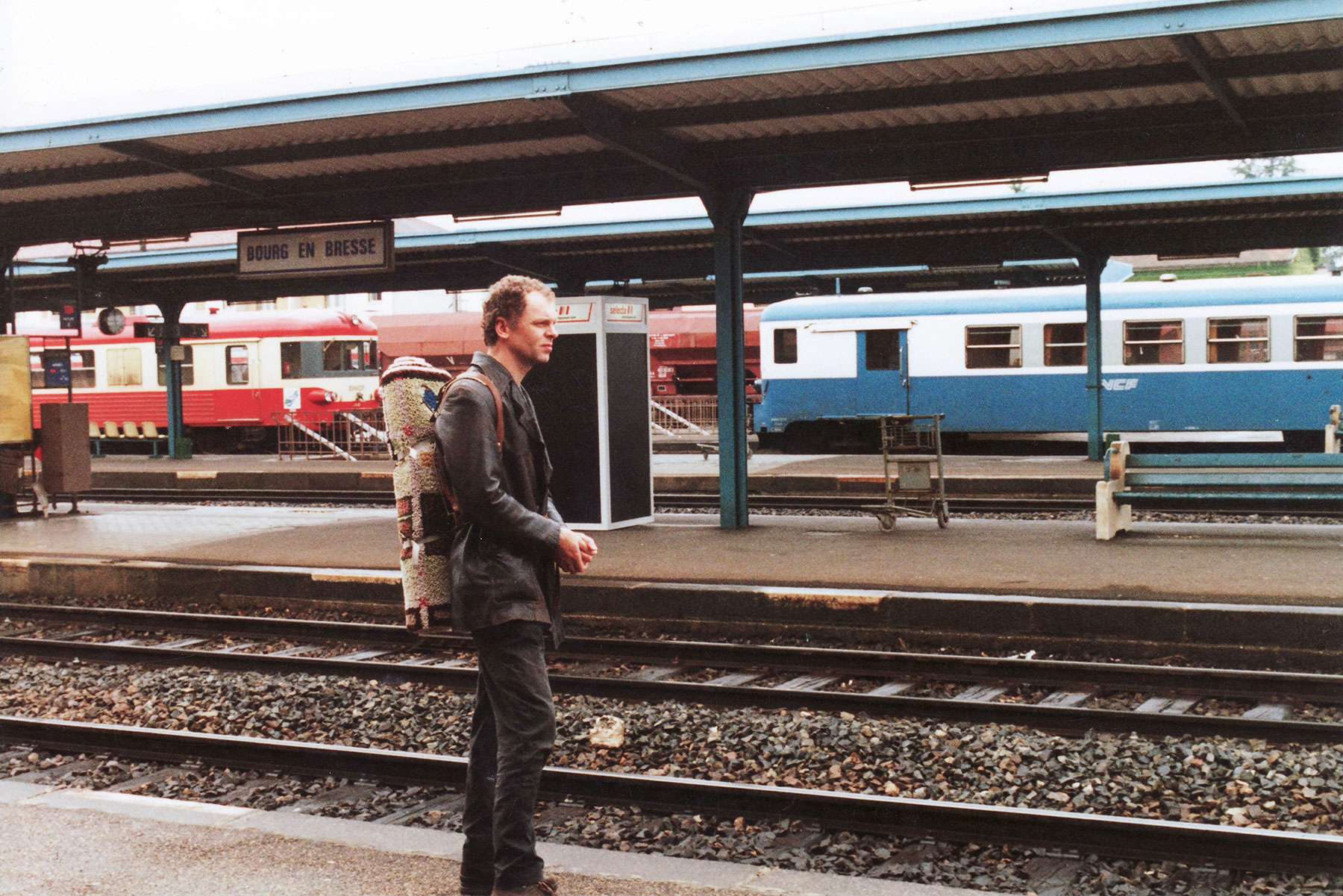

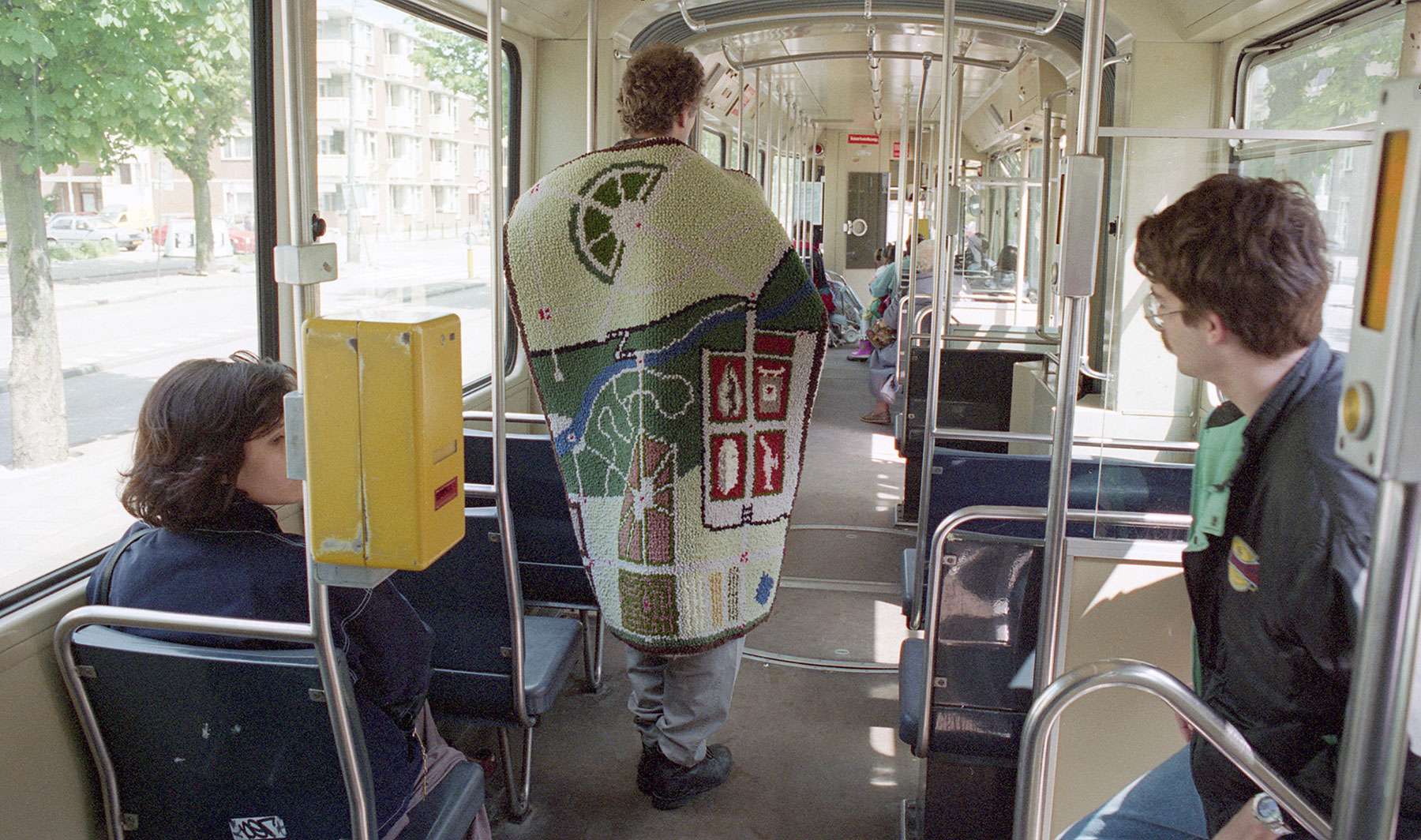 Parts of Passage – portable garden / photos, suitcase cloth, metal rings / 172x237cm / 1994 / photos LSp, JW, AT
Parts of Passage – portable garden / photos, suitcase cloth, metal rings / 172x237cm / 1994 / photos LSp, JW, AT
Take up space with the carpet:
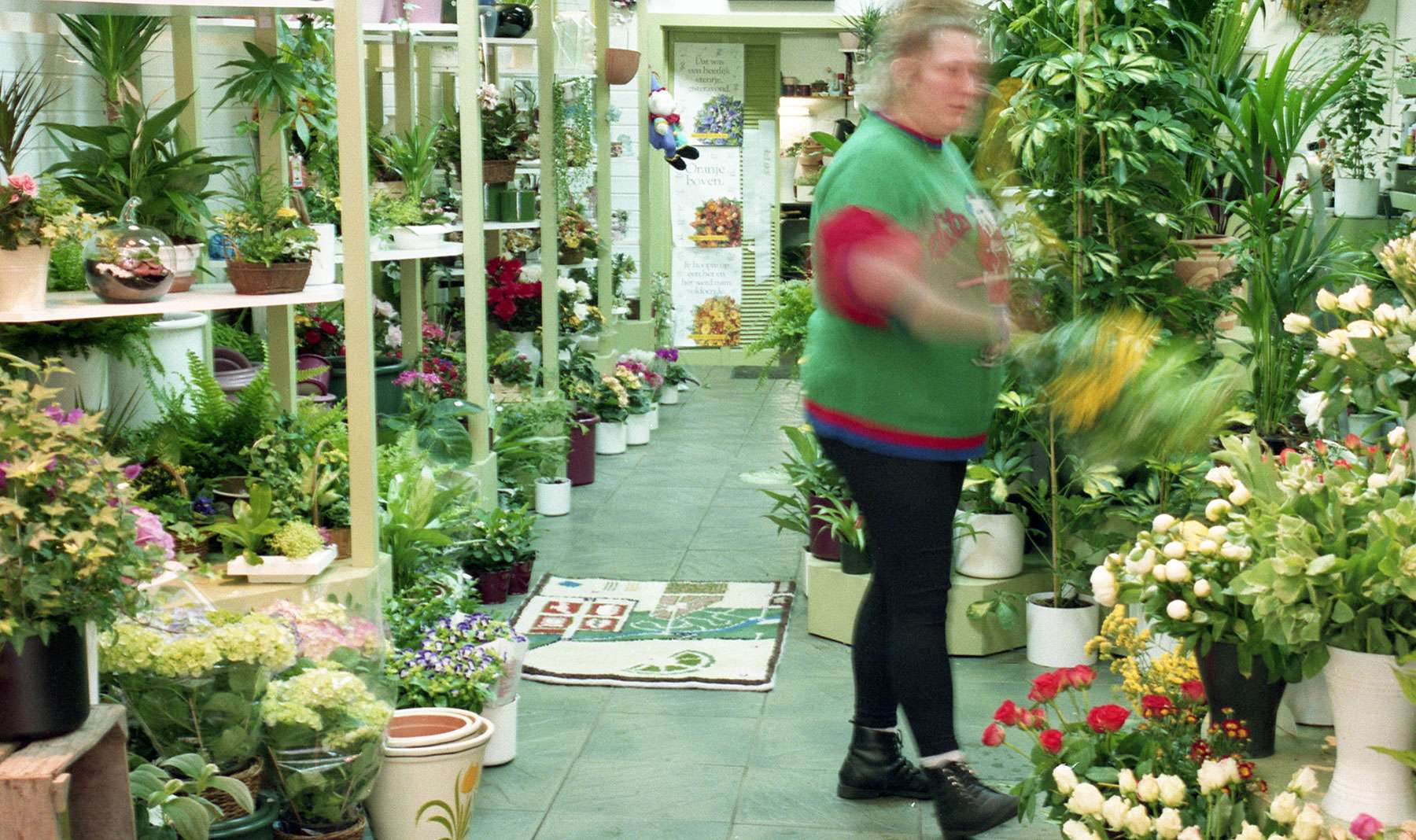
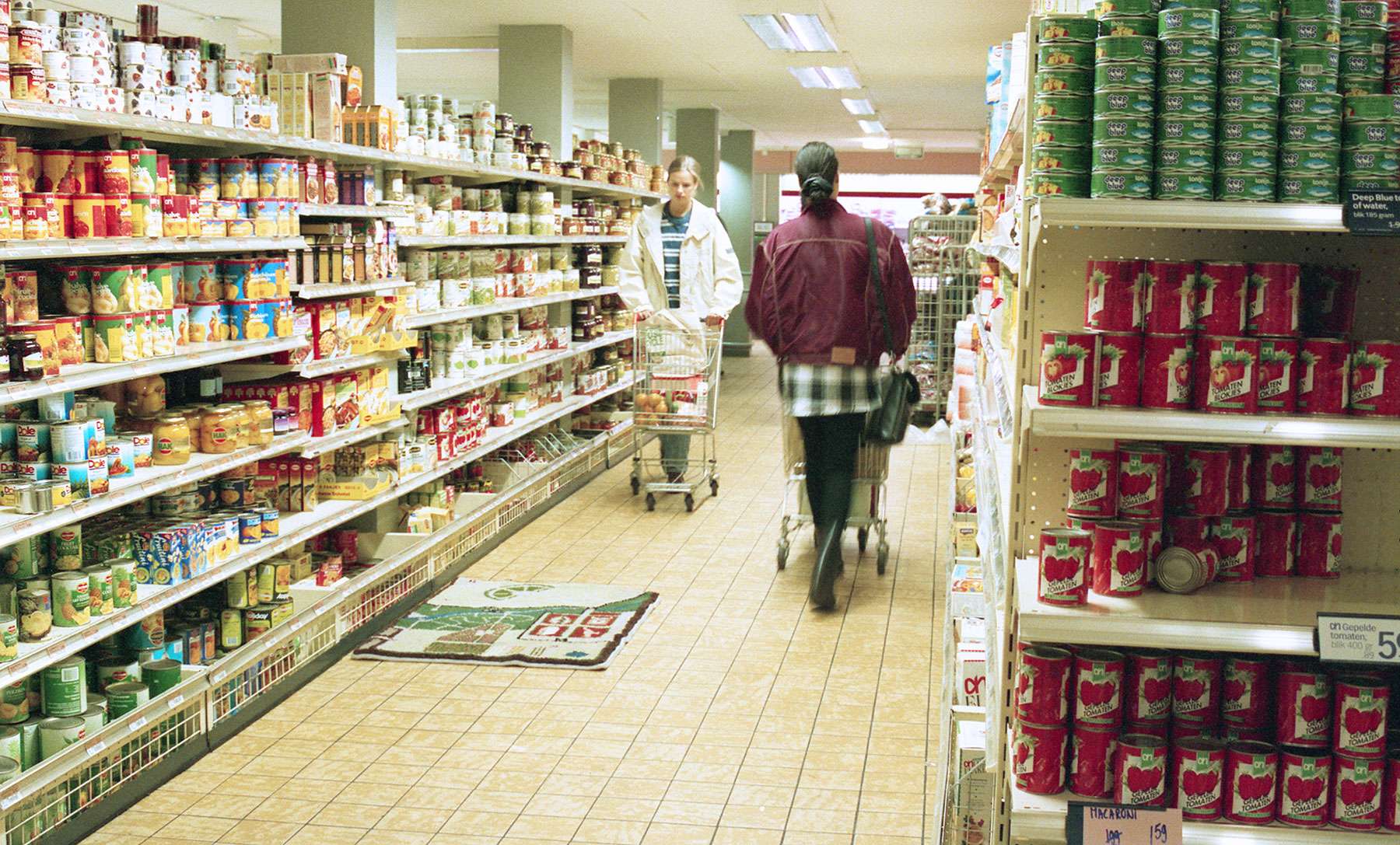
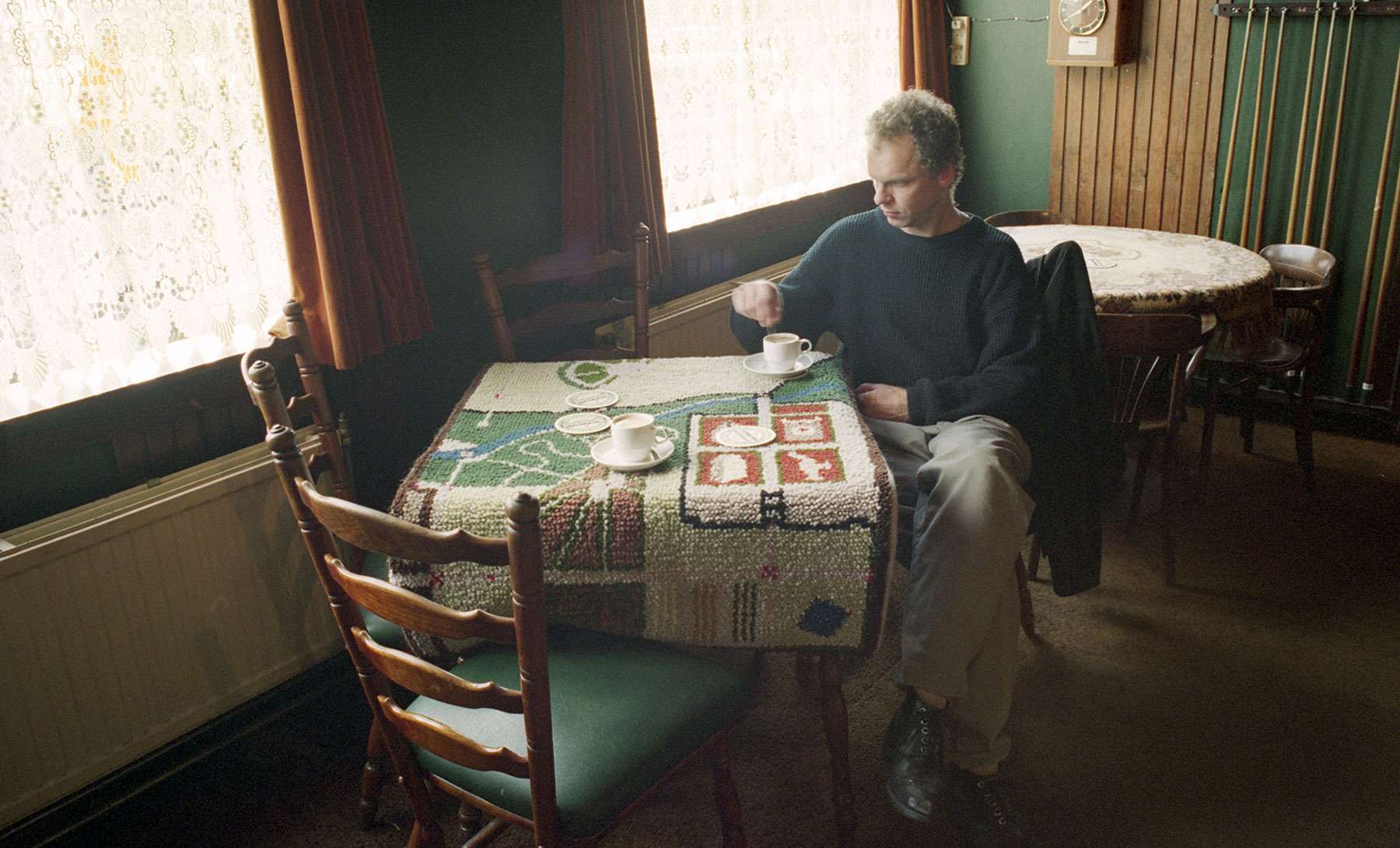
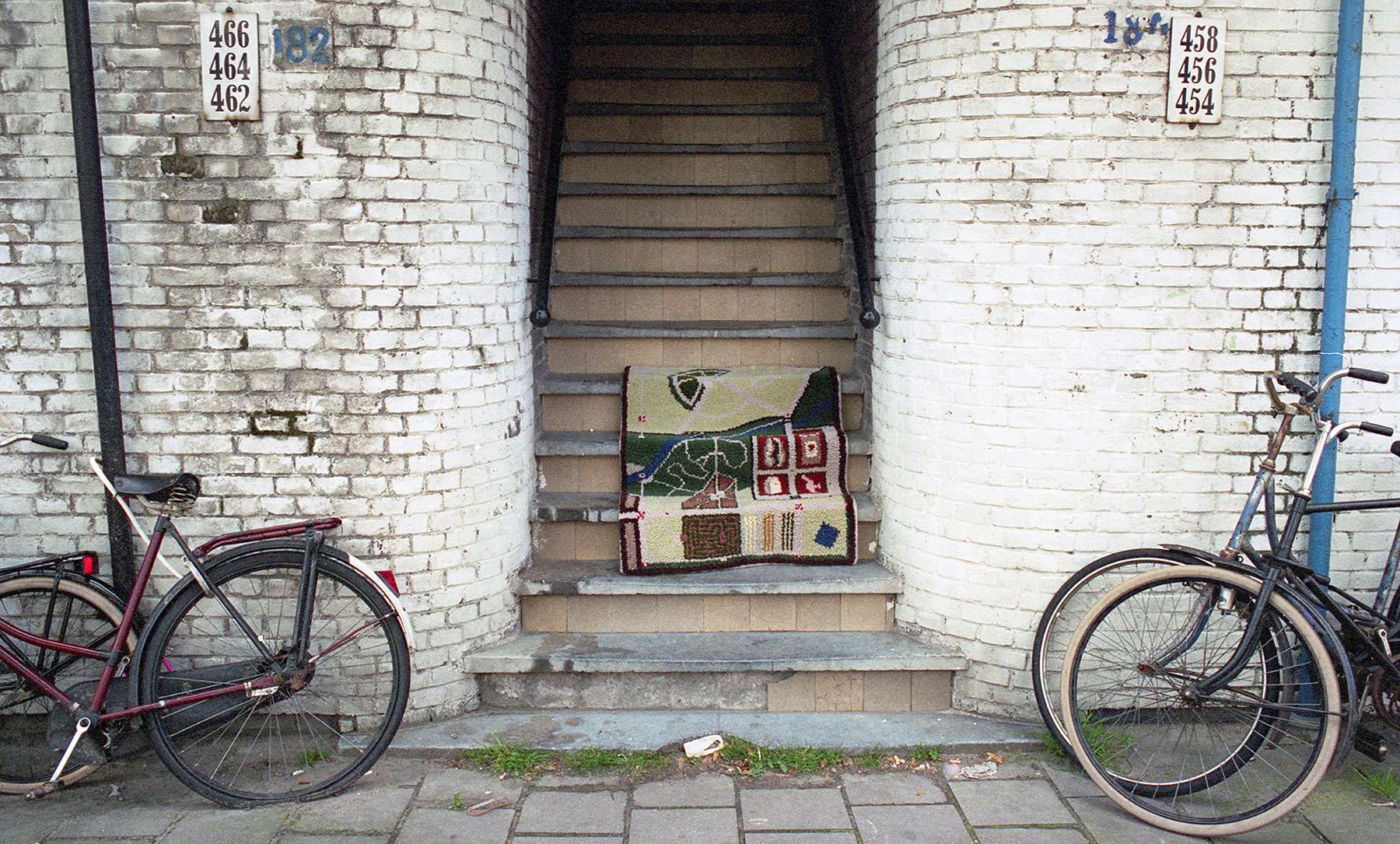
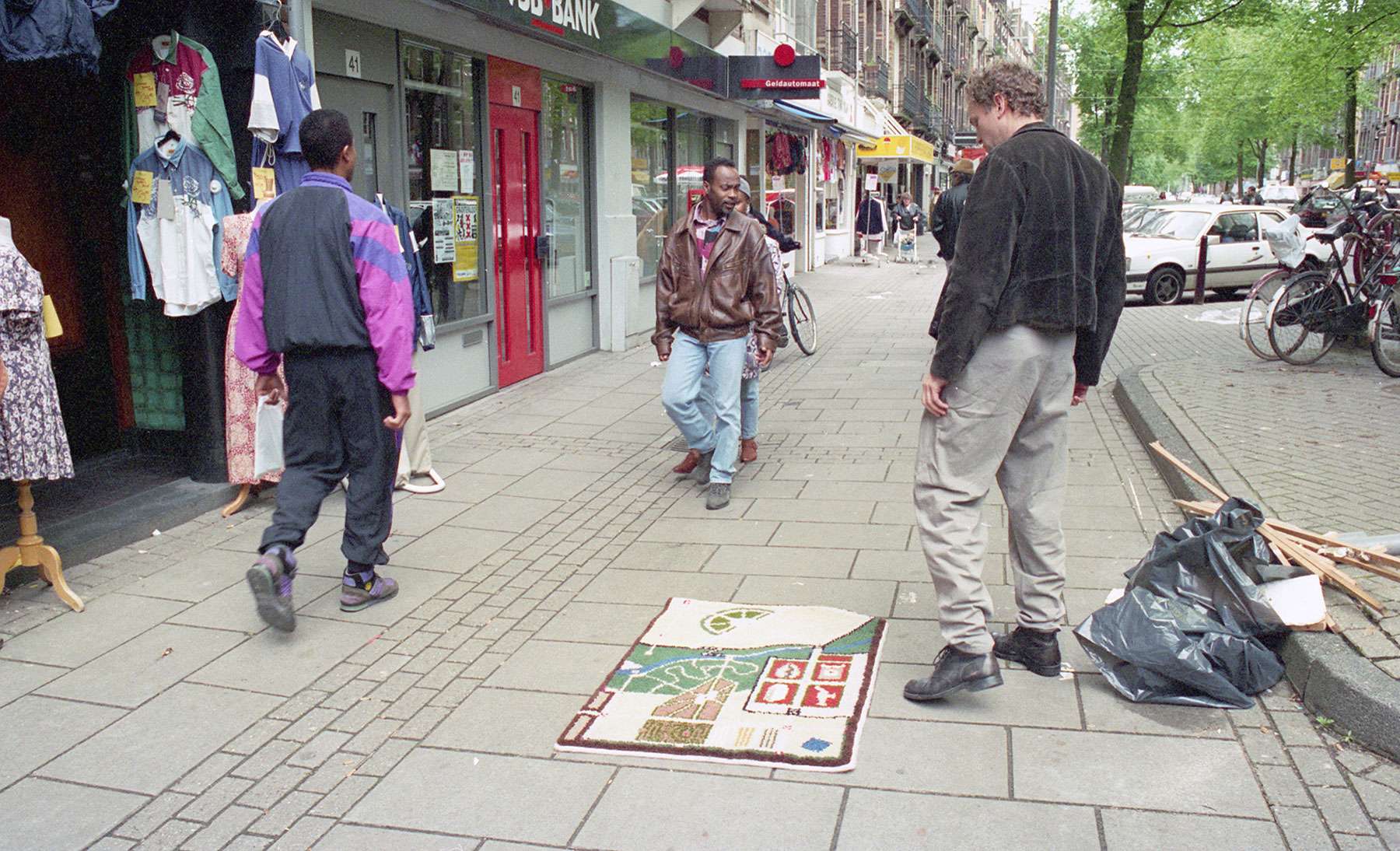
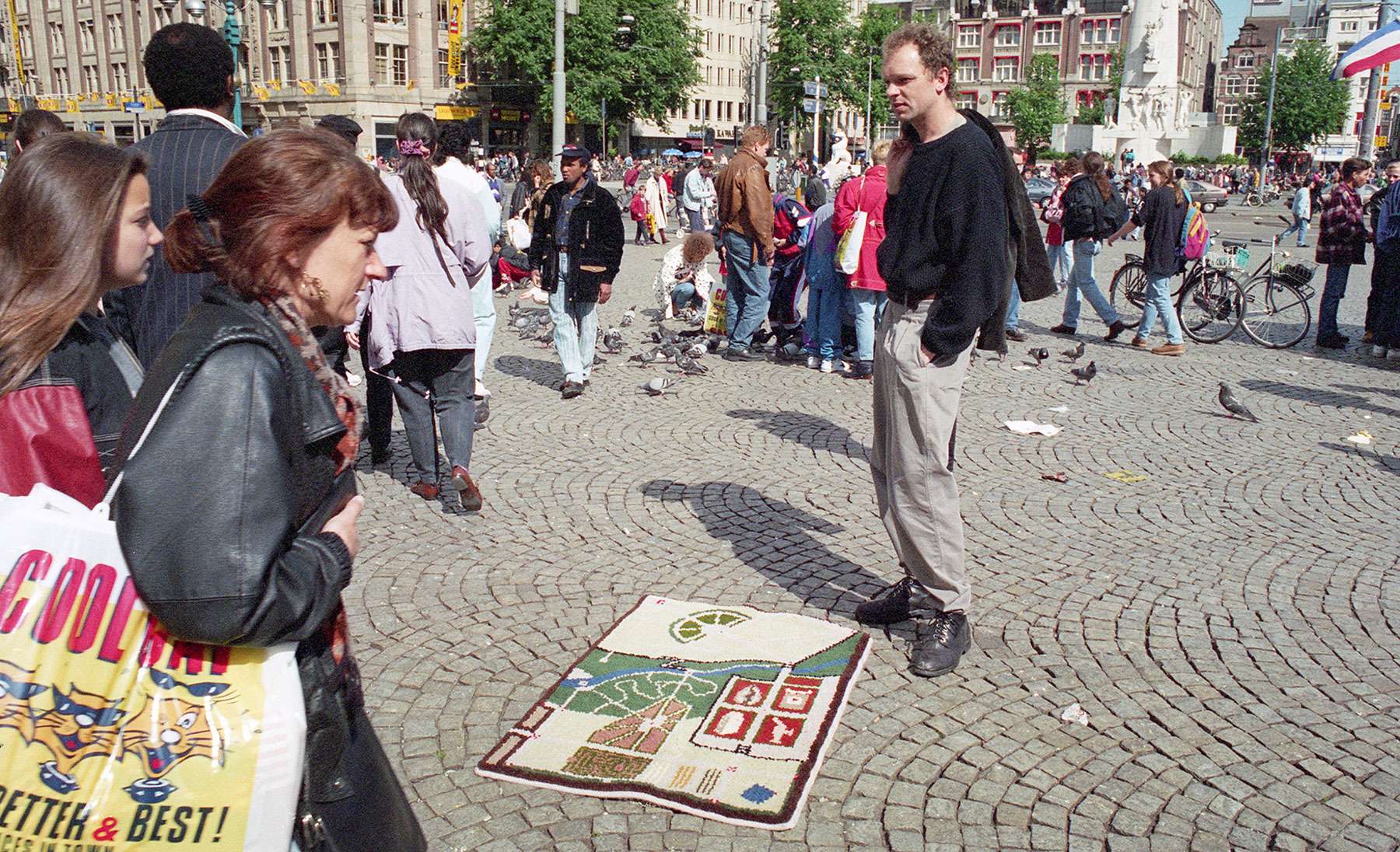 Parts of Passage – portable garden / photos, suitcase cloth, metal rings / 172x237cm / 1994 / photos LSp, JW, AT
Parts of Passage – portable garden / photos, suitcase cloth, metal rings / 172x237cm / 1994 / photos LSp, JW, AT
Take your place on the carpet:
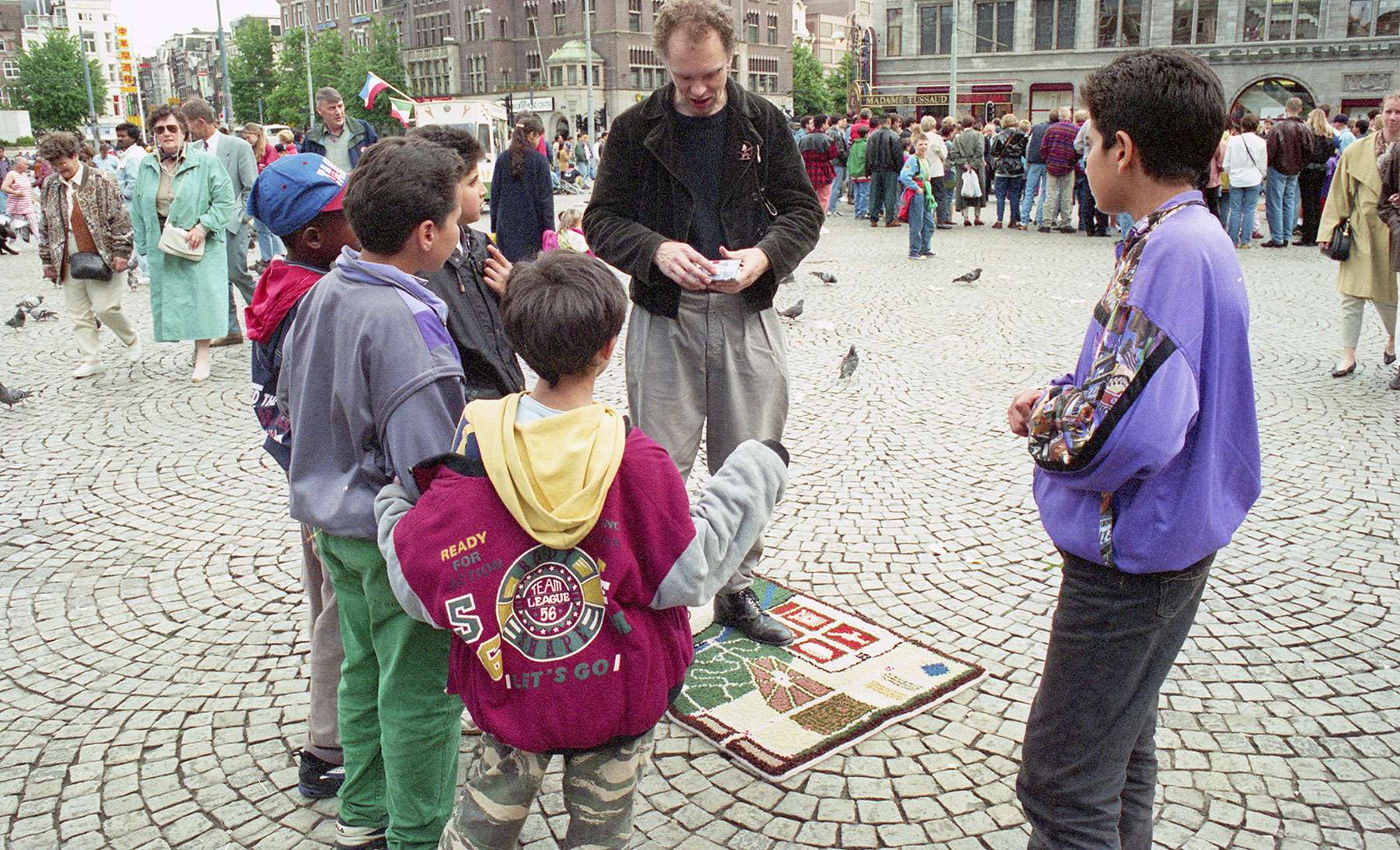
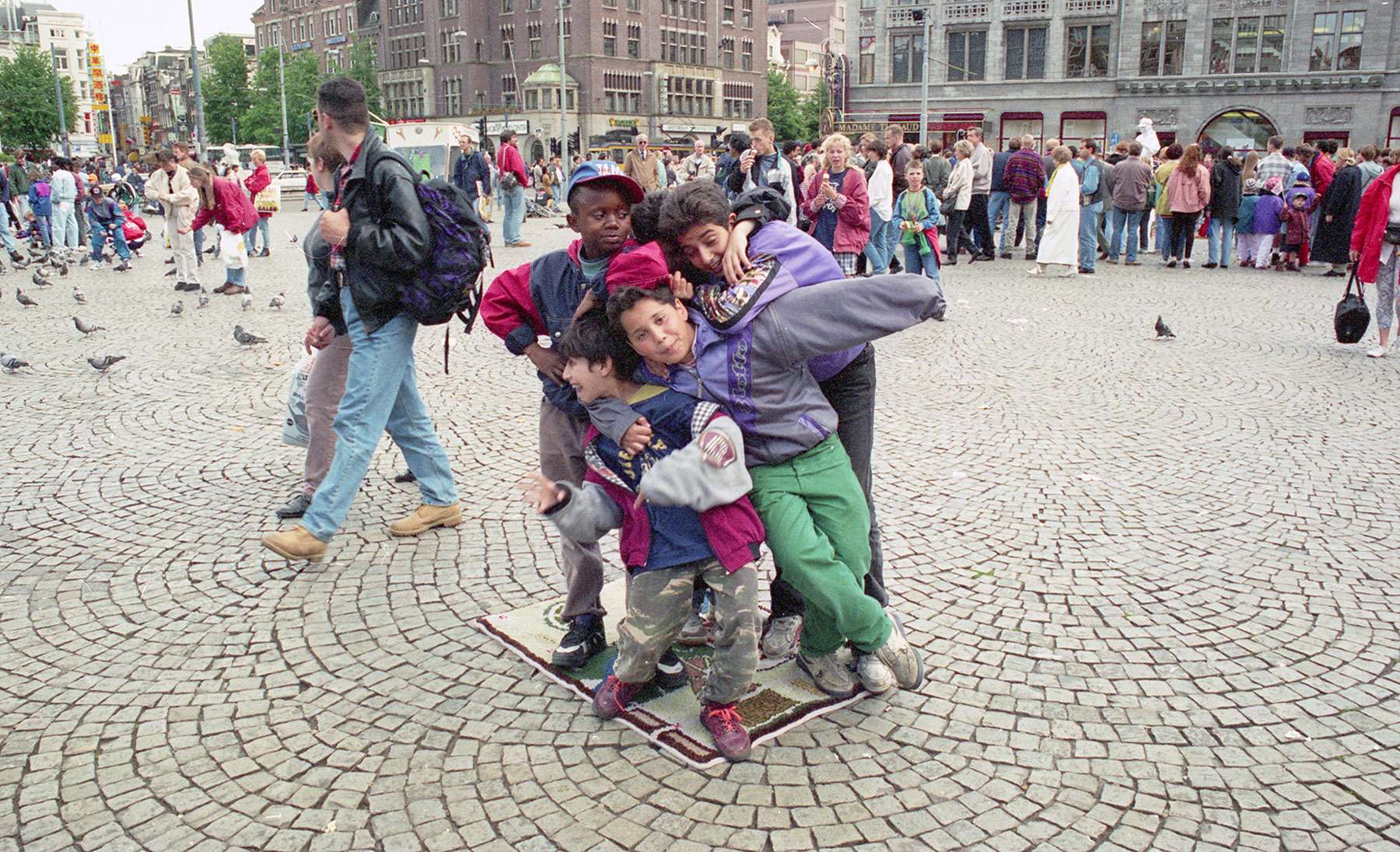
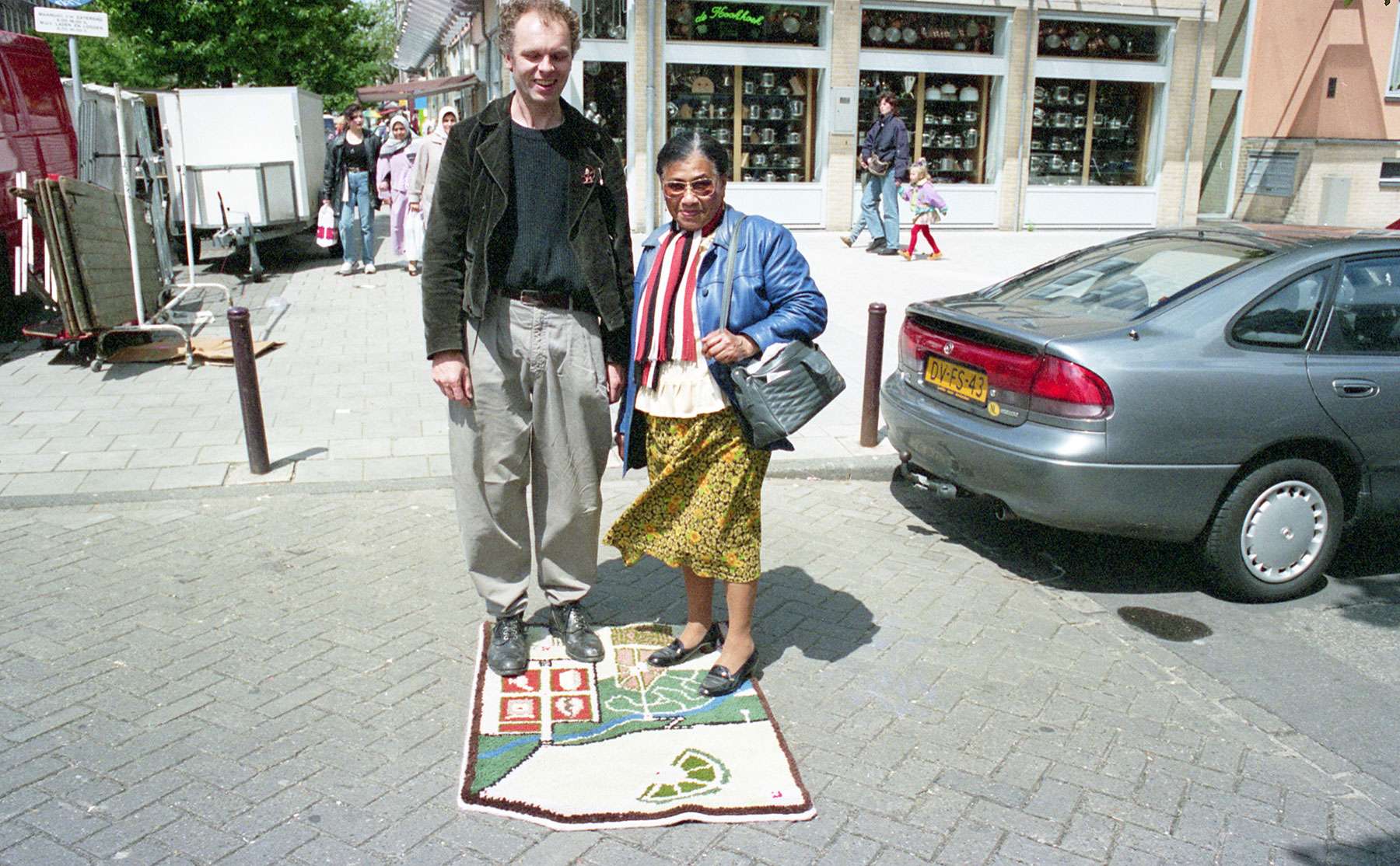
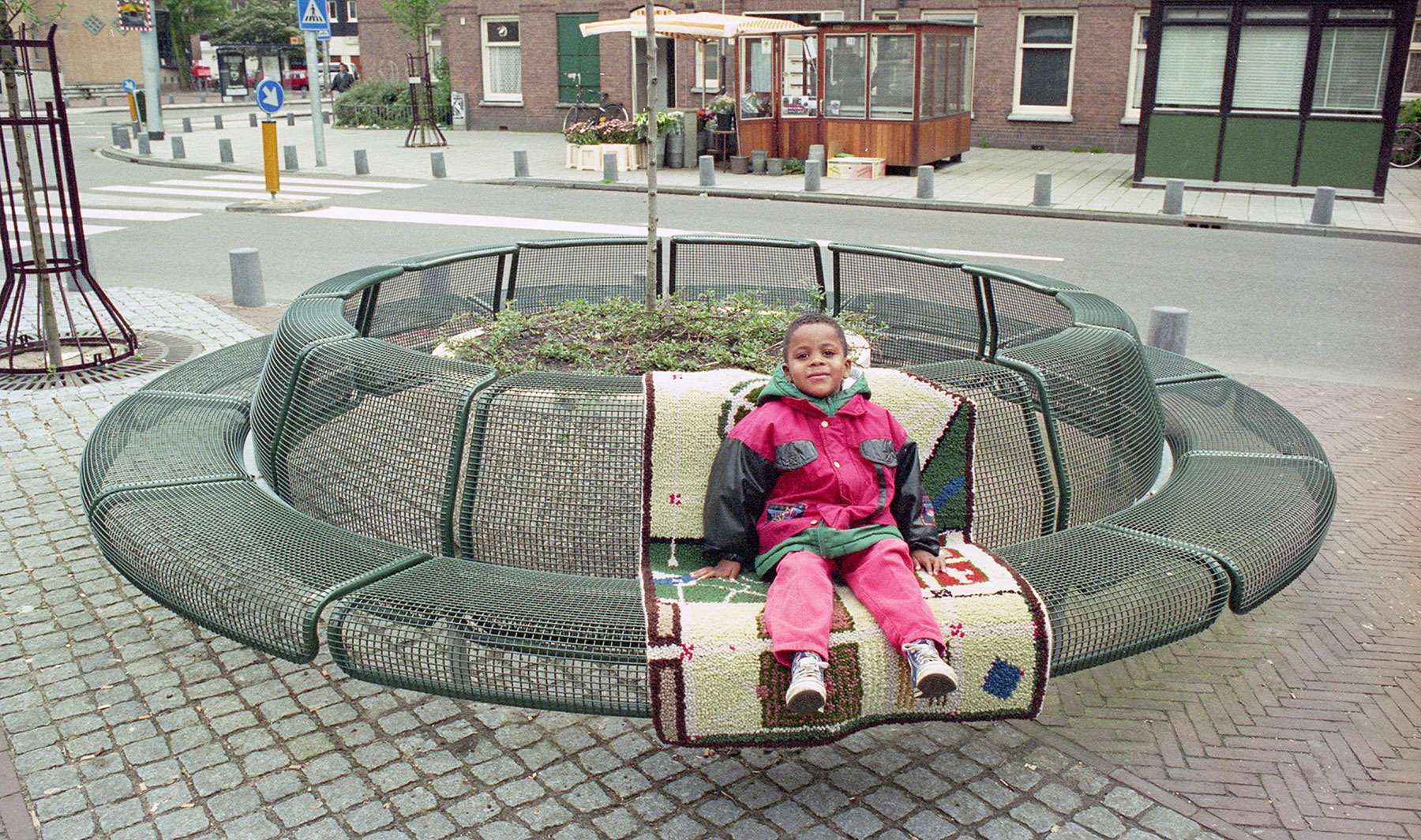
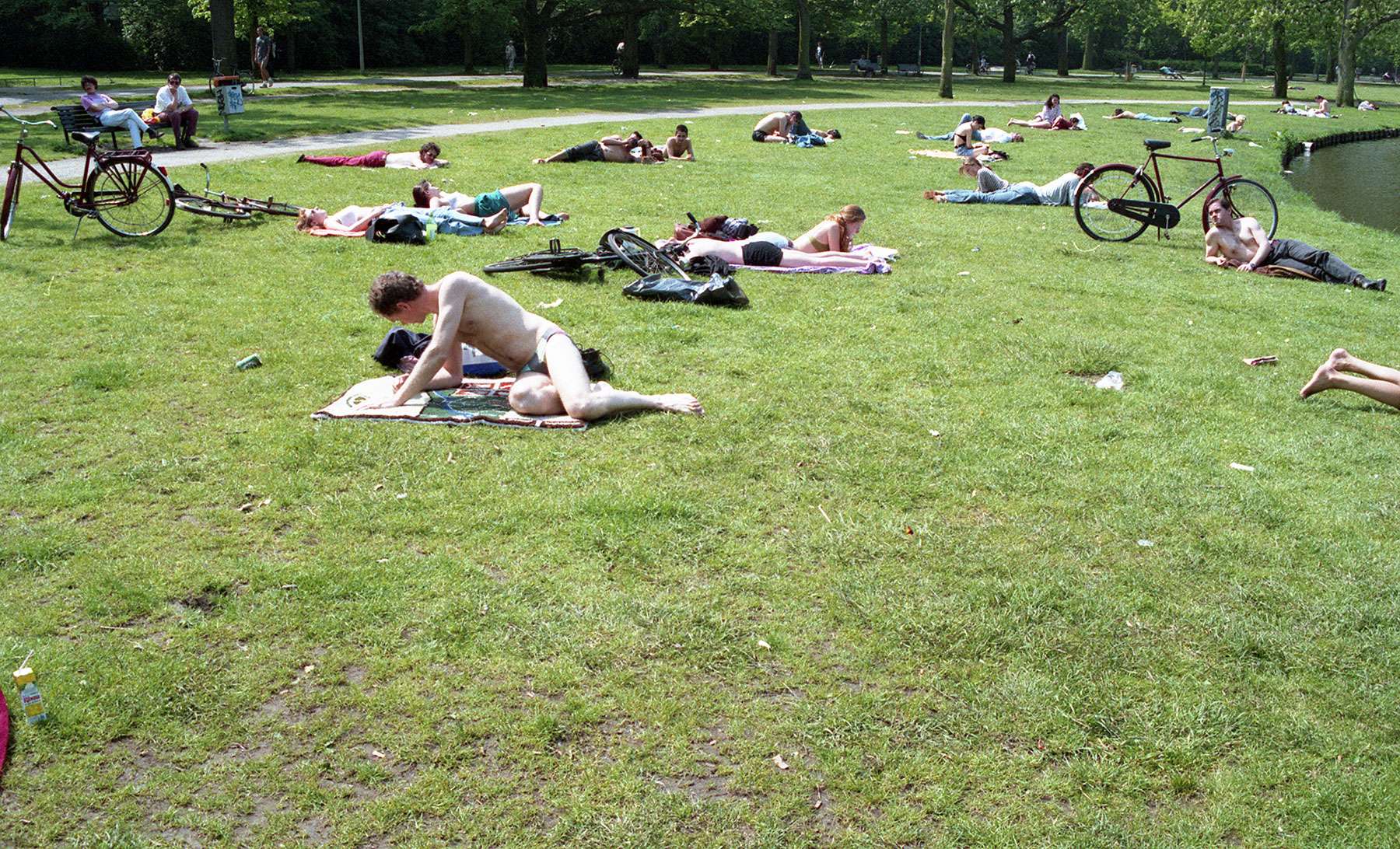
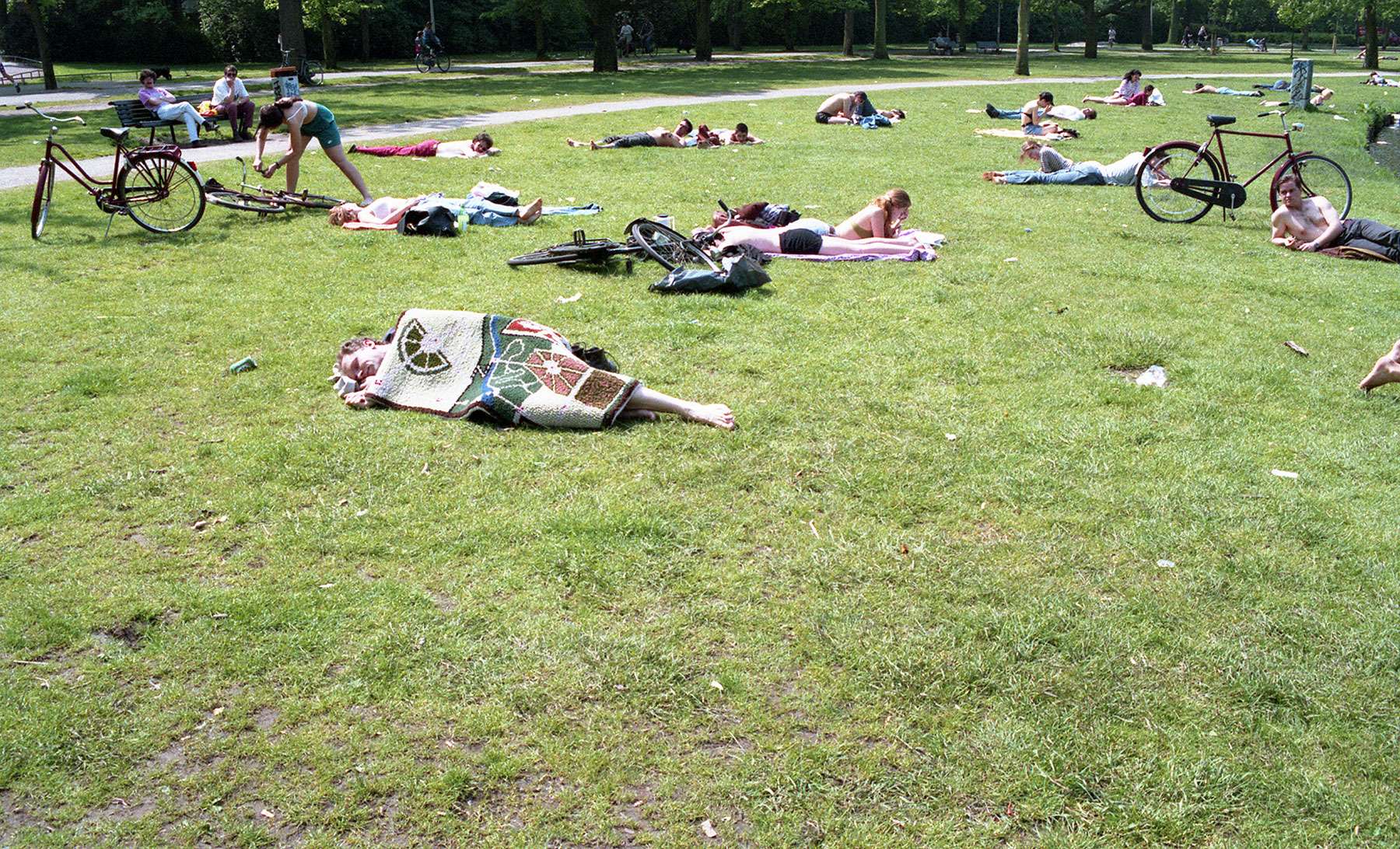 Parts of Passage – portable garden / photos, suitcase cloth, metal rings / 172x237cm / 1994 / photos LSp, JW, AT
Parts of Passage – portable garden / photos, suitcase cloth, metal rings / 172x237cm / 1994 / photos LSp, JW, AT
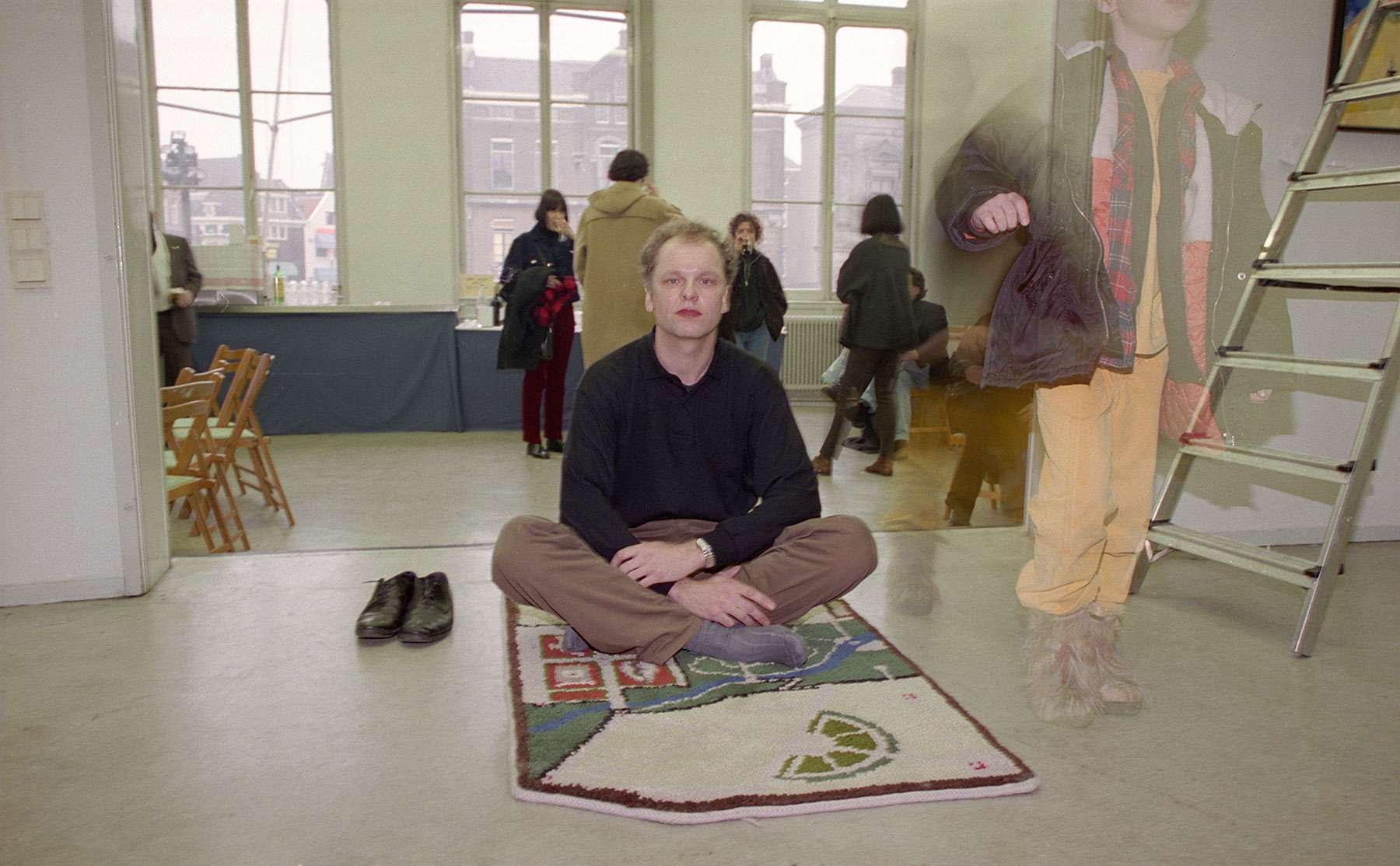
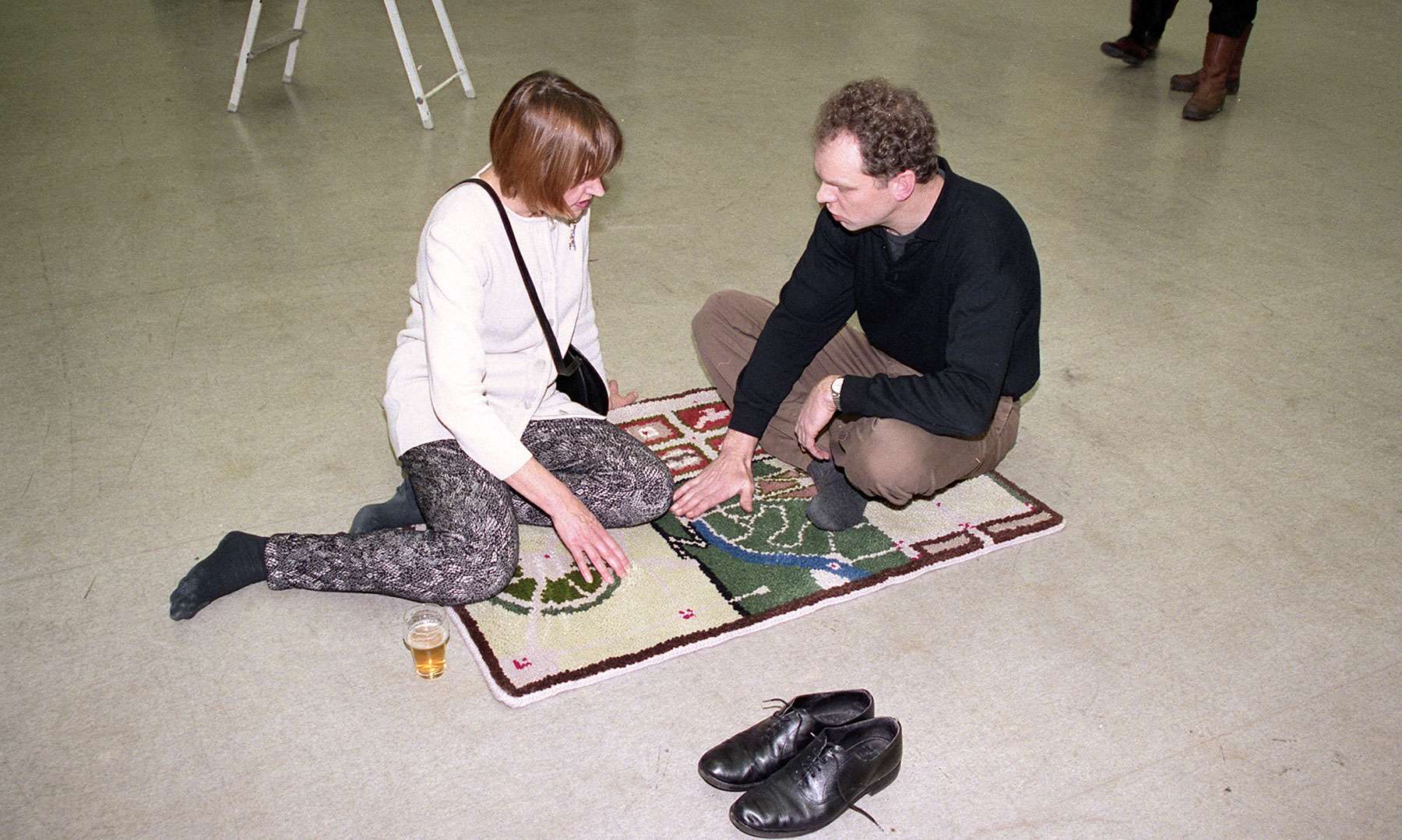


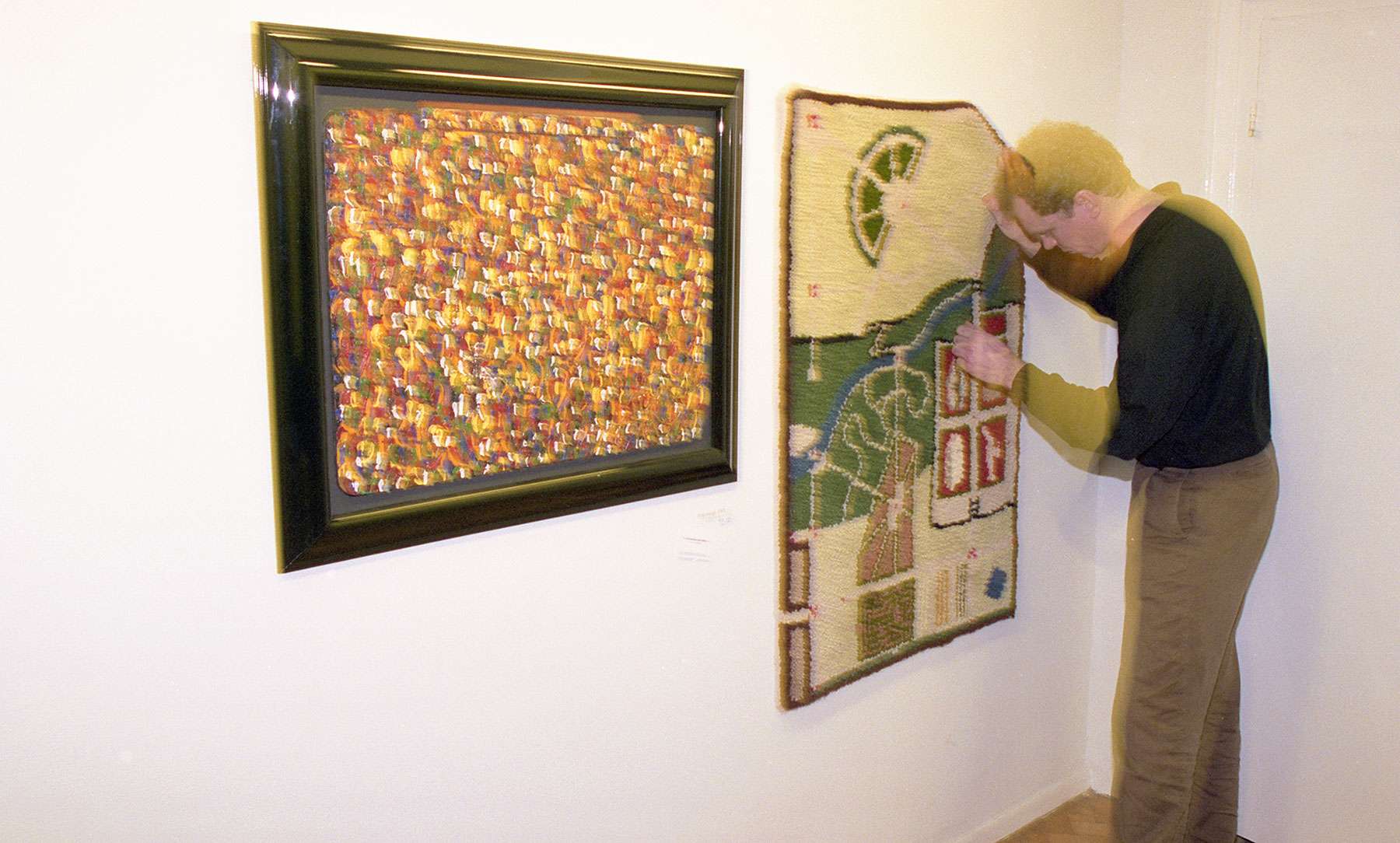
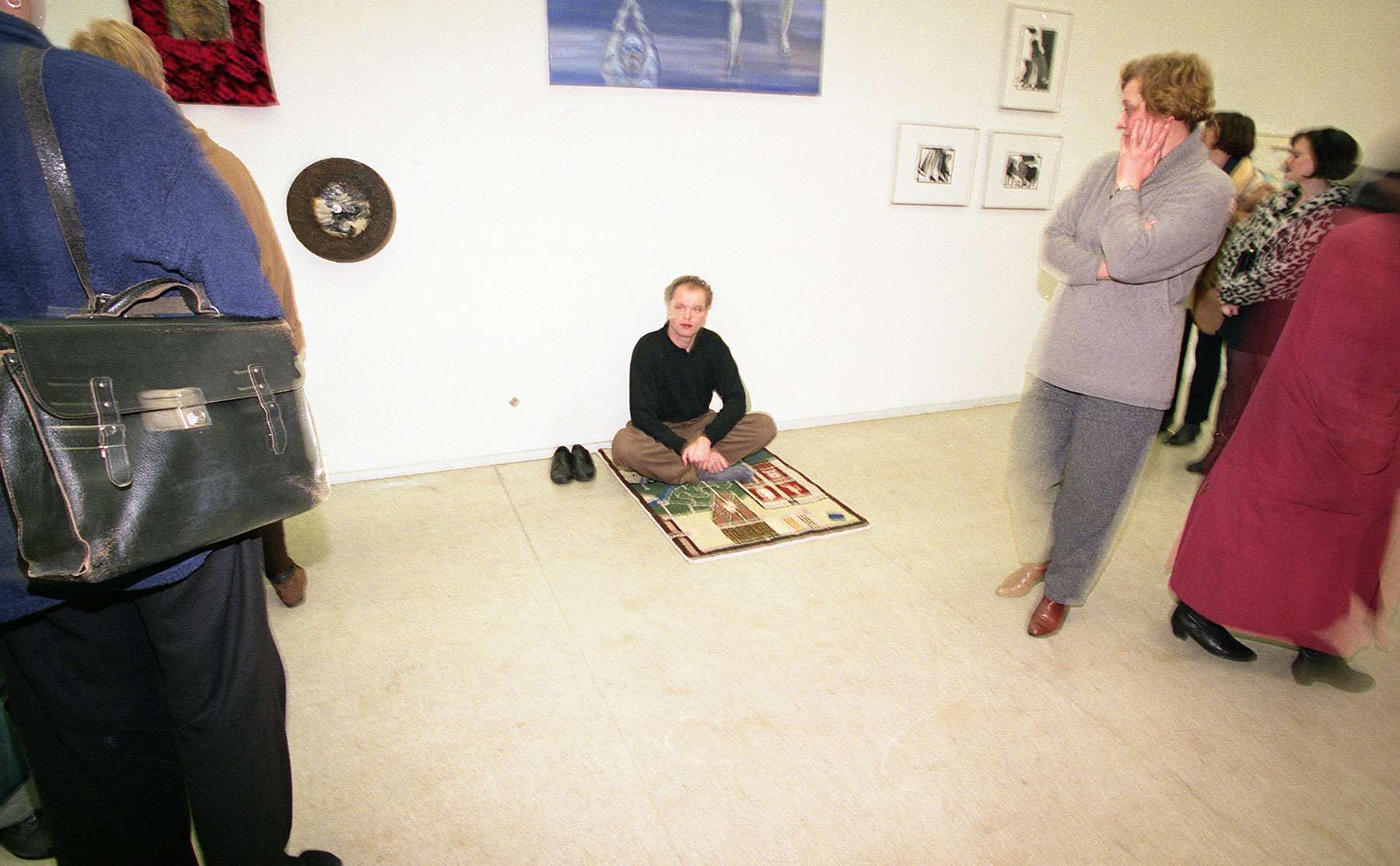

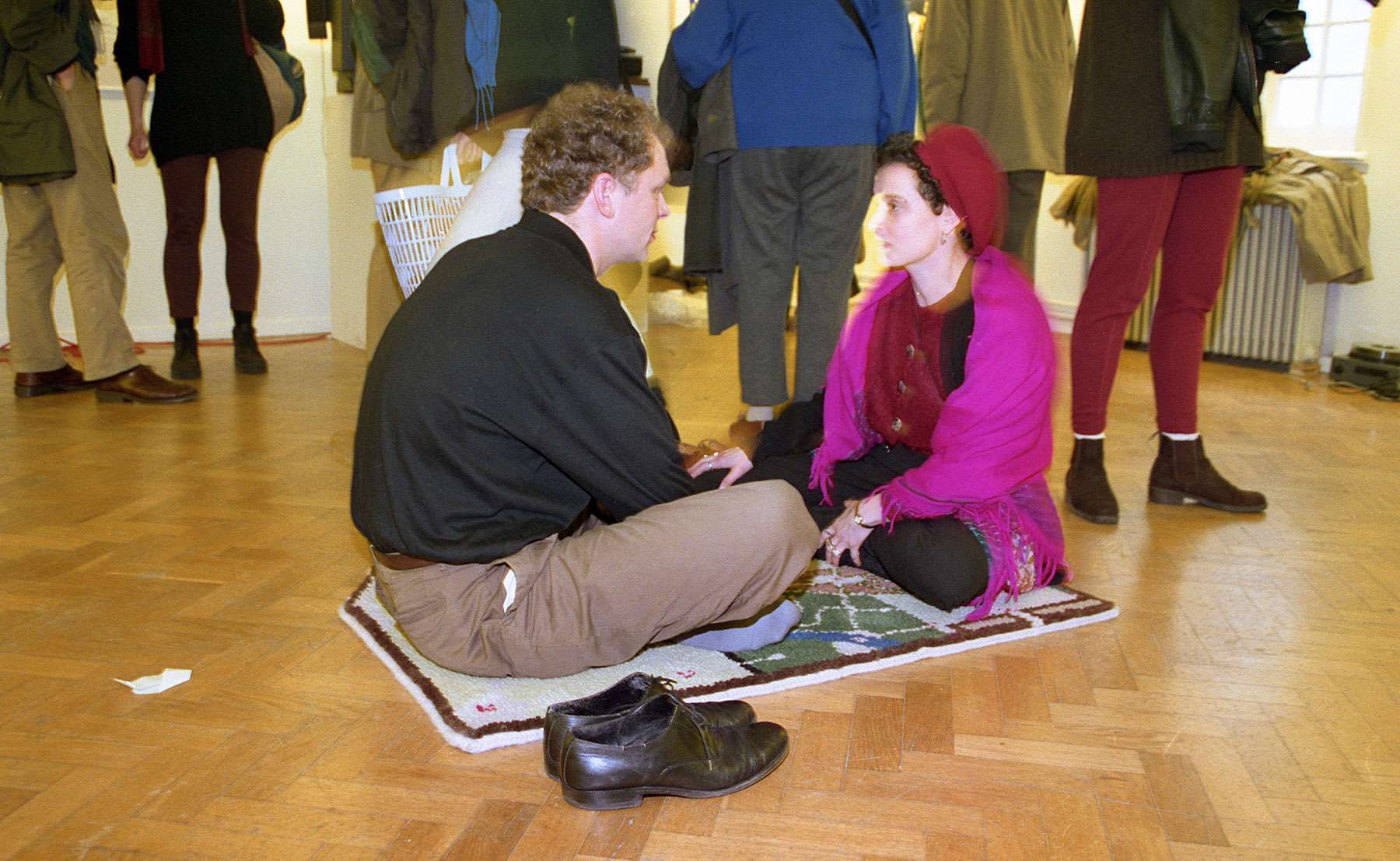
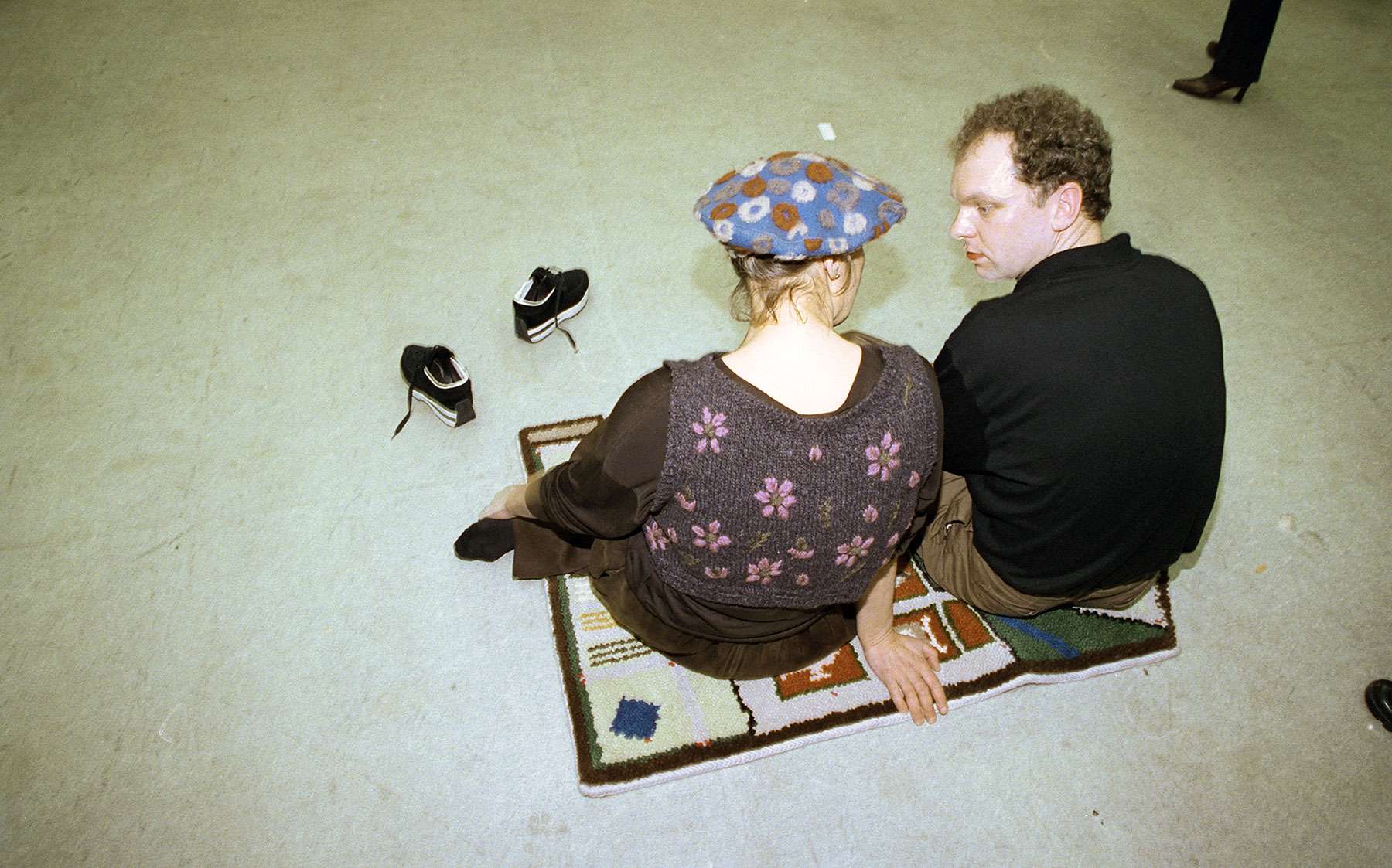
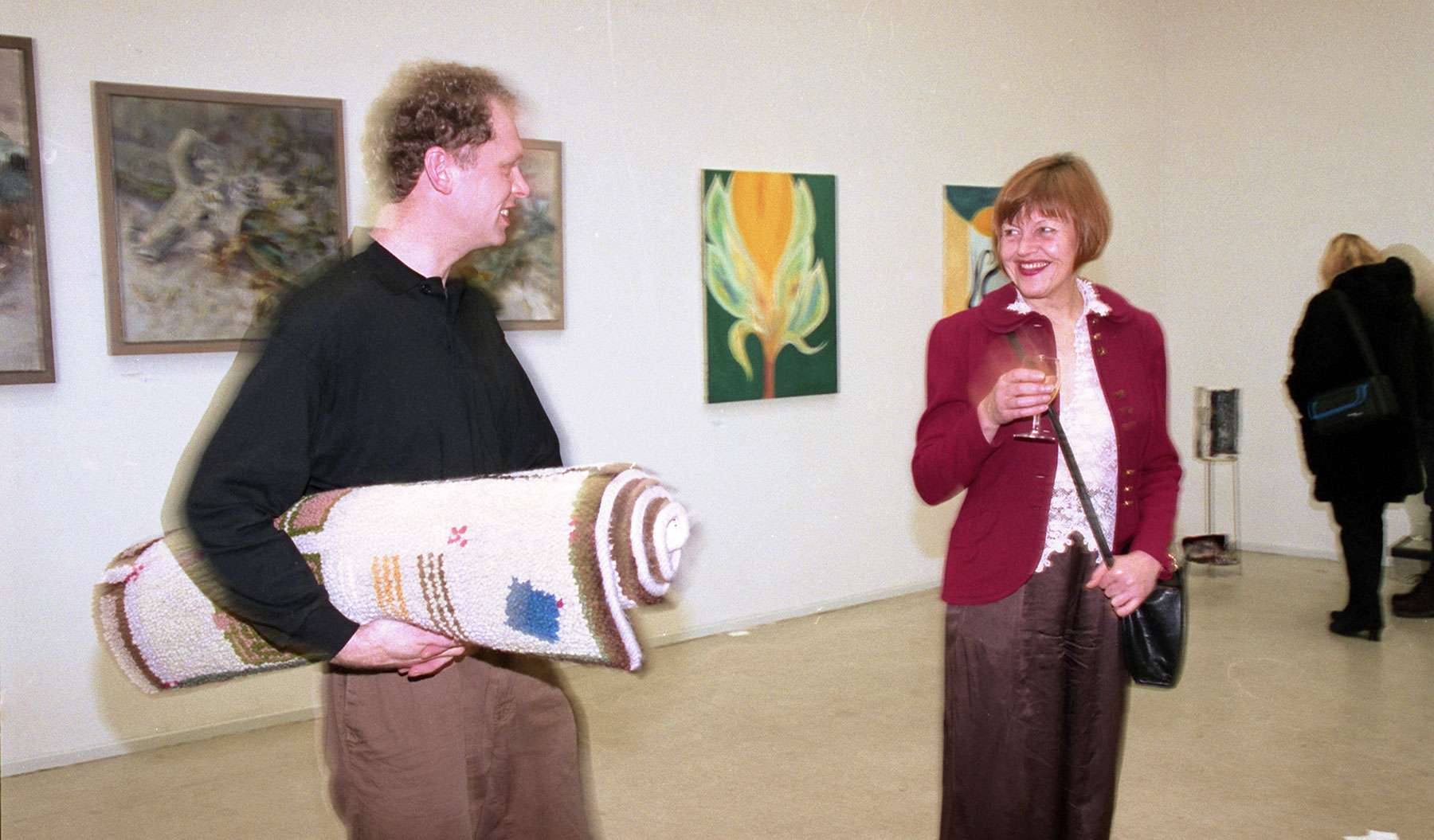
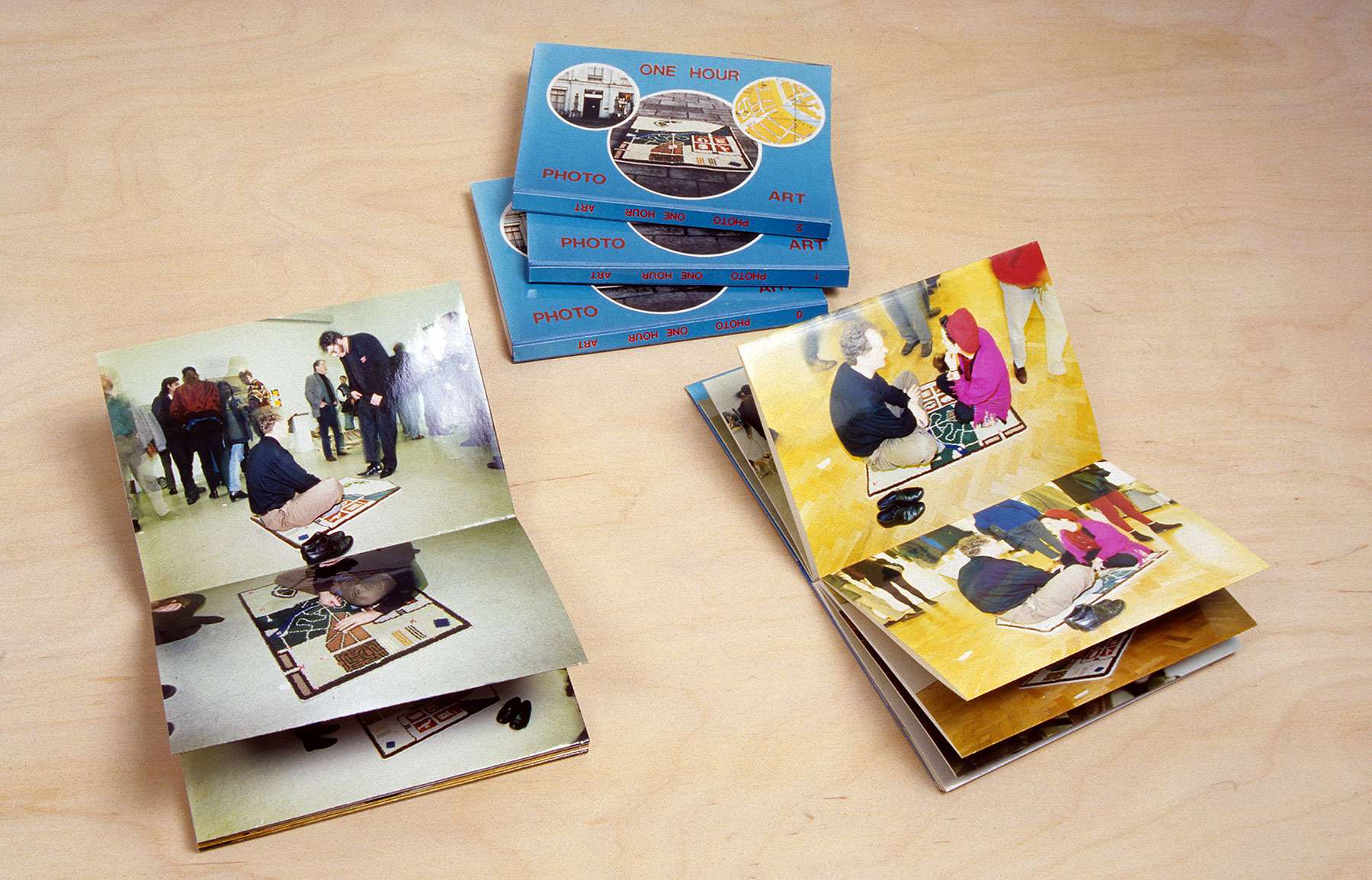
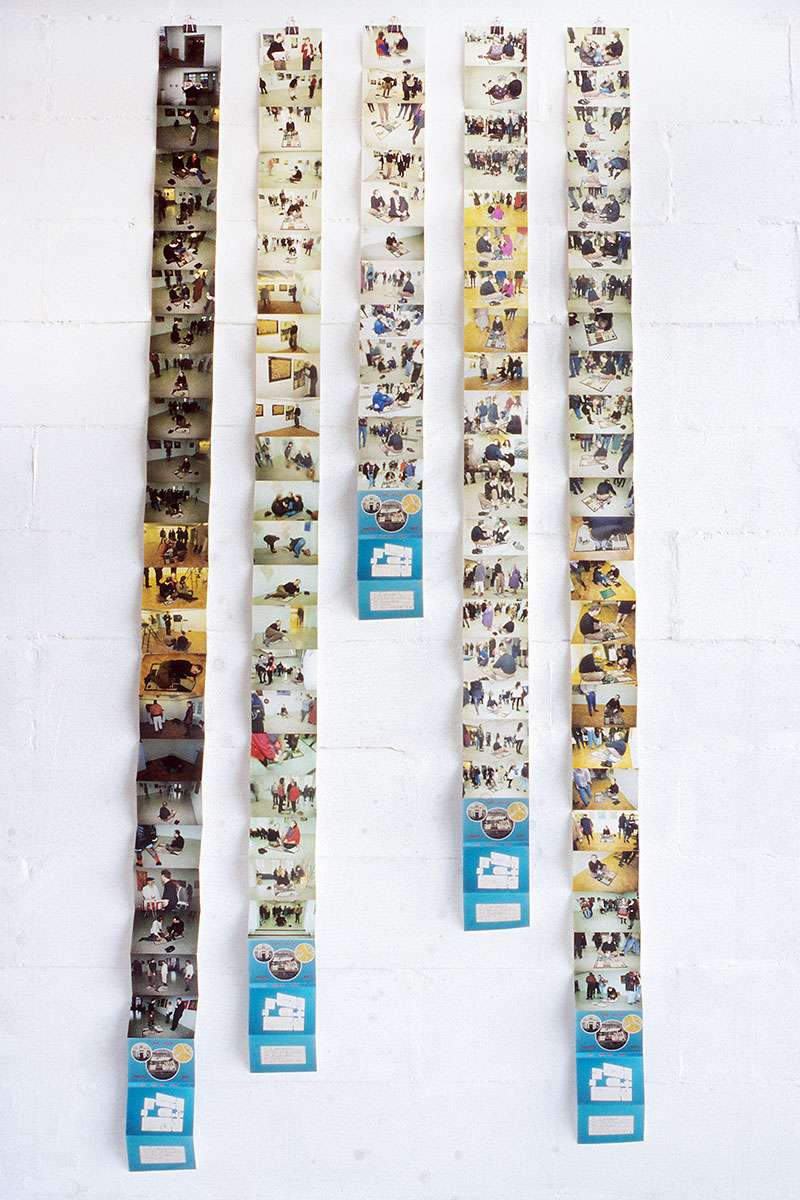 Souvenirs de Passage – one hour photo art, parts 0,1,2,3,4 / performance and photos, print, cardboard / 115x280cm / 1995 / photos AT
Souvenirs de Passage – one hour photo art, parts 0,1,2,3,4 / performance and photos, print, cardboard / 115x280cm / 1995 / photos AT
I performed a special version of Passage during One Hour Art in Arti et Amicitiae in Amsterdam.One Hour Art was an initiative of Jos Houweling, former director of the Sandberg Institute. In 1999, he set up the foundation One Minutes, of which One Hour Art is one of the activities. With it, Houweling wants to offer young artists a platform.
The concept of One Hour Art consisted of displaying a work of art that was replaced by another by the curator about an hour later. In this way, the exhibition changed continuously throughout the day. An artist strolled in and the curator took the work from him. The curator walked over to the exhibition and changed it by hanging up the work. Thus, another work went back to its maker. Several times throughout the day, I made an hour-long trip around the exhibition halls with my carpet.
Out of the concept of the exhibition, the interest also arose about how the works of art related to each other, however short. The public also consisted of a continuously changing mixture of visitors and artists who walked around to see where their works would be hung.
In response to this, with the carpet, I constantly took up a position in relation to the works of art, but also in relation to the audience. They were invited to sit on the carpet – ‘but take off your shoes!’ Photos of this were taken by Andrei Tchernikov.
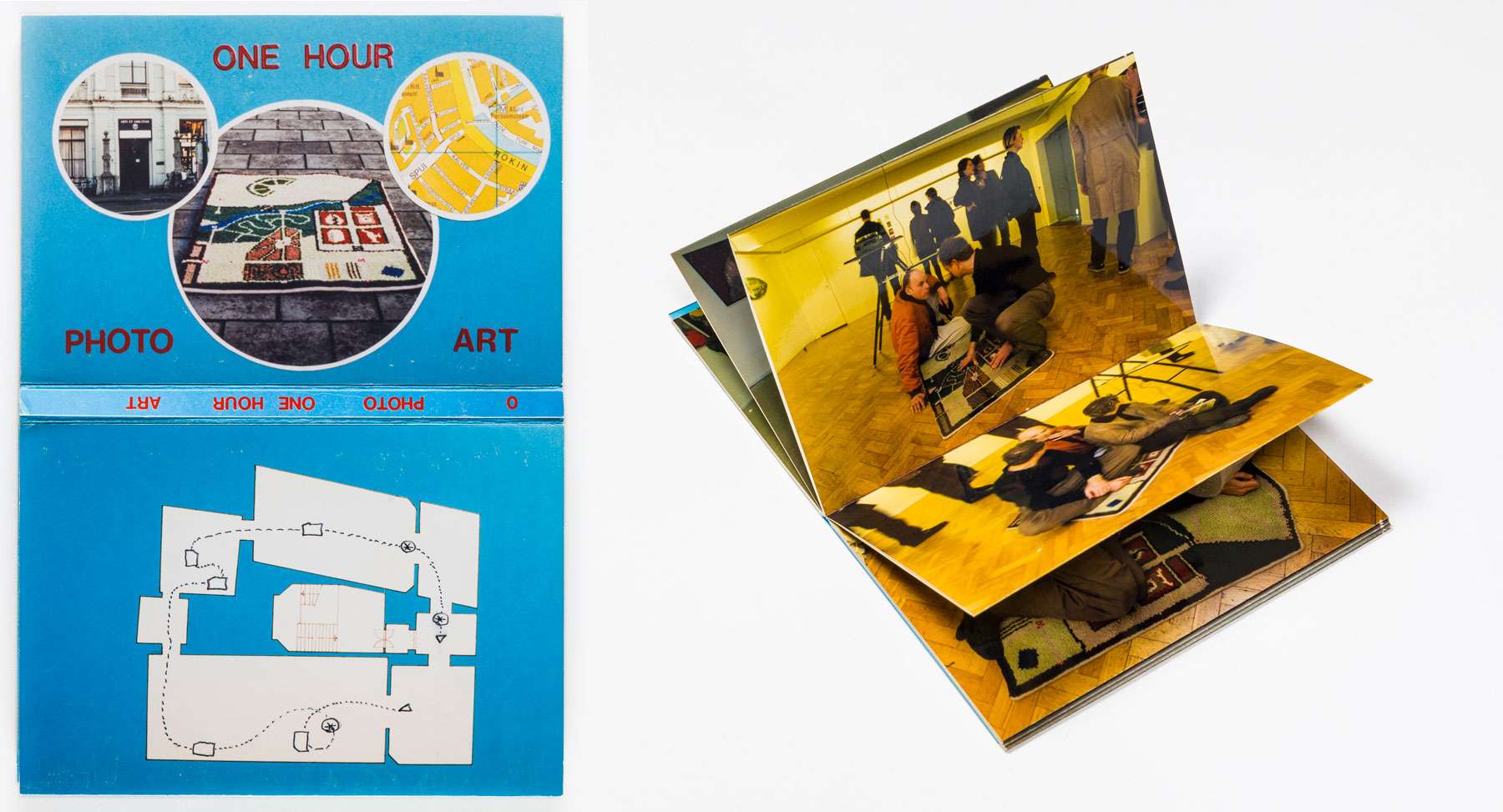
Souvenirs de Passage - one hour photo art, part 0 / photos, print, cardboard / 15x271cm / 1995 / photos AT
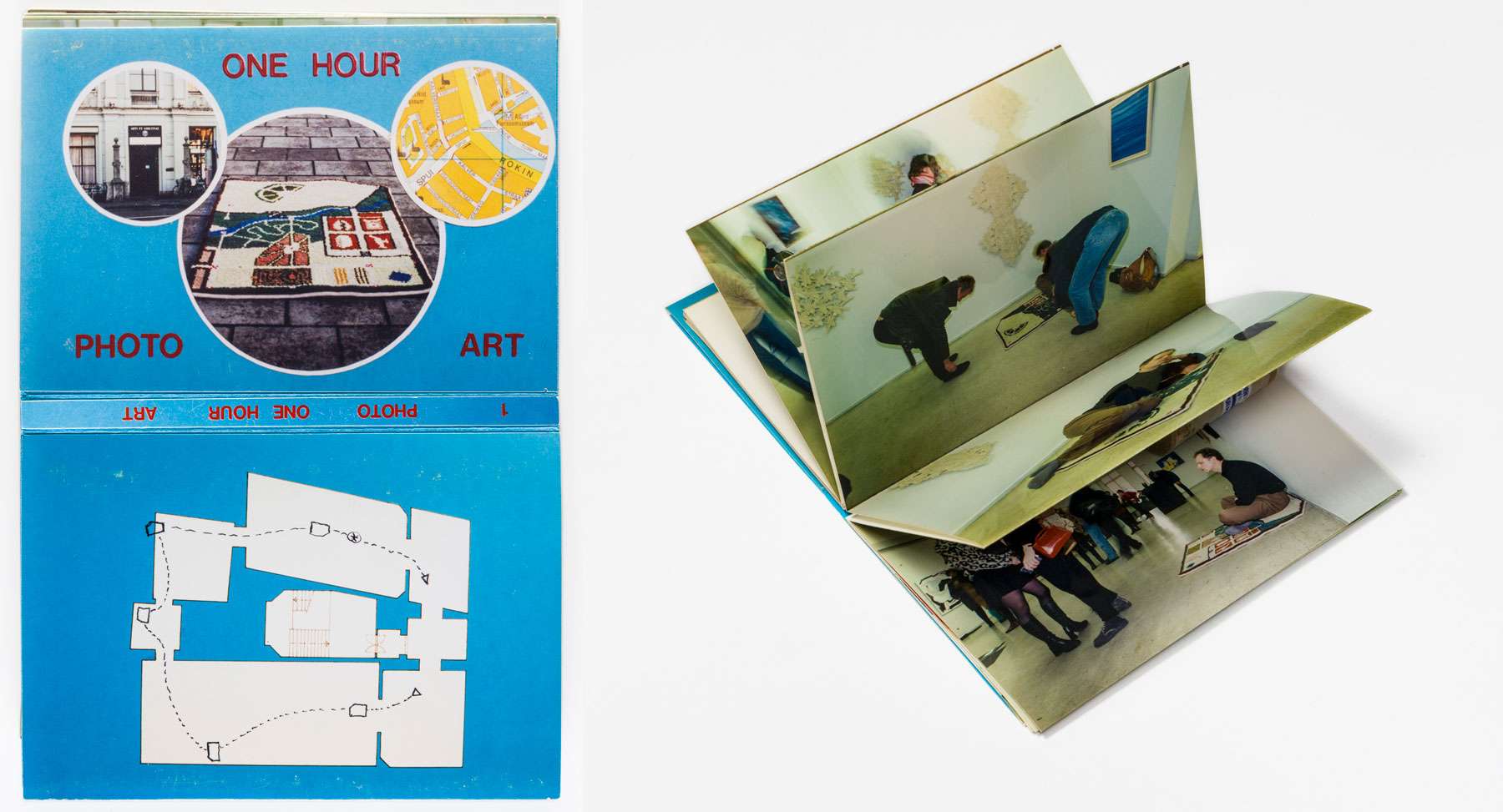
Souvenirs de Passage - one hour photo art, part 1 / photos, print, cardboard / 15x271cm / 1995 / photos AT
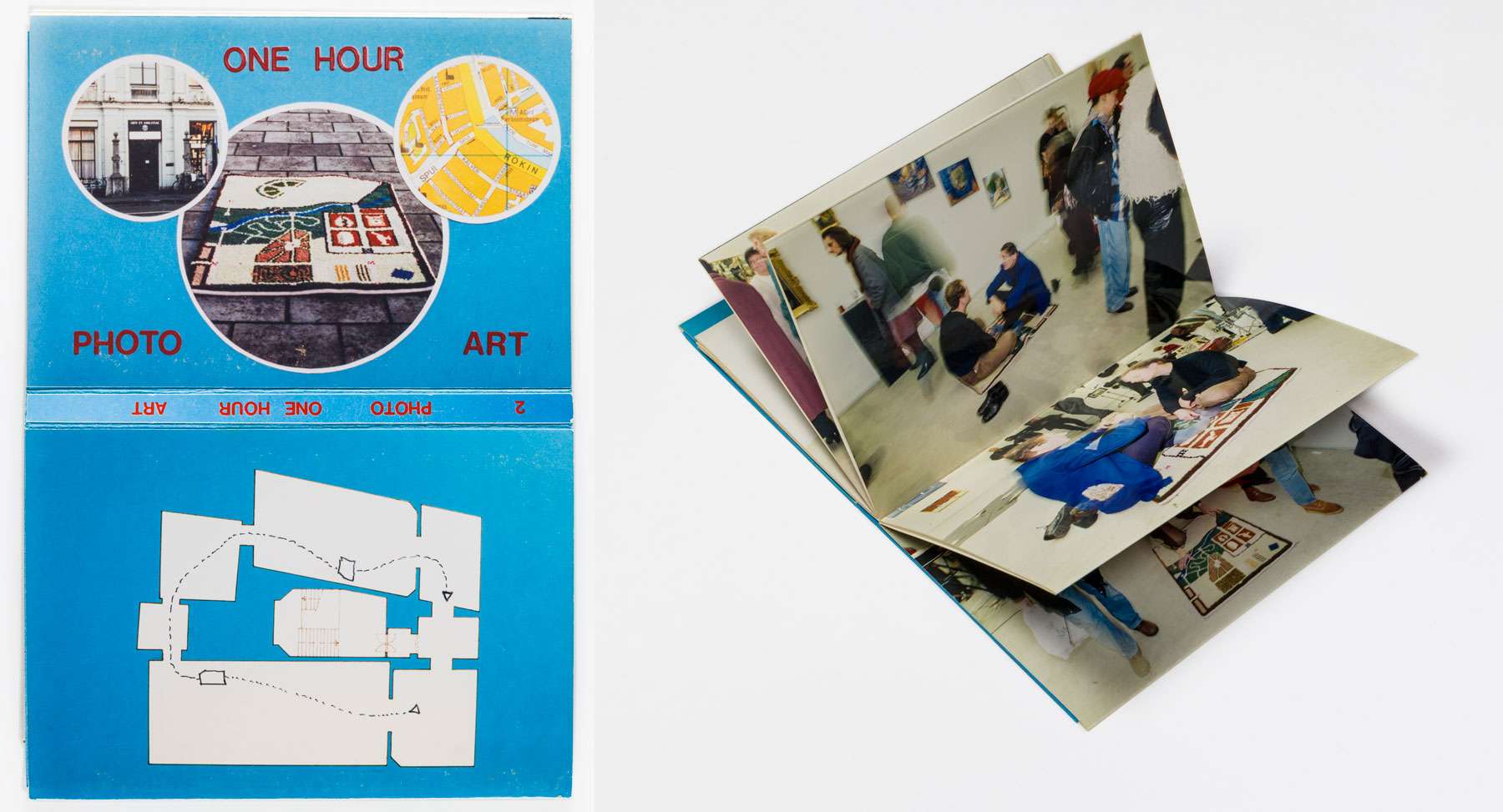
Souvenirs de Passage - one hour photo art, part 2 / photos, print, cardboard / 15x271cm / 1995 / photos AT
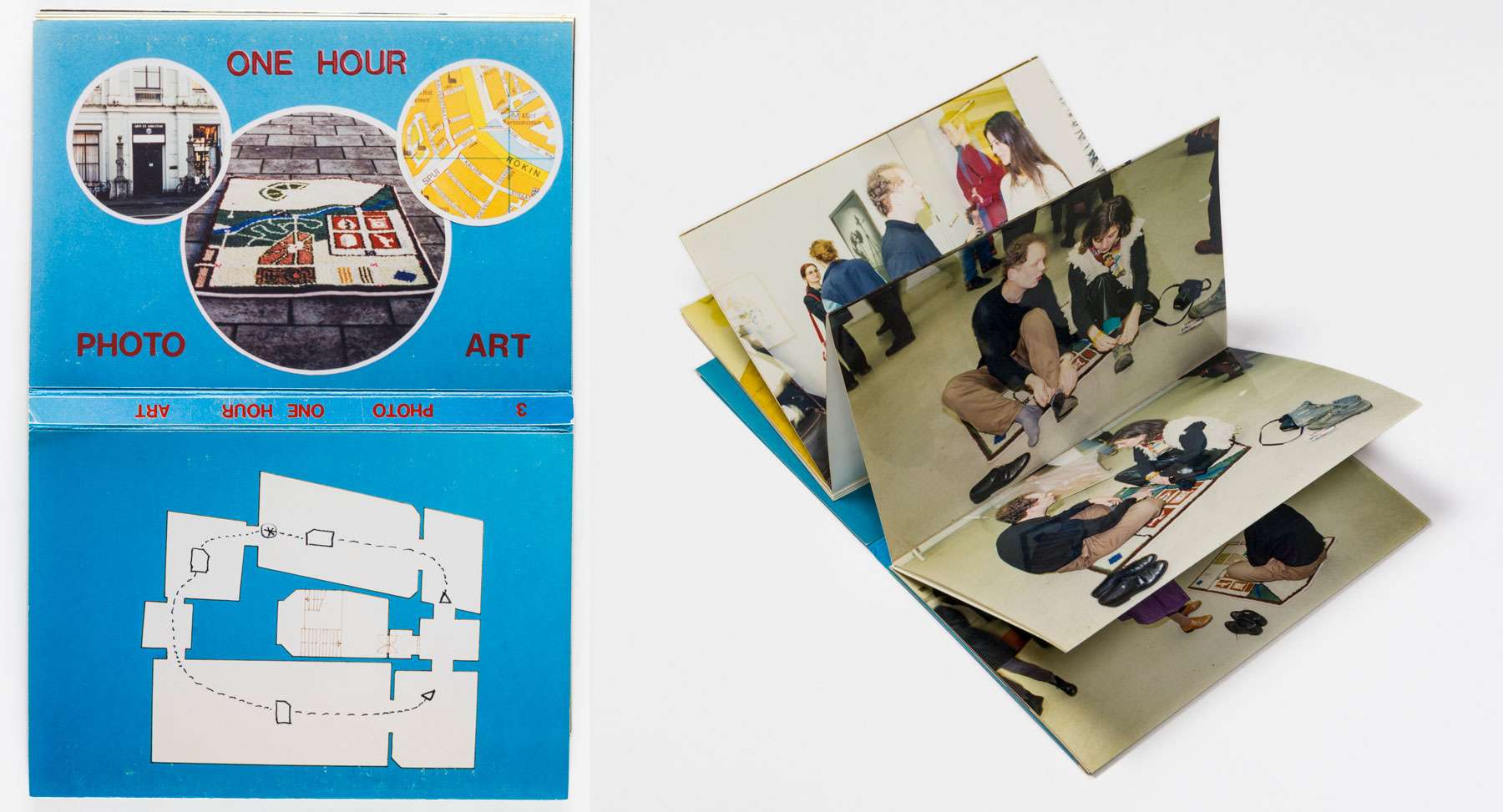
Souvenirs de Passage - one hour photo art, part 3 / photos, print, cardboard / 15x271cm / 1995 / photos AT
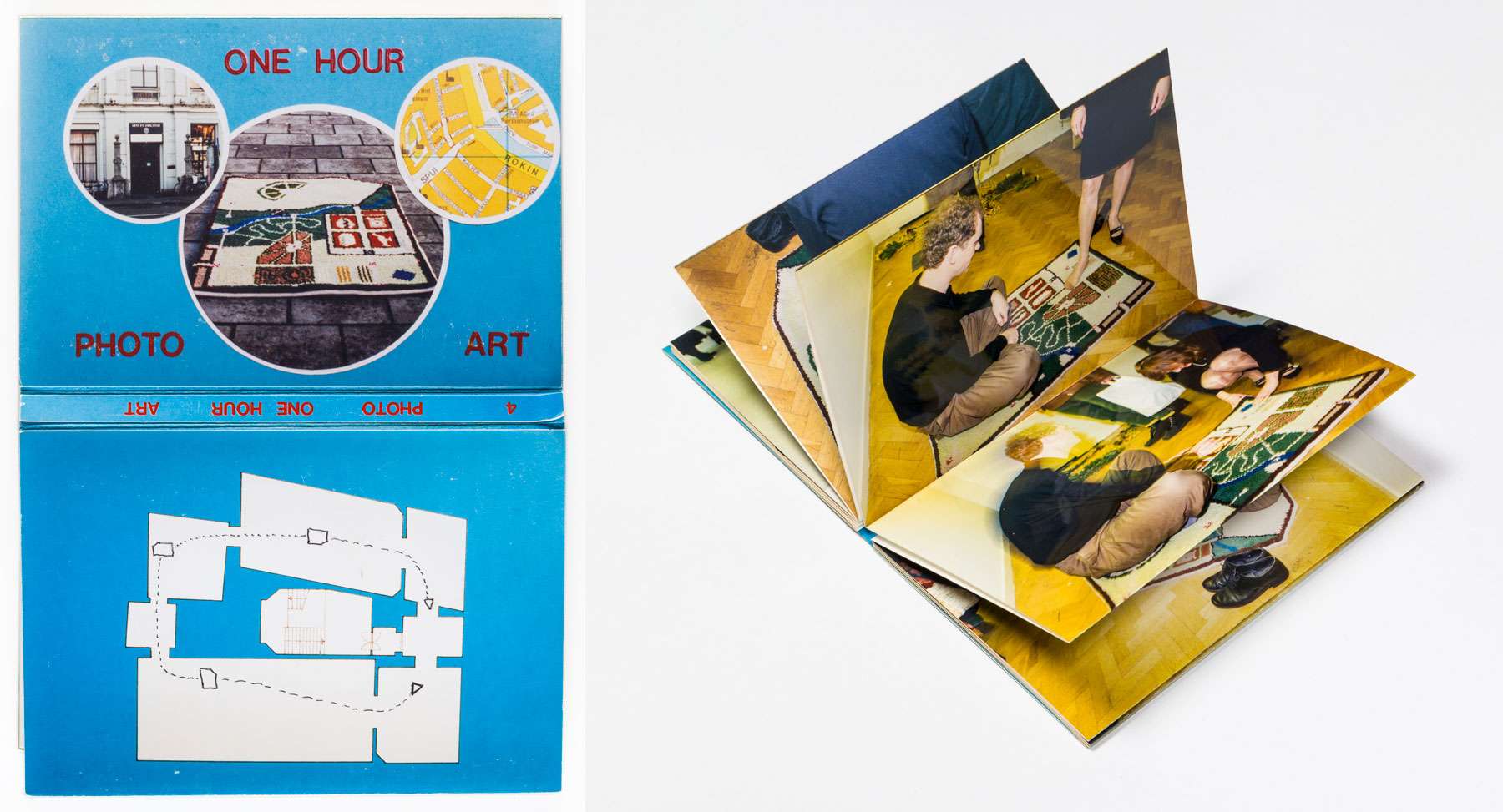
Souvenirs de Passage - one hour photo art, part 4 / photos, print, cardboard / 15x271cm / 1995 / photos AT
After a tour, the photos were printed at a nearby photo development centre in a long strip, without cutting them afterwards. In the development centre, several previously supplied photos were printed with them. Before the start of my next tour I folded the photos into a Luparello that I hung up in the exhibition area. People who were invited into the garden on my carpet could see photos of this visit an hour later in the Luparello one hour photo art. They could buy the photos, as a souvenir.

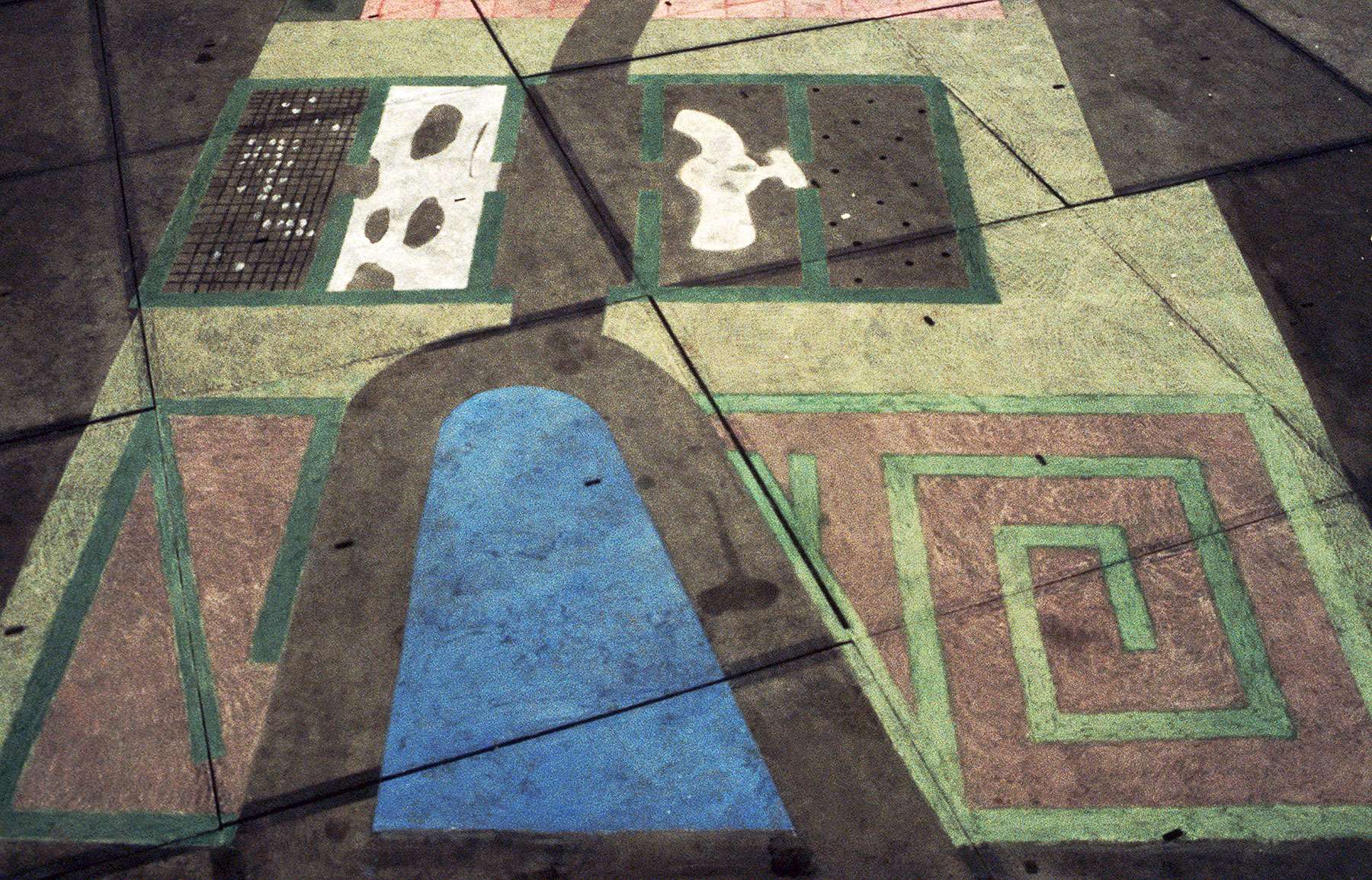
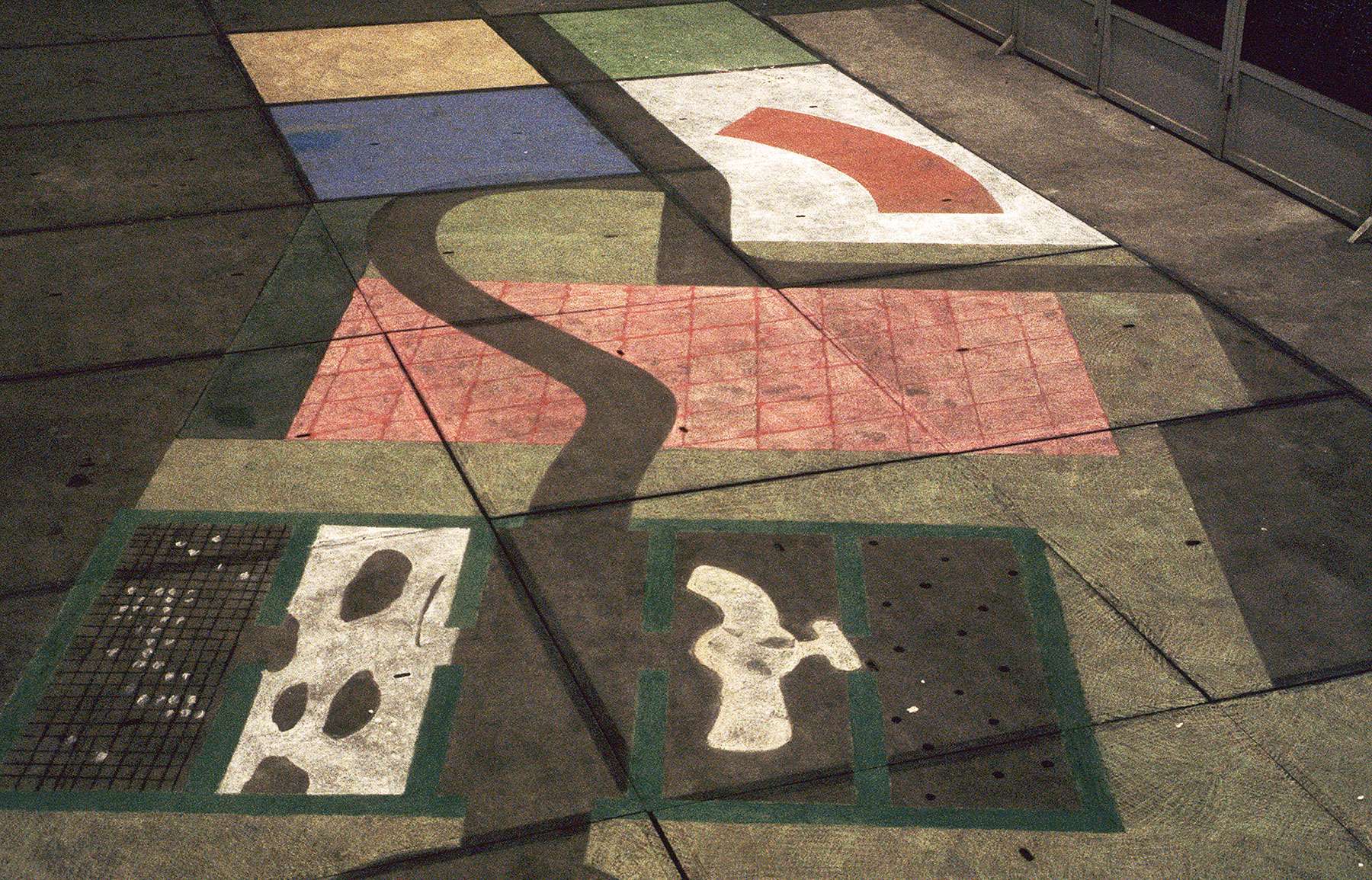
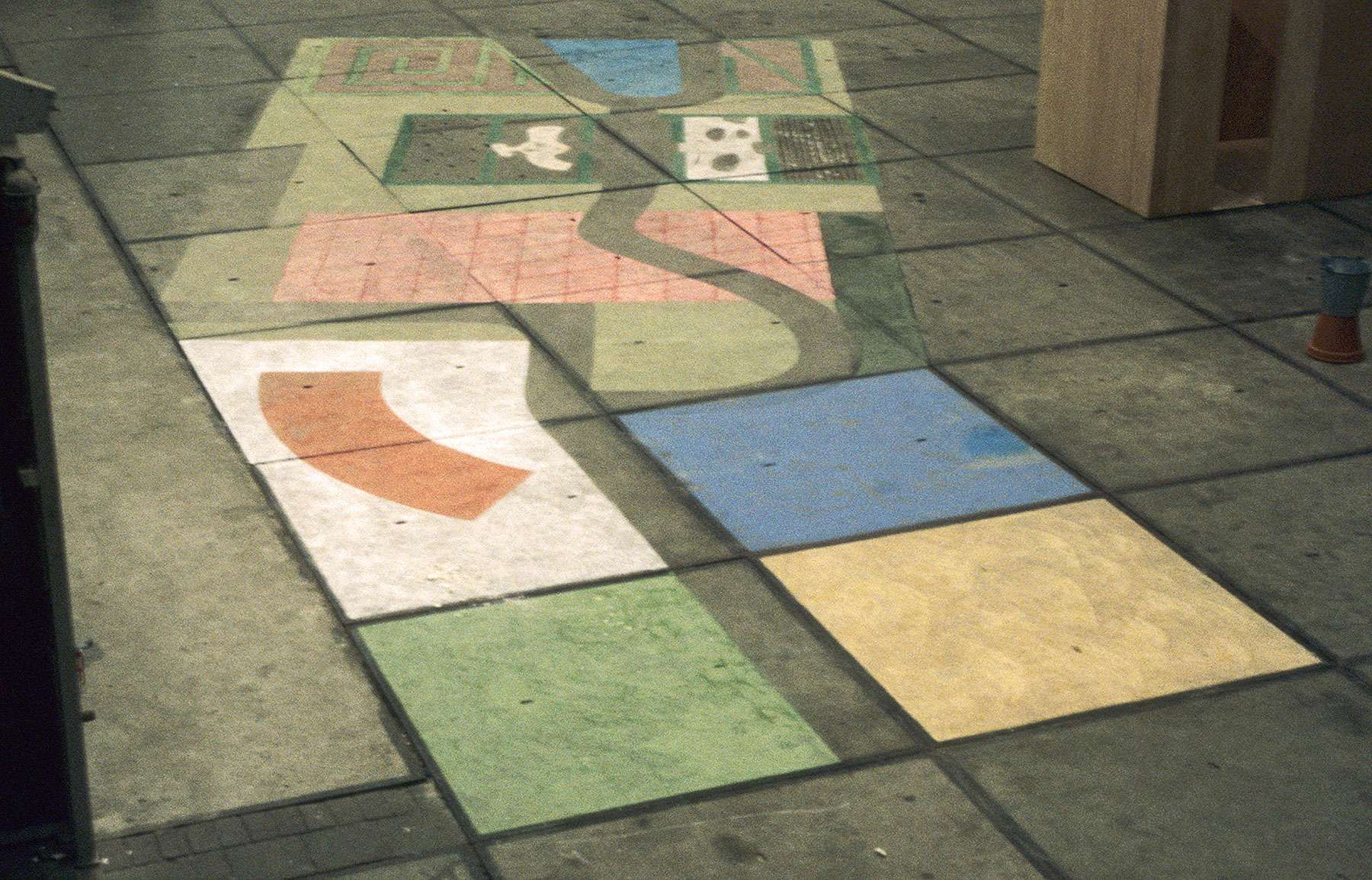 Greetings from Nut & Genoegen – portable garden / sidewalk chalk / 600x1000cm / 1994
Greetings from Nut & Genoegen – portable garden / sidewalk chalk / 600x1000cm / 1994
Group exhibition 10 new Dutch and 1 fresh Portuguese, Transformer House, Wester Gas Factory, Amsterdam
In the Transformer House on the grounds of the Wester Gas Factory, I drew a garden with the name Greetings from Nut & Genoegen using sidewalk chalk as part of the exhibition 10 new Dutch and 1 fresh Portuguese. As with Greetings from Smyrna it is about a fictional garden, both in terms of the layout and the execution in chalk. However, you could walk through it.
Right next to the Wester Gas Factory grounds in Amsterdam-West there’s an allotment complex called Garden Park Nut & Genoegen. Here, the idea of a collection of flower gardens with little houses has become what you could describe as a super-green suburb with miniature bungalows.
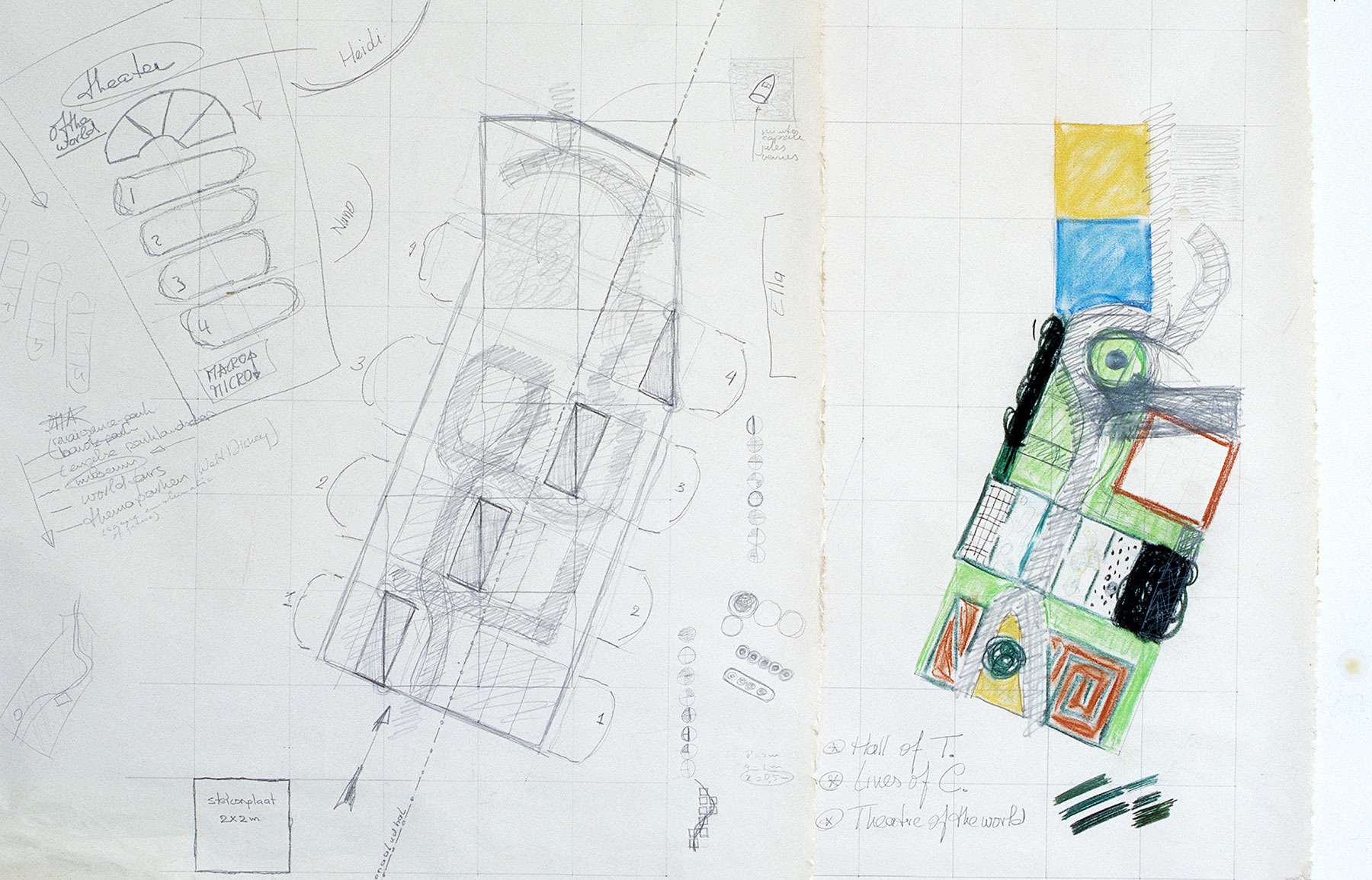
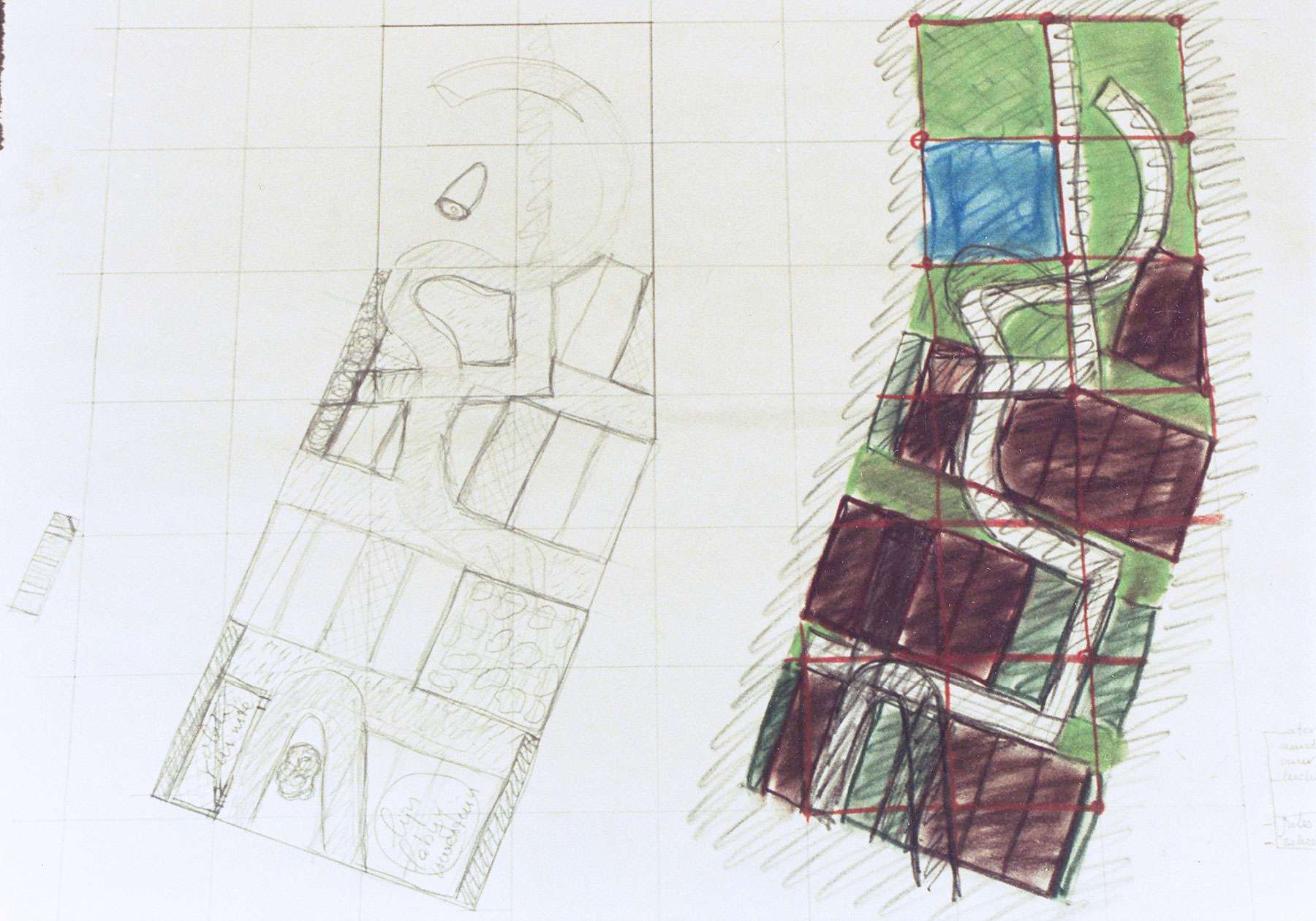 Sketches for Greetings from Nut & Genoegen – portable garden / sidewalk chalk / 600x1000cm / 1994
Sketches for Greetings from Nut & Genoegen – portable garden / sidewalk chalk / 600x1000cm / 1994
With its dimensions, ratios and direction the chalk garden points to the space in the Transformer House and the floor of square concrete slabs. The direct line from the outer door to the entrance of the garden coincides with the diagonal from the hall and the direction of the first part of the garden.
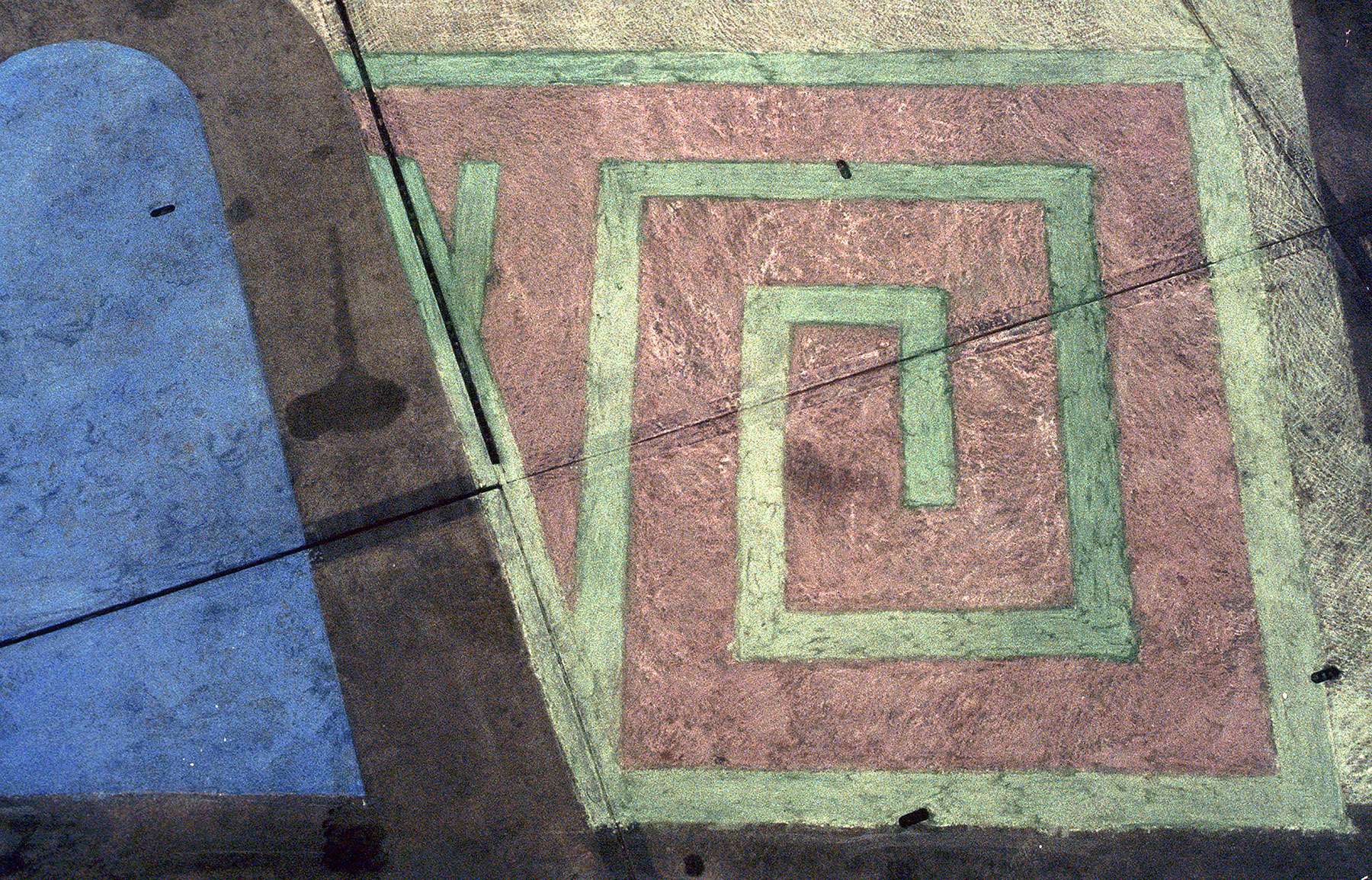
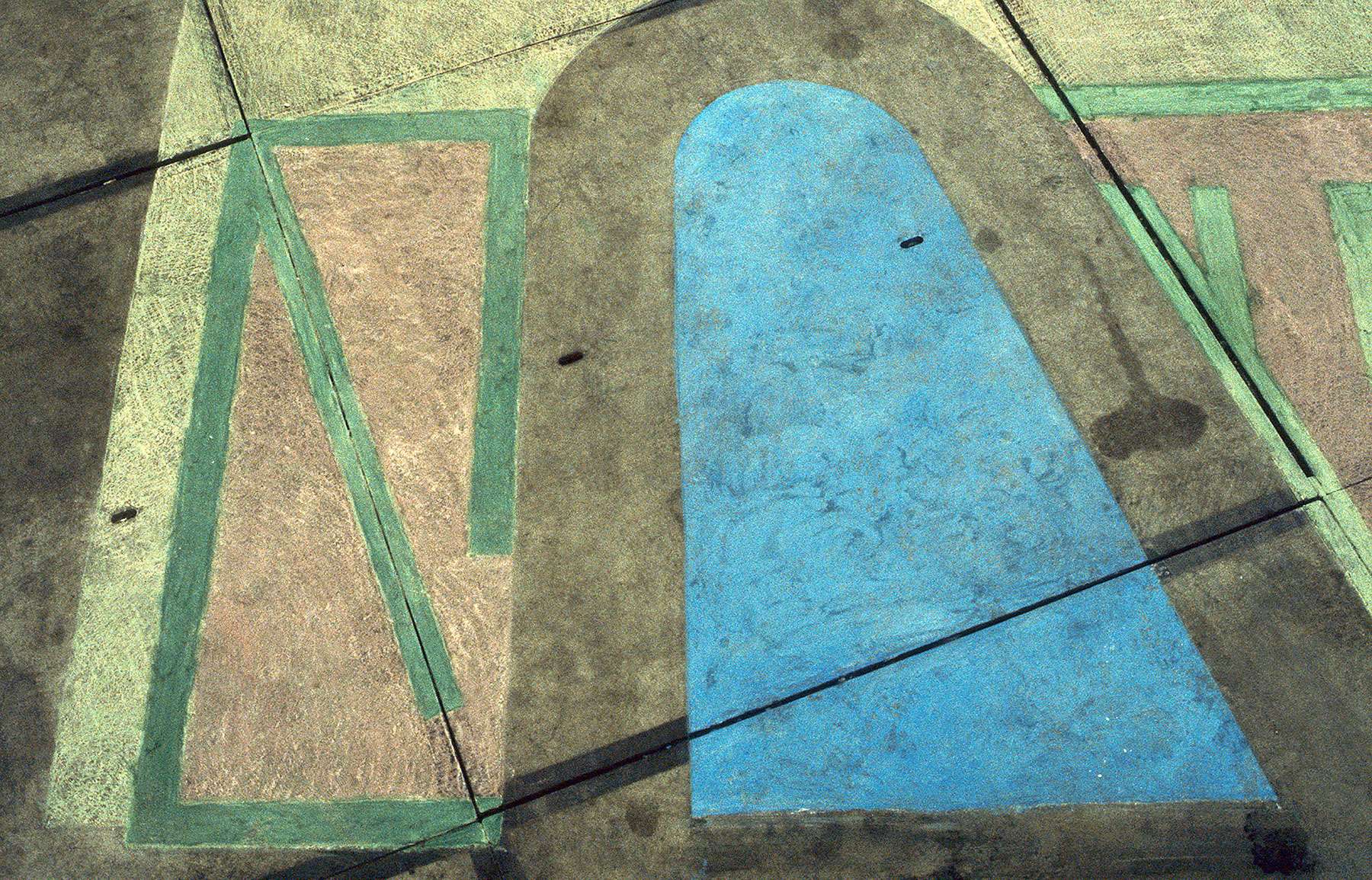
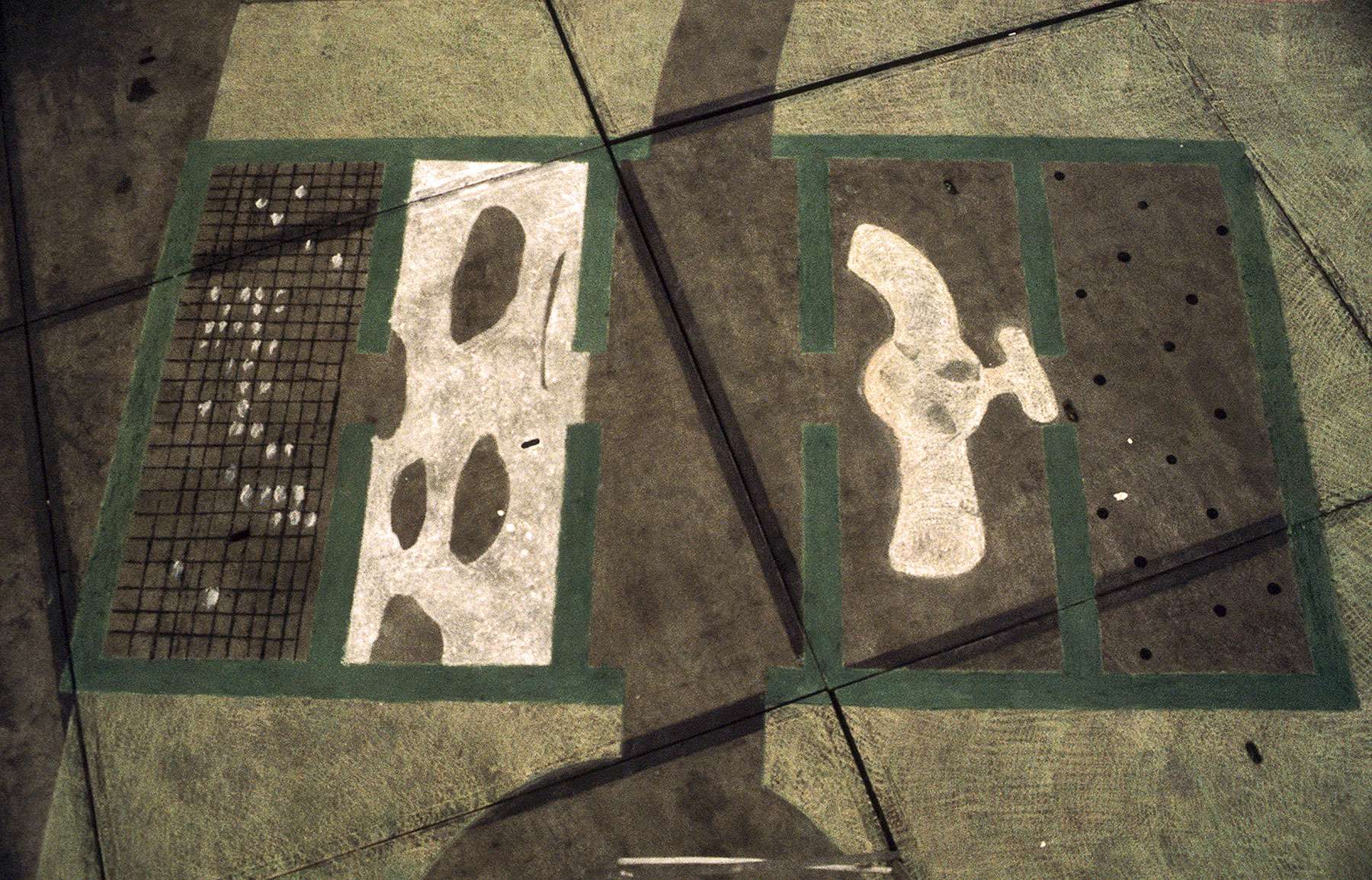
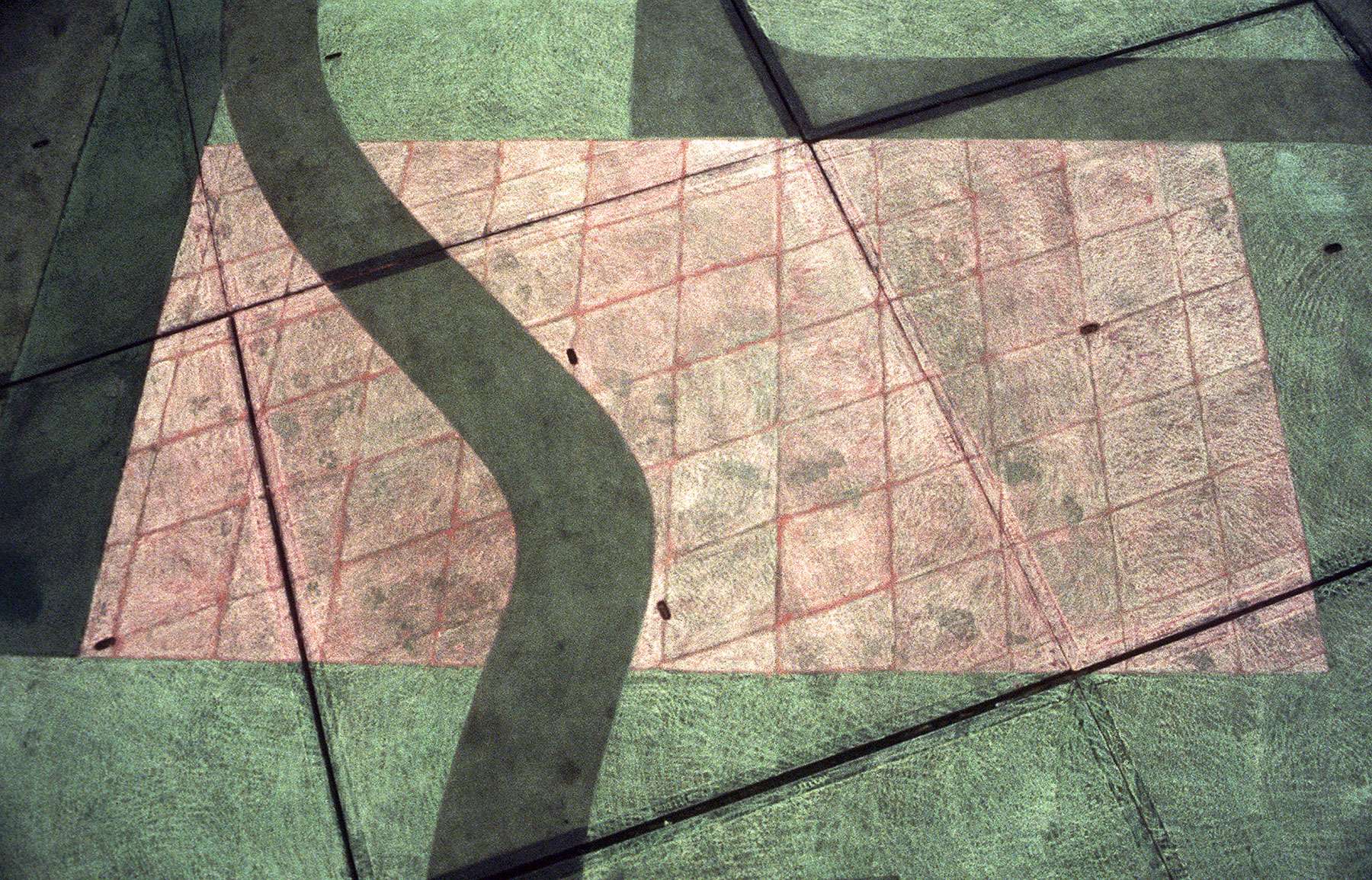
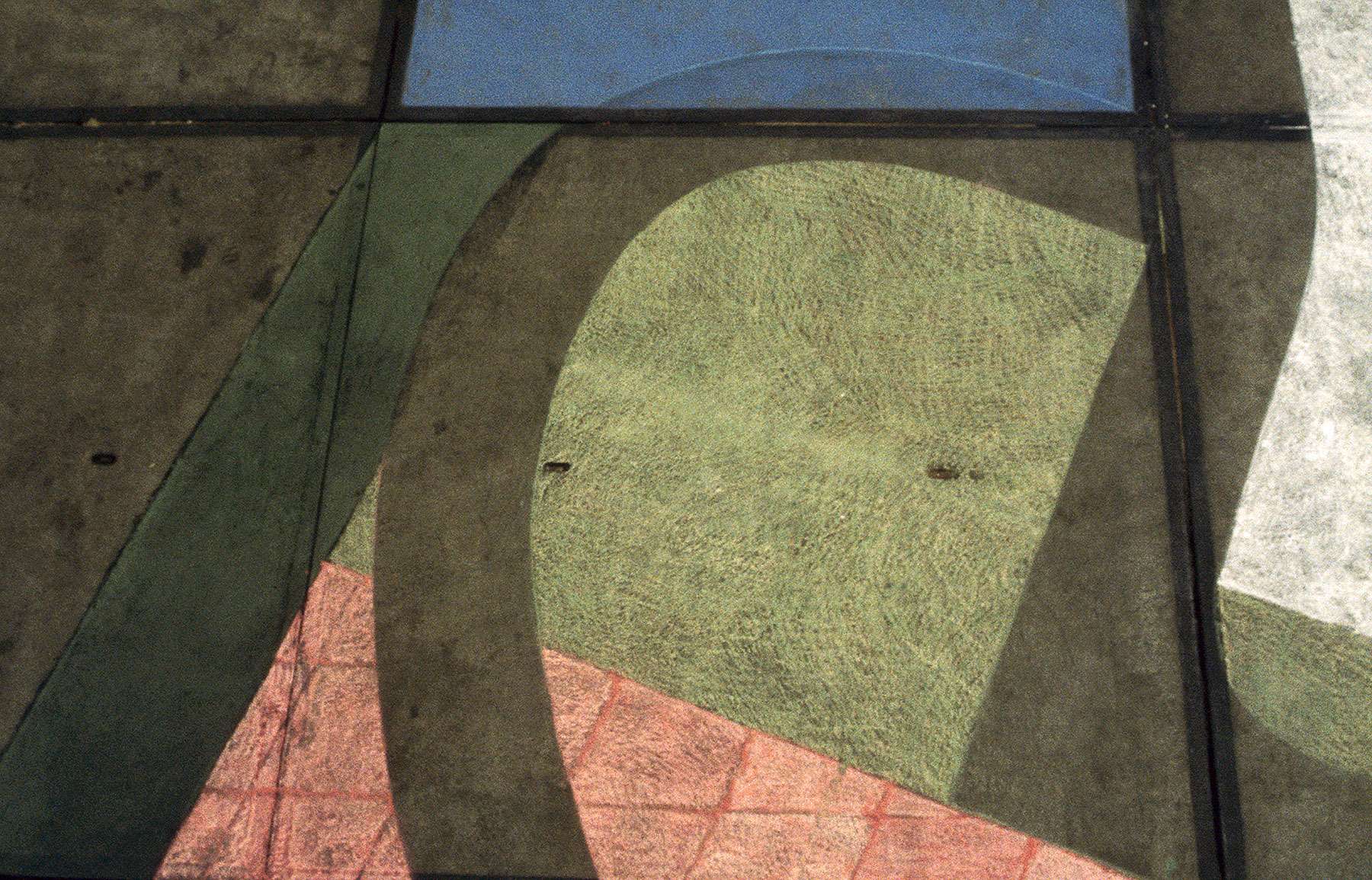
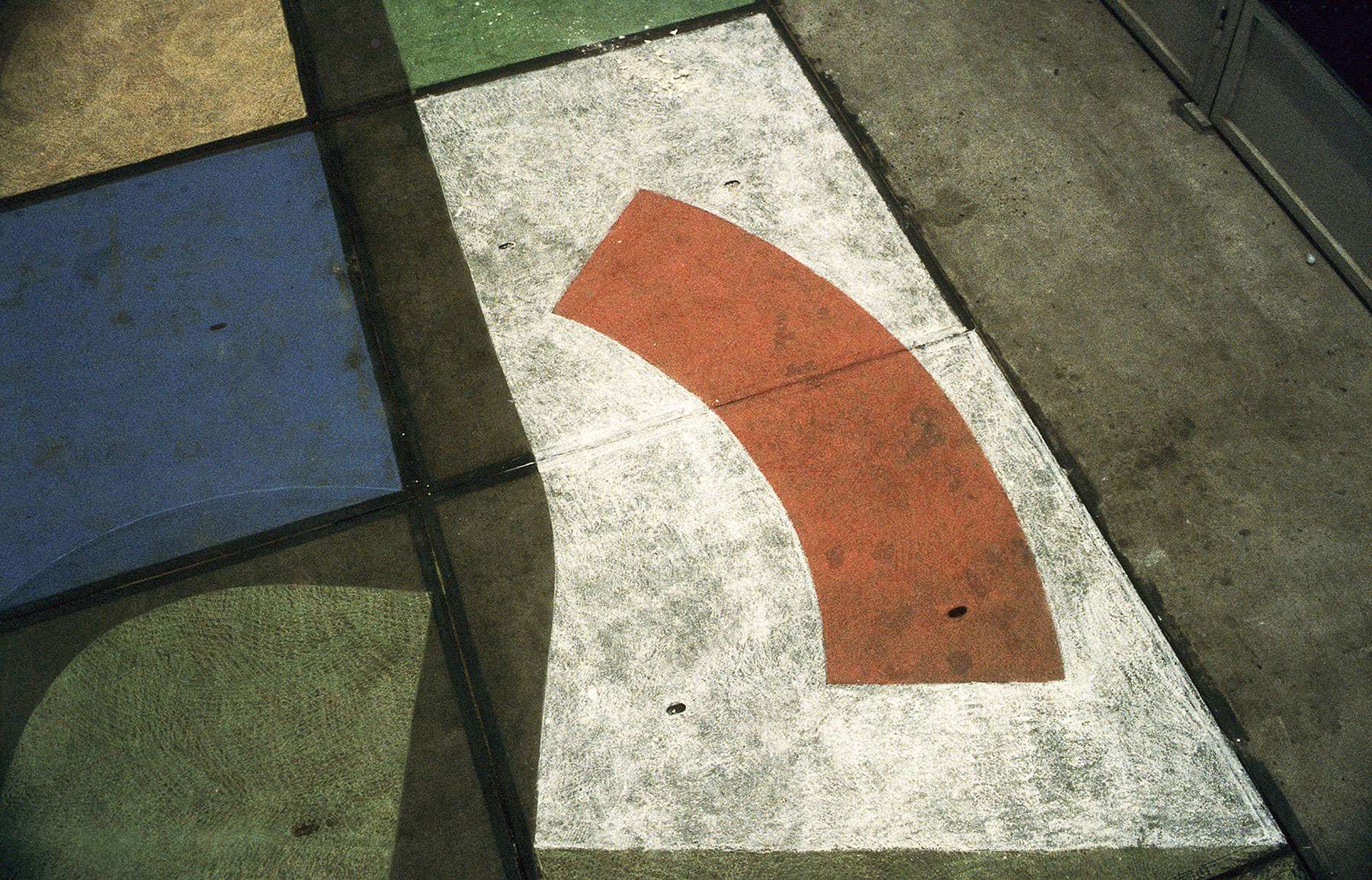
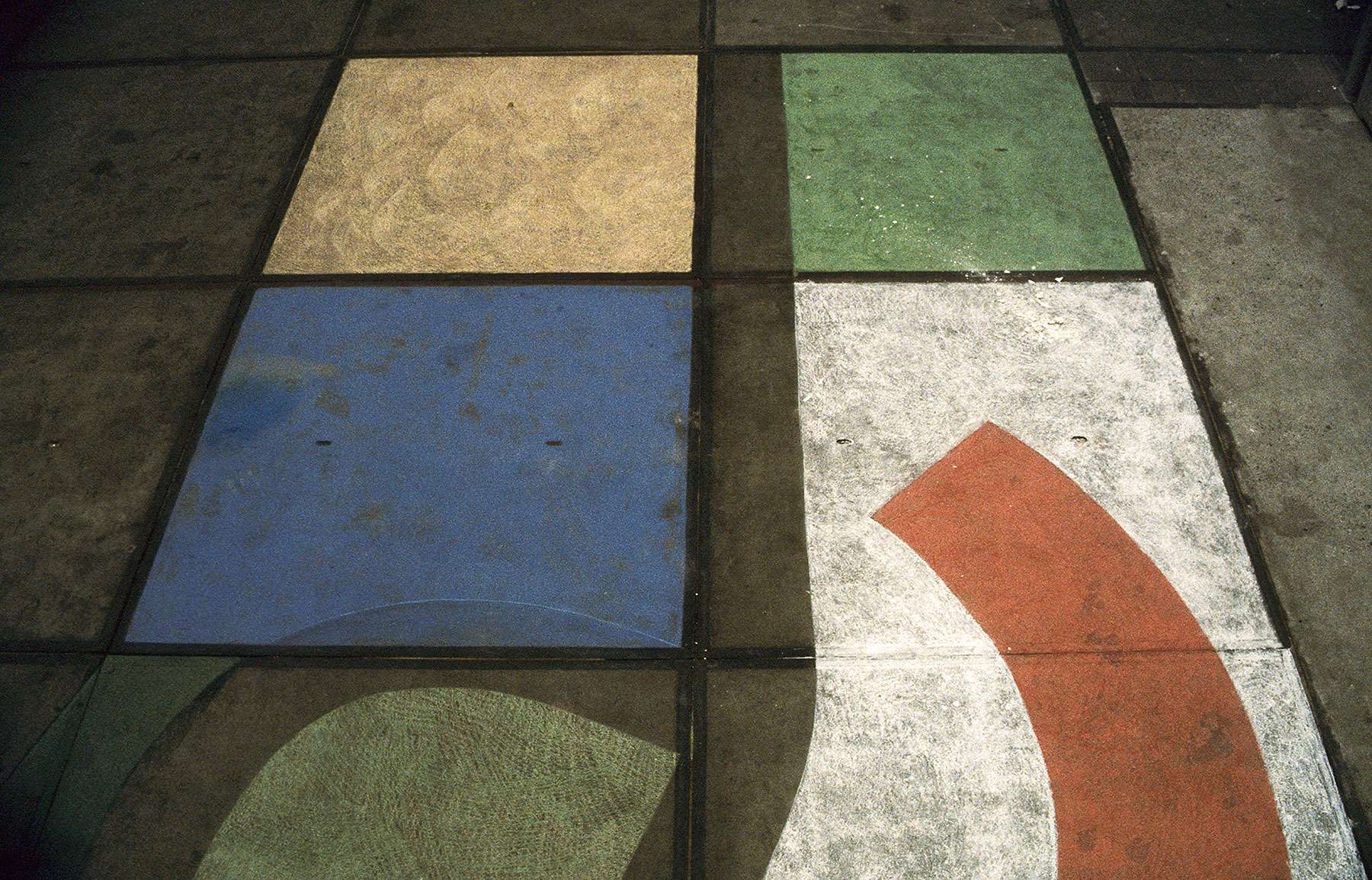 Details of Greetings from Nut & Genoegen – portable garden / sidewalk chalk / 600x1000cm / 1994
Details of Greetings from Nut & Genoegen – portable garden / sidewalk chalk / 600x1000cm / 1994
In the first part of the garden, you find the Early Renaissance garden with its maze and the Art garden with images of works from four artists from the exhibition.
The second part of the chalk garden lies in the length of the hall. Here, the theme part is indicated in the form of symbolic square patches of colour, which refer to the division into square floor slabs. In the middle, an area of parallelograms clarifies the direction build-up of the garden.
A ‘real’ path runs through the entire garden, linking the various parts with each other. The stroll through the garden gives the chalk garden its purpose: looking at the various places with your hands behind your back, meanwhile musing about the ‘big outside world’, of which every garden is a reflection.
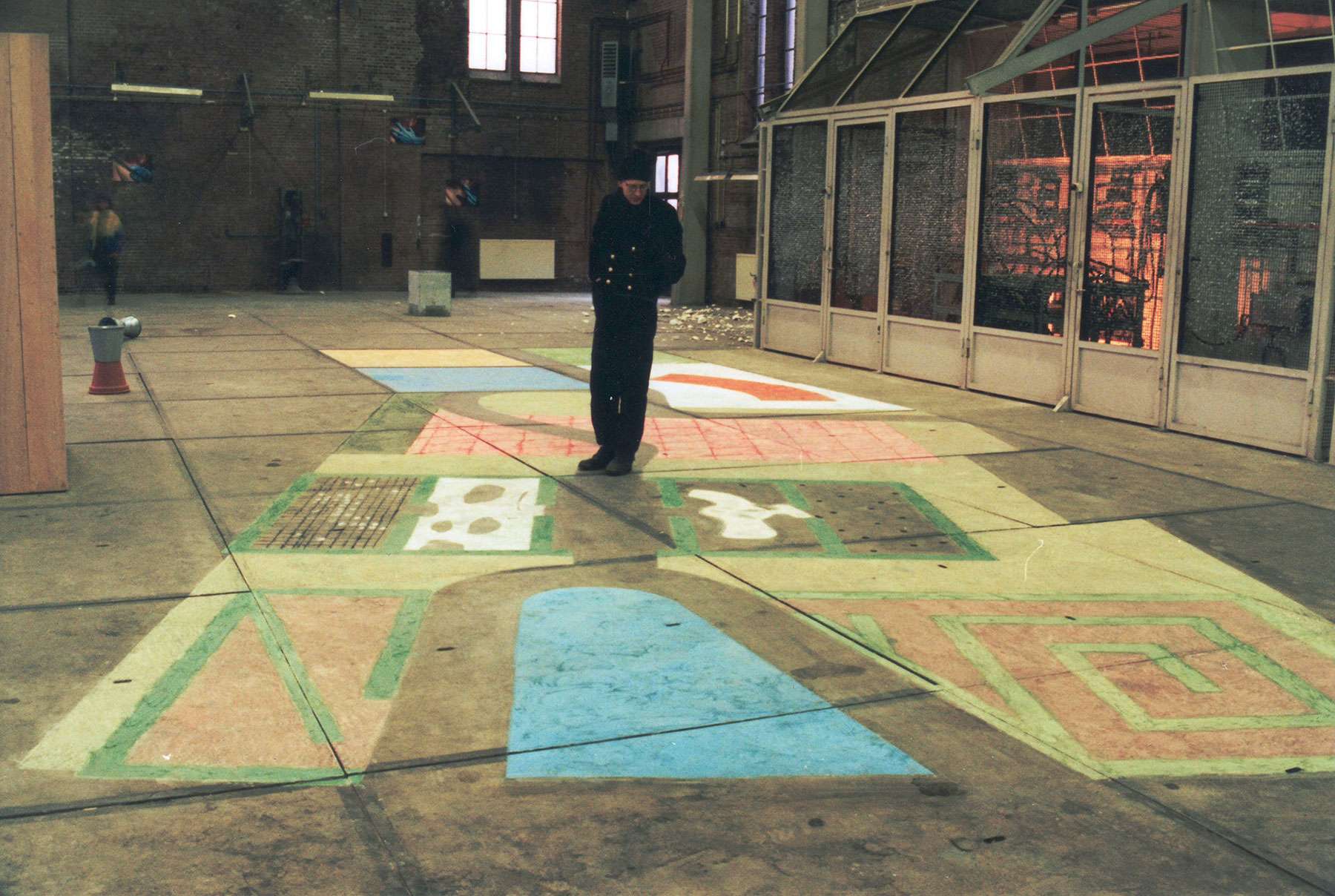 Strolling through Greetings from Nut & Genoegen – portable garden / sidewalk chalk / 600x1000cm / 1994
Strolling through Greetings from Nut & Genoegen – portable garden / sidewalk chalk / 600x1000cm / 1994
What the gardens in Greetings from Smyrna and Greetings from Nut & Genoegen have in common is that they are both nomadic. They are temporarily present at a location and can be easily moved and set up or drawn elsewhere.
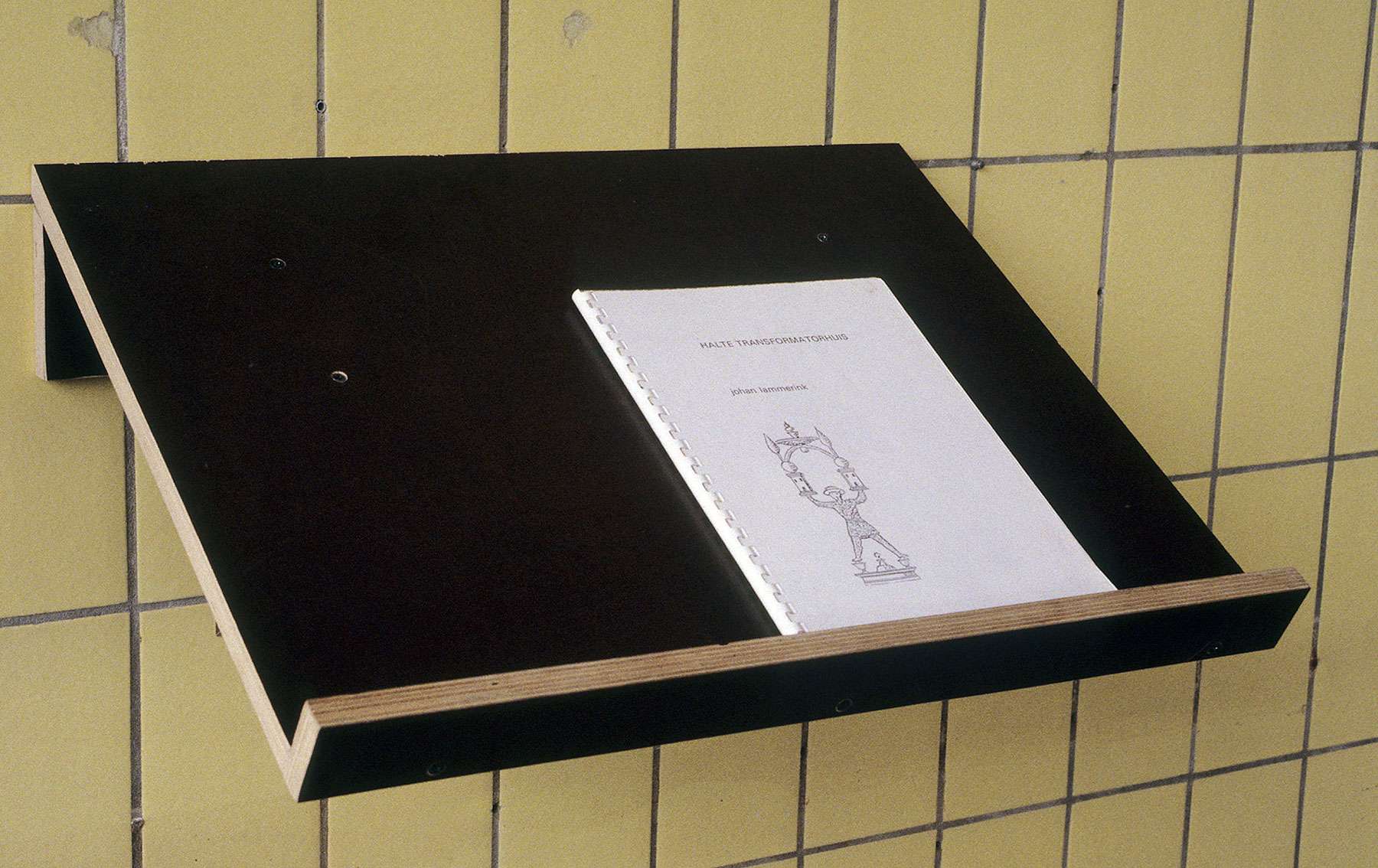 Cover Stop Transformer House / film script / 1994
Cover Stop Transformer House / film script / 1994
With the nomadic gardens, Greetings from Smyrna and Greetings from Nut & Genoegen in mind, I drafted a film script called Stop Transformer House. In the script a man associates garden elements from Greetings from Nut & Genoegen with different places in a city through which he has walked. In this nomadic road movie the man has his own accommodation with him: a rolled-up carpet with the layout of a garden, Greetings from Smyrna.
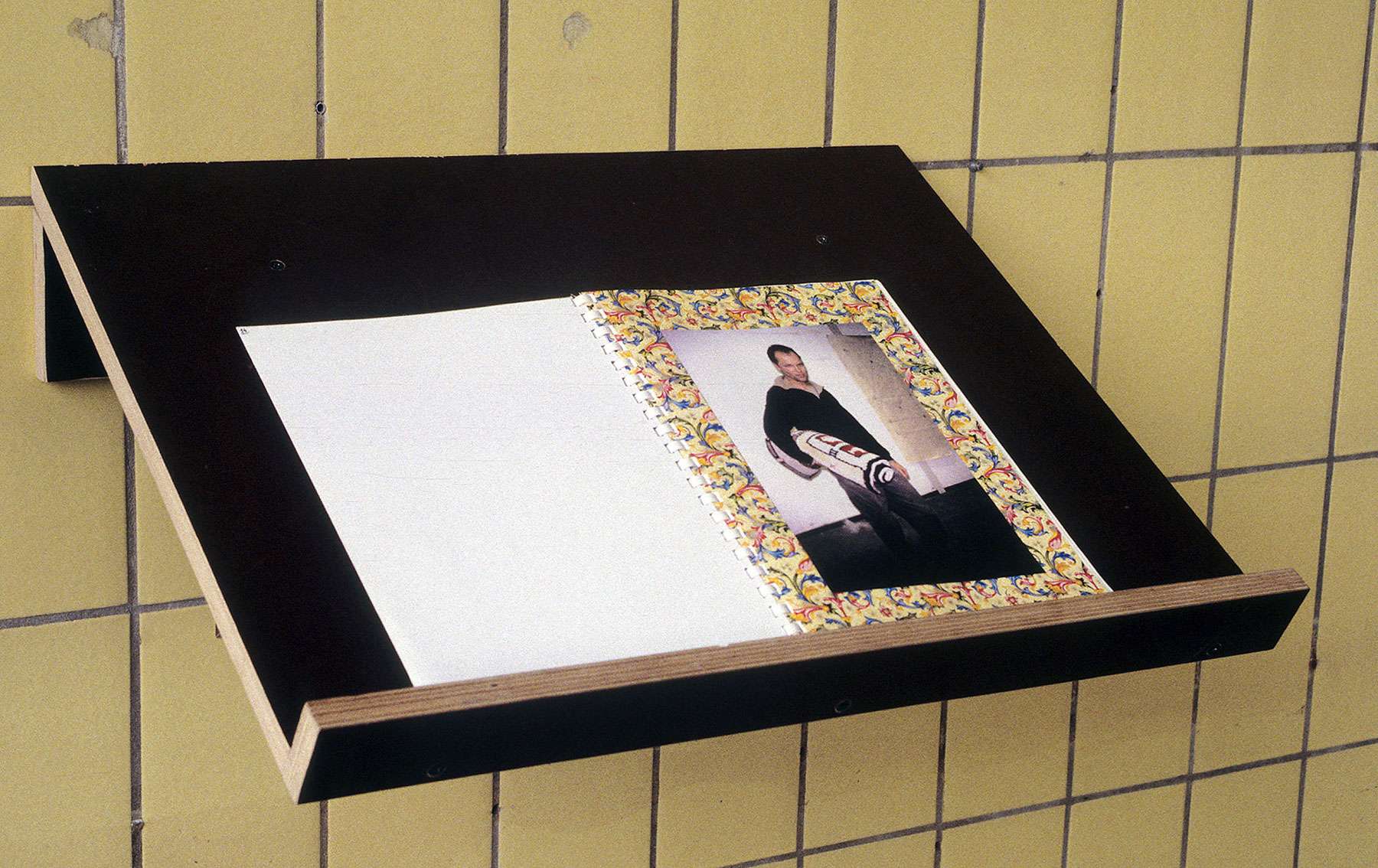 Main character with rolled-up sleeping place - frontispiece in Halte Transformatorhuis / filmscript / 1994
Main character with rolled-up sleeping place - frontispiece in Halte Transformatorhuis / filmscript / 1994
The build-up of the story is a framework story of the man in the garden, alternated with flashbacks of the man in different situations in the city. The scenes with the main in the garden are in colour, the flashbacks in the city in black and white.
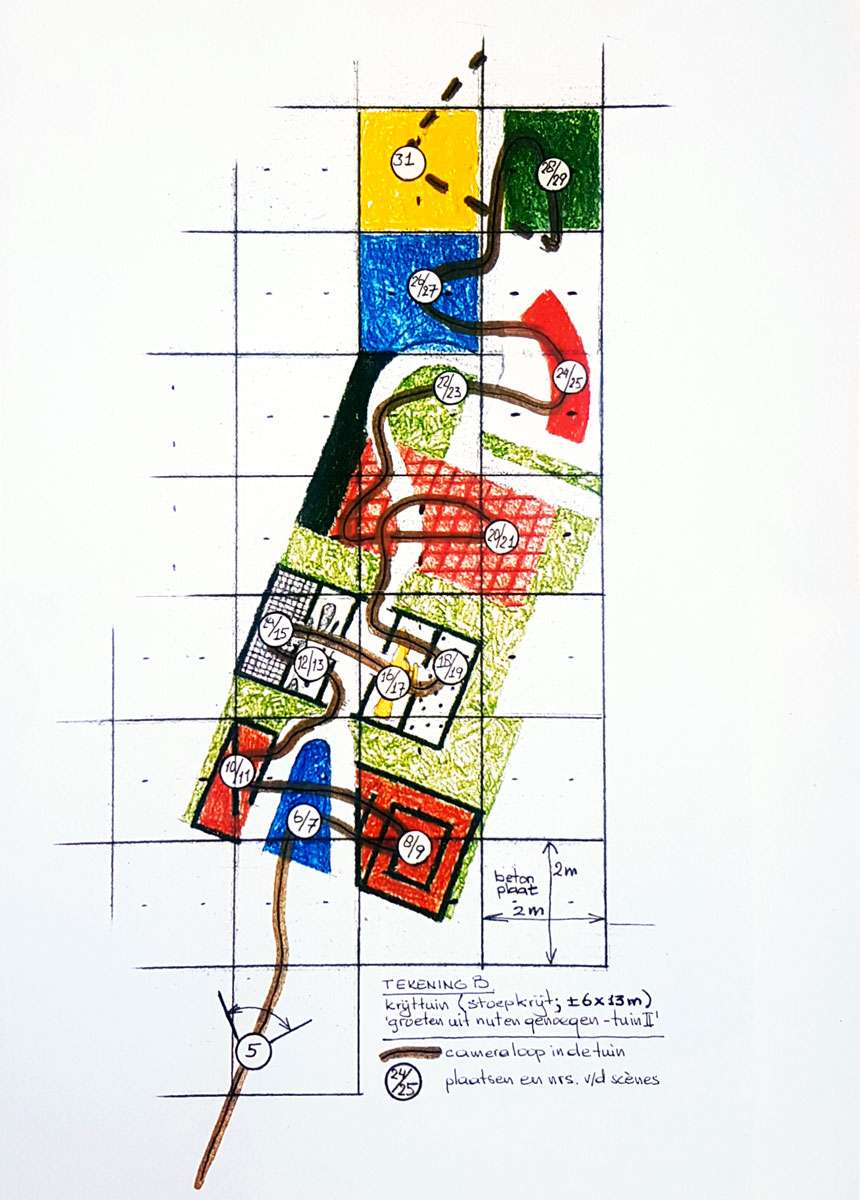 Camera walk in the chalk graden - map in Halte Transformatorhuis / filmscript / 1994
Camera walk in the chalk graden - map in Halte Transformatorhuis / filmscript / 1994
In addition to the storyline of the man’s journey, the script includes three other lines. Firstly, a short history of the garden and its development over the centuries. Then, there are different short quotes and anecdotes from a variety of sources. These relate to the journeys and gardens. Finally, spread over the whole script, there are dozens of images printed from the unique book Polyphemus’s dream by Francesco Colonna, a Dominican friar from the 15th-16th century. Some of the quotes and images can be found on the separate page Stop Transformer House.
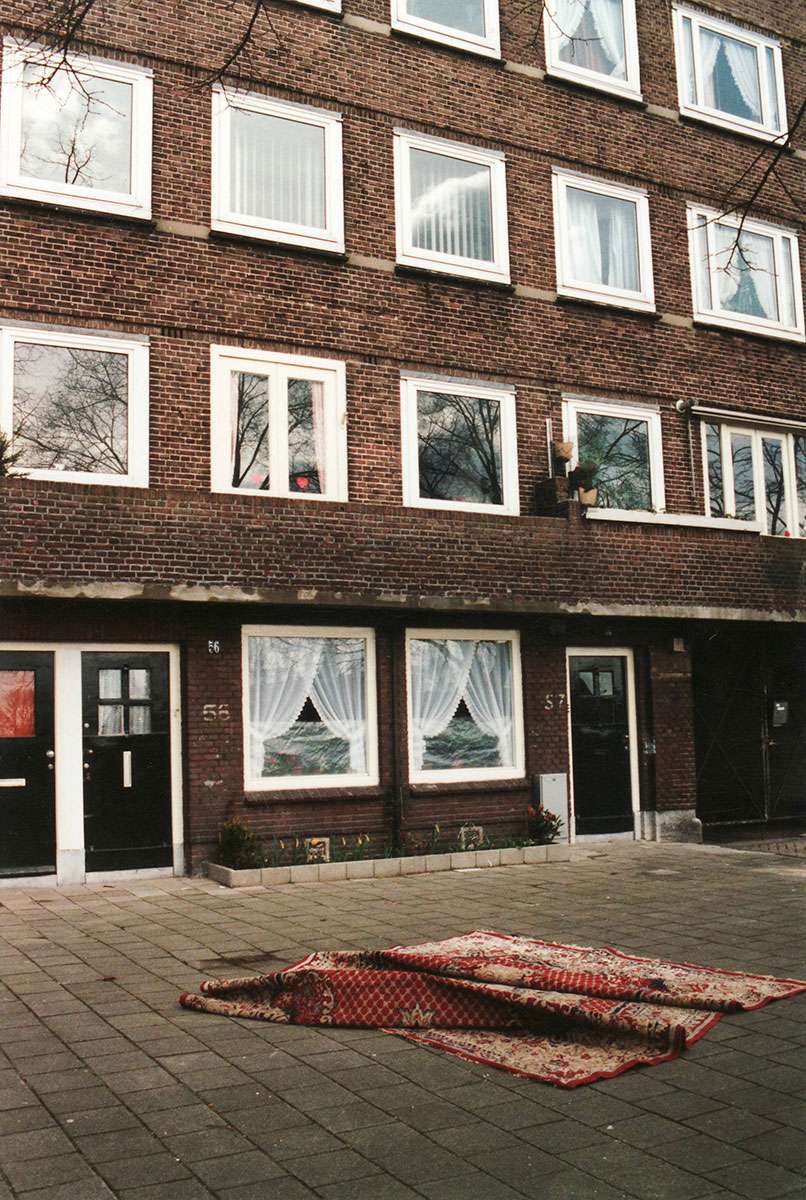
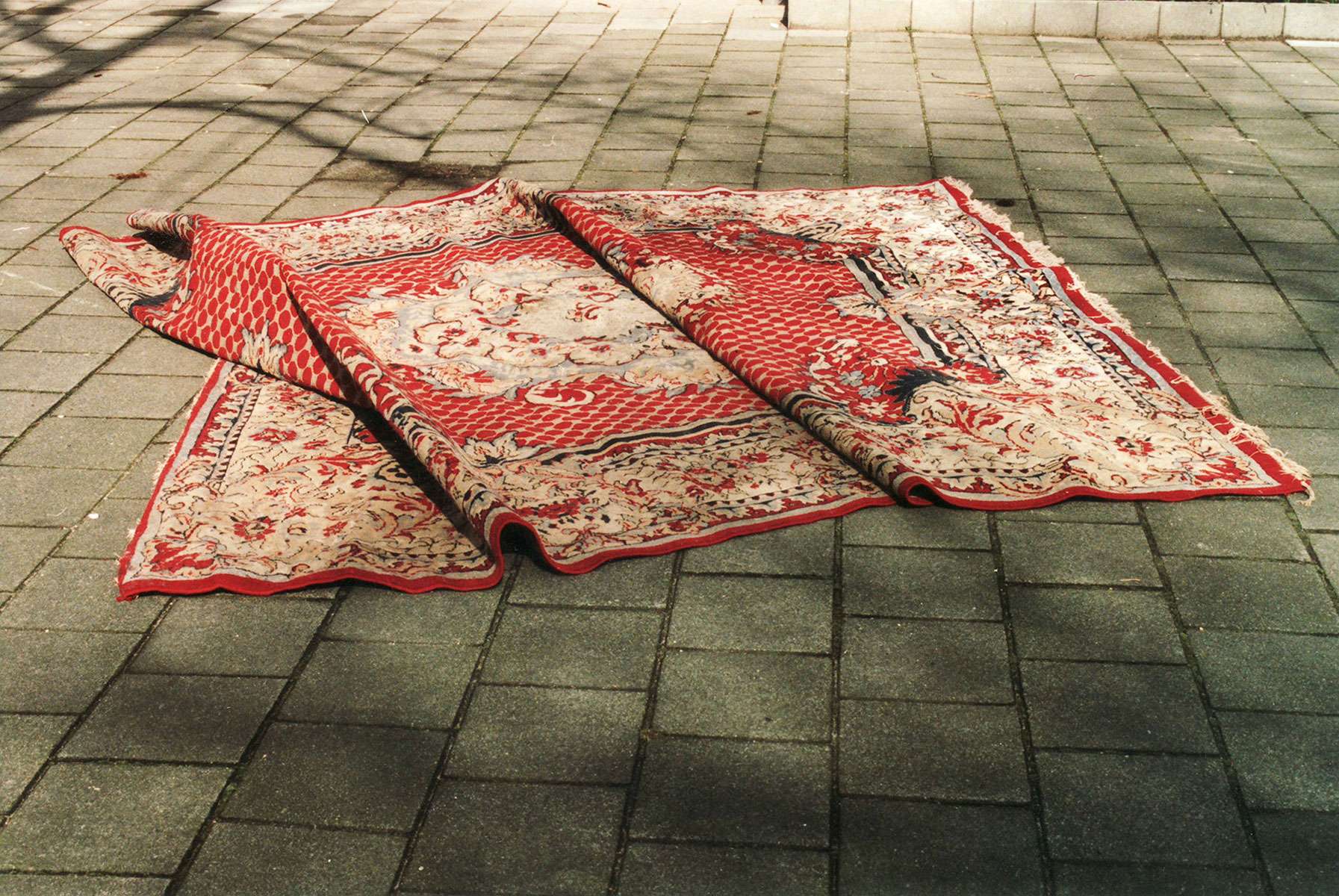
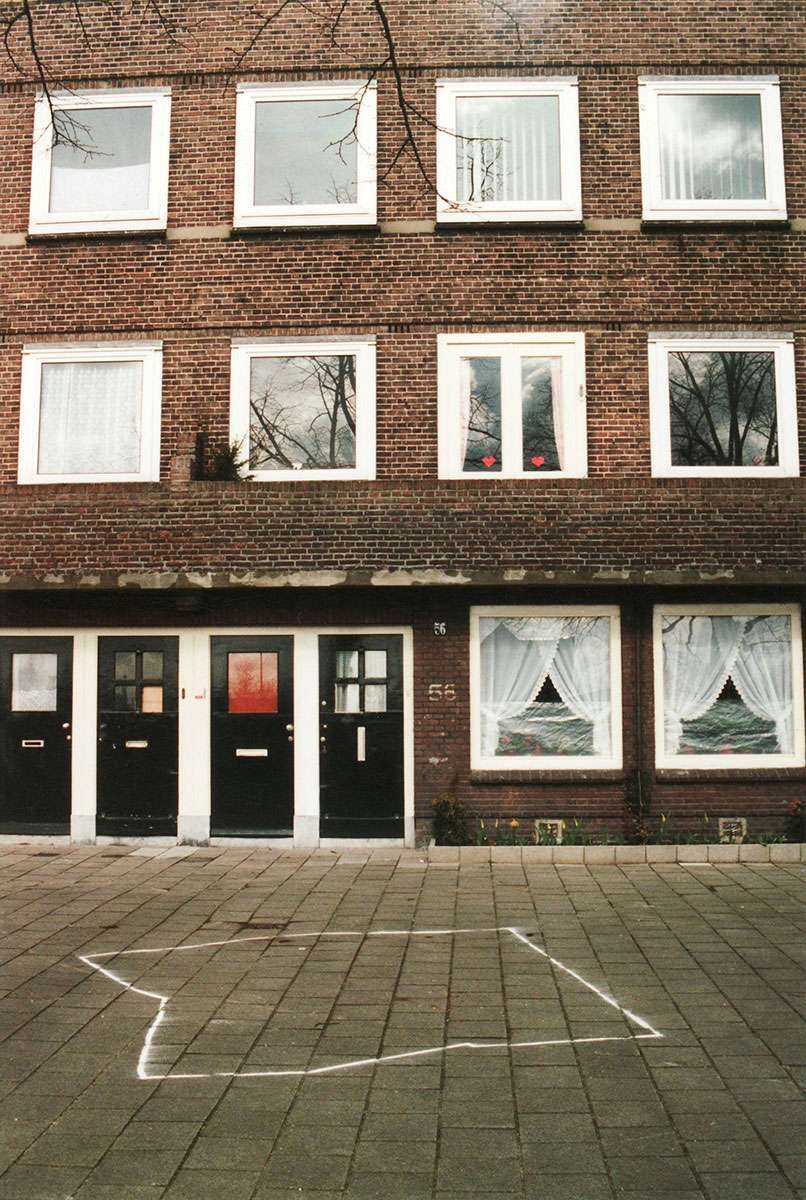 Greetings from the East Indies neighbourhood – Valentijnkade / photos / various sizes / 1994
Greetings from the East Indies neighbourhood – Valentijnkade / photos / various sizes / 1994
For a while I took photos of carpets that had been thrown on the street, in my own neighbourhood in Amsterdam. You can see by the types of carpet that this is a multi-cultural neighbourhood. I recorded the discarded carpets and also the environment.
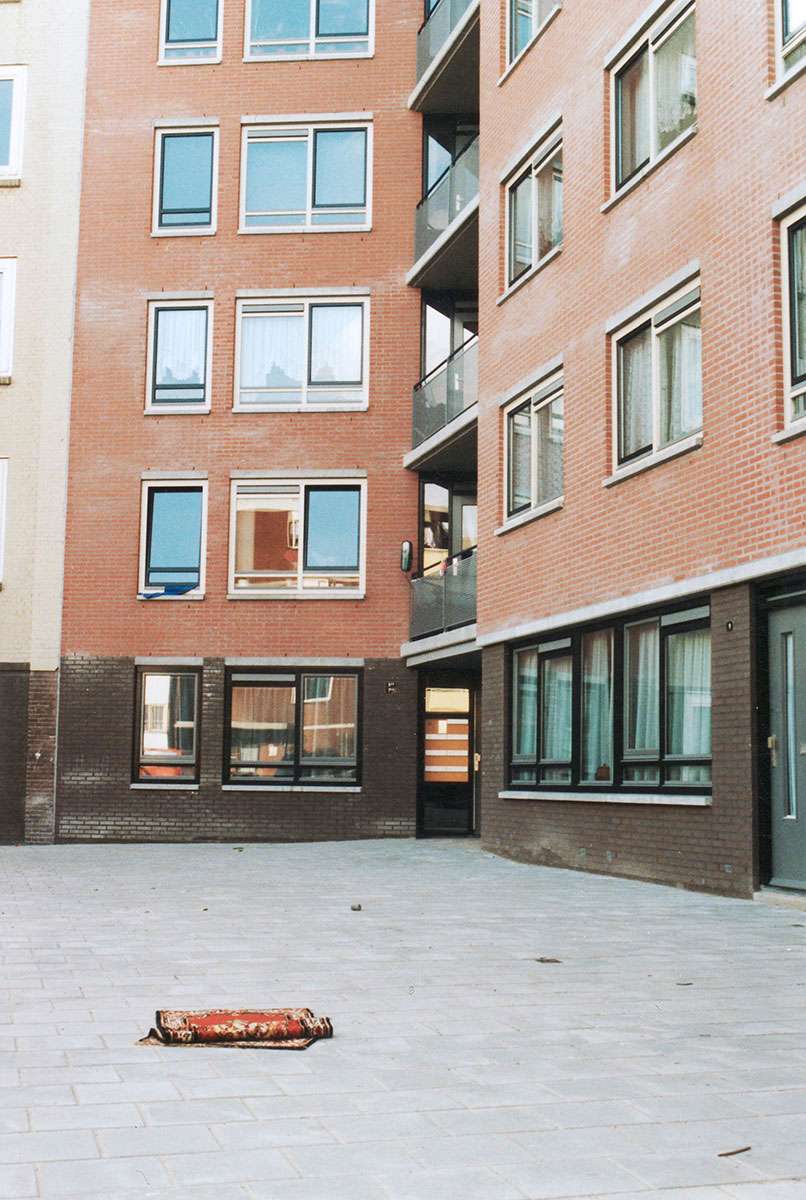
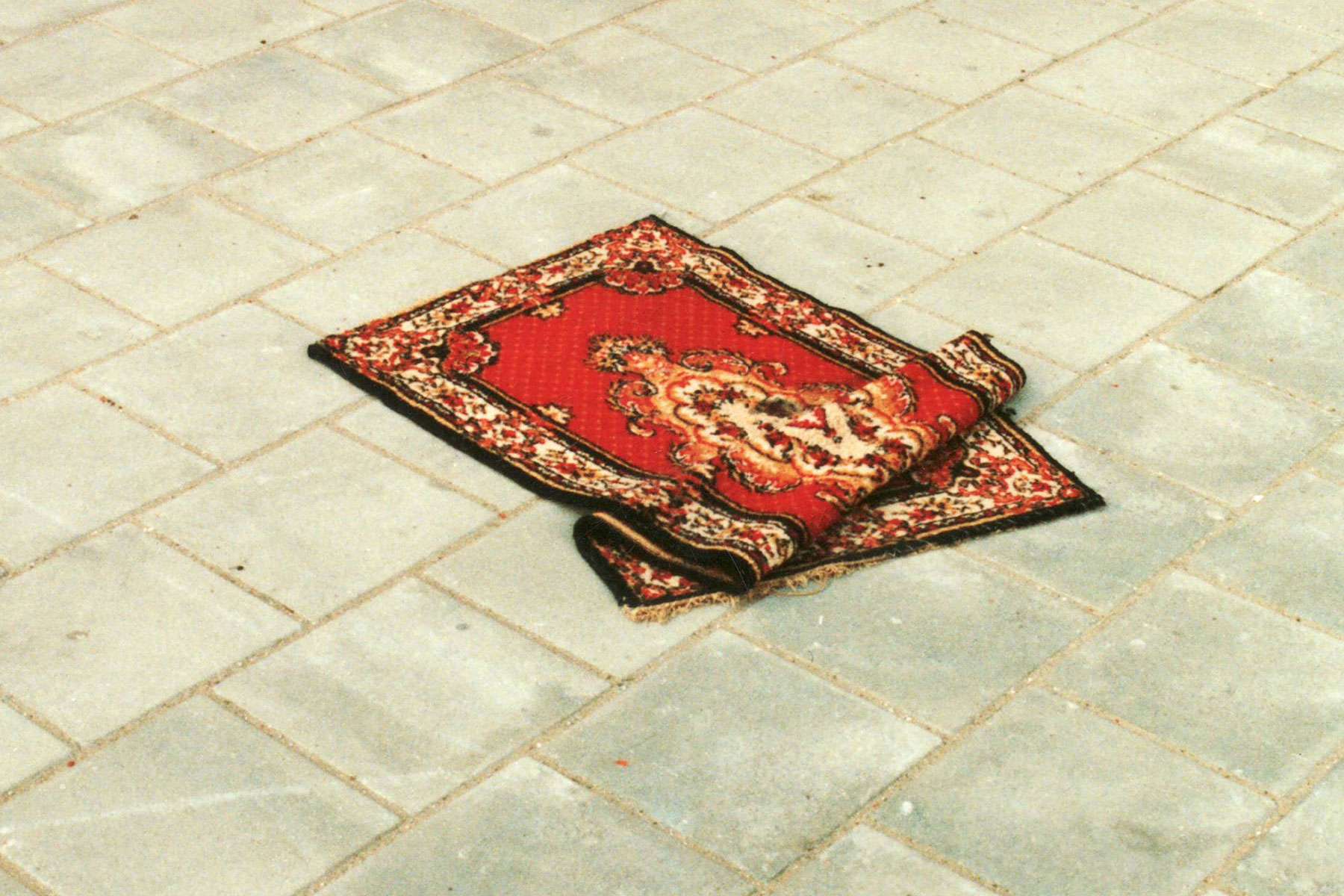
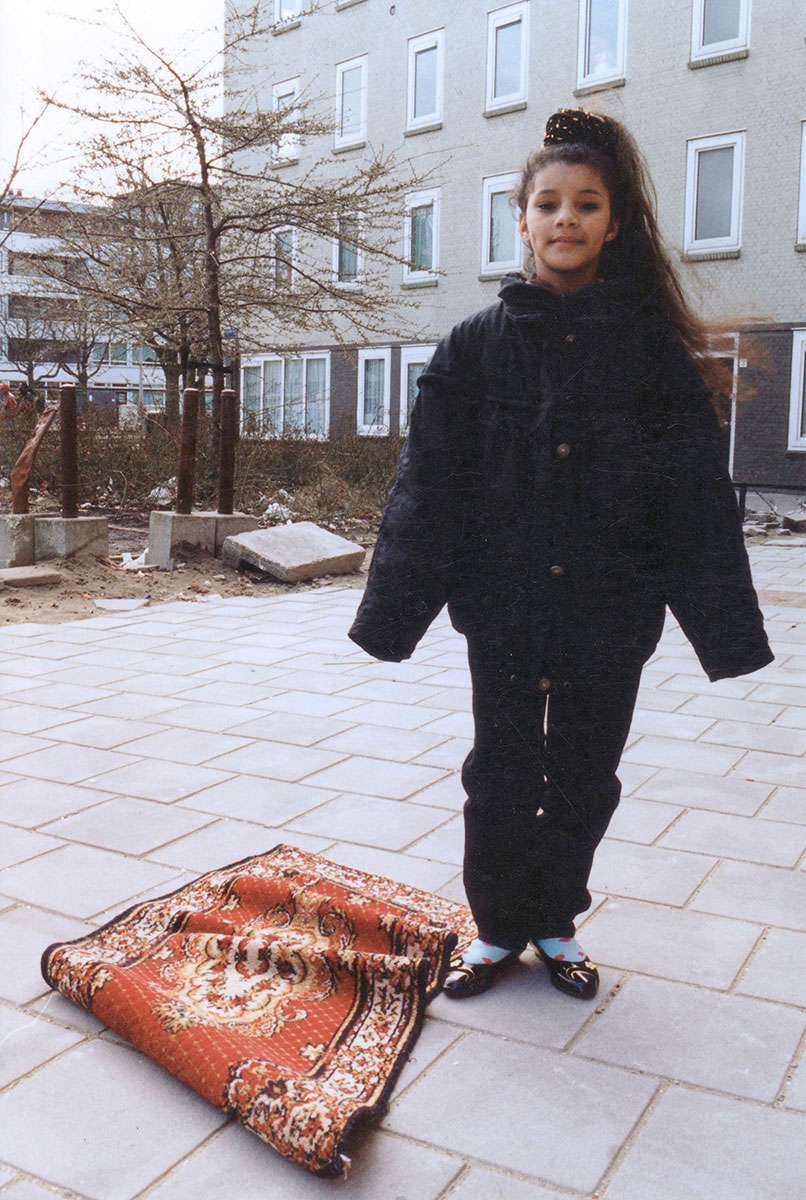
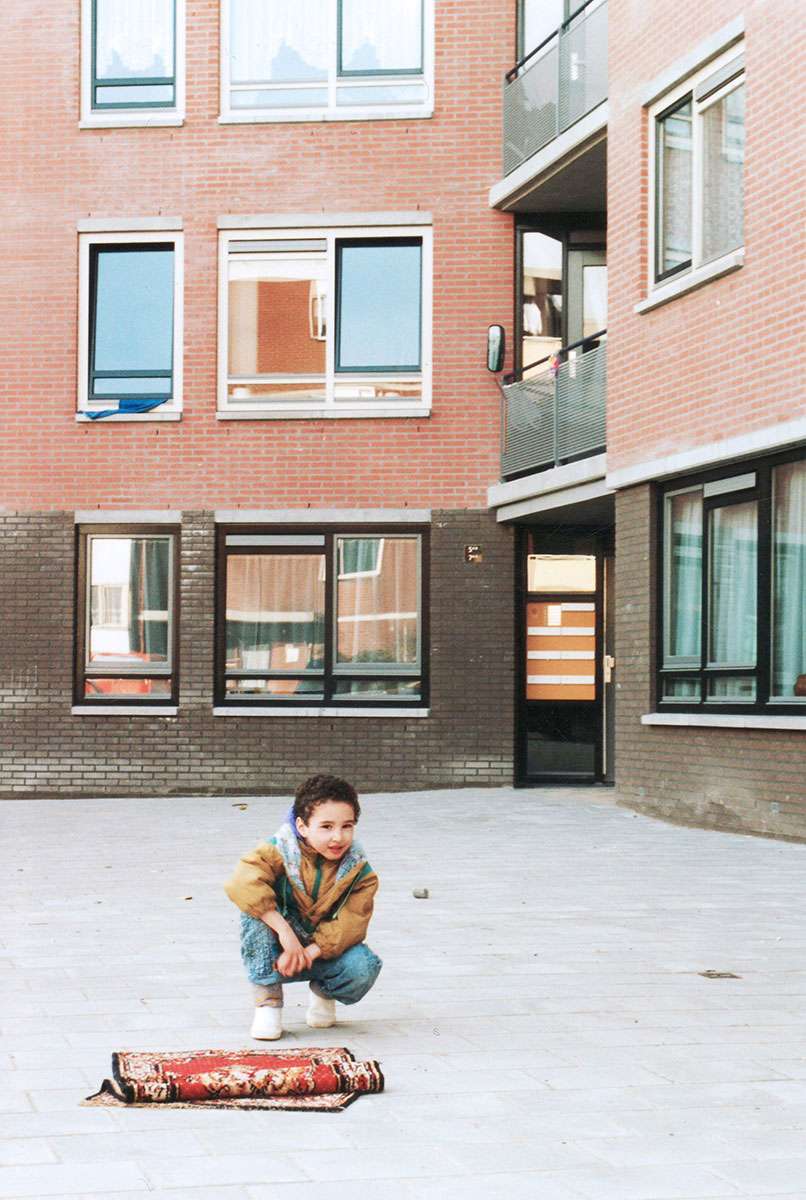 Greetings from the East Indies neighbourhood – Riouwstraat / photos / various sizes / 1994
Greetings from the East Indies neighbourhood – Riouwstraat / photos / various sizes / 1994
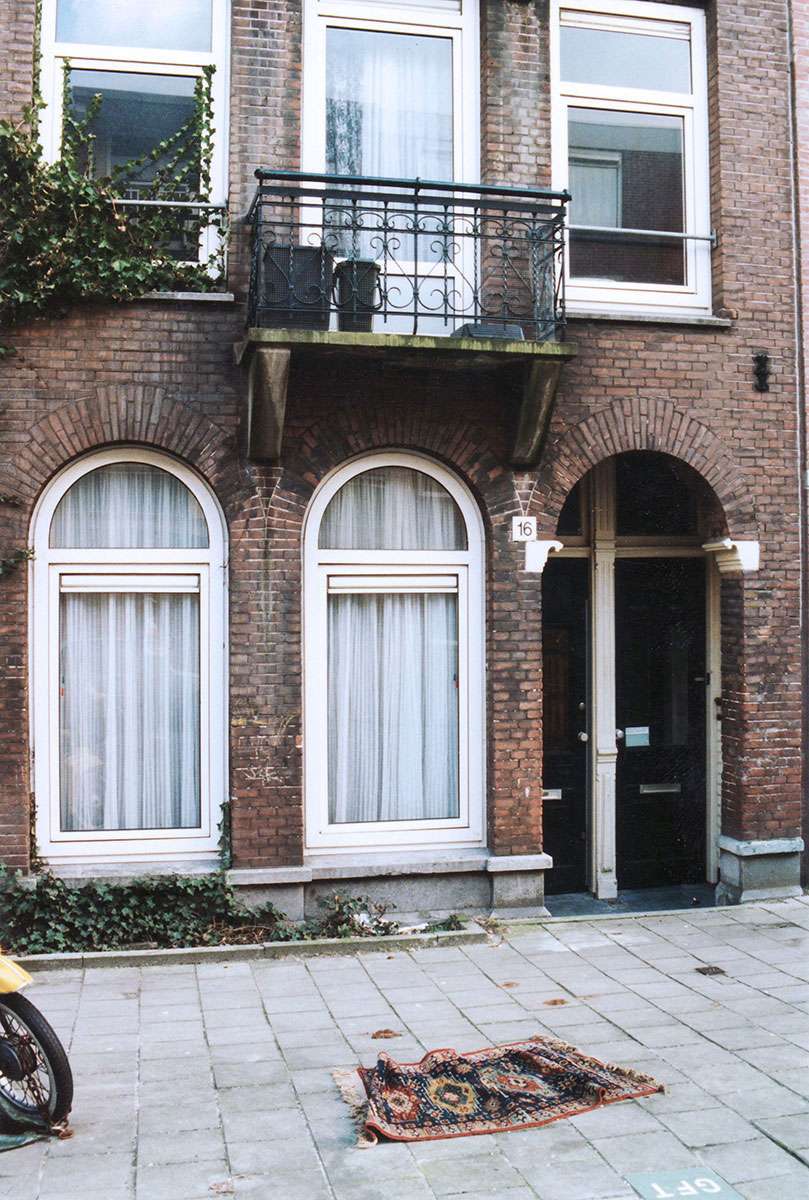

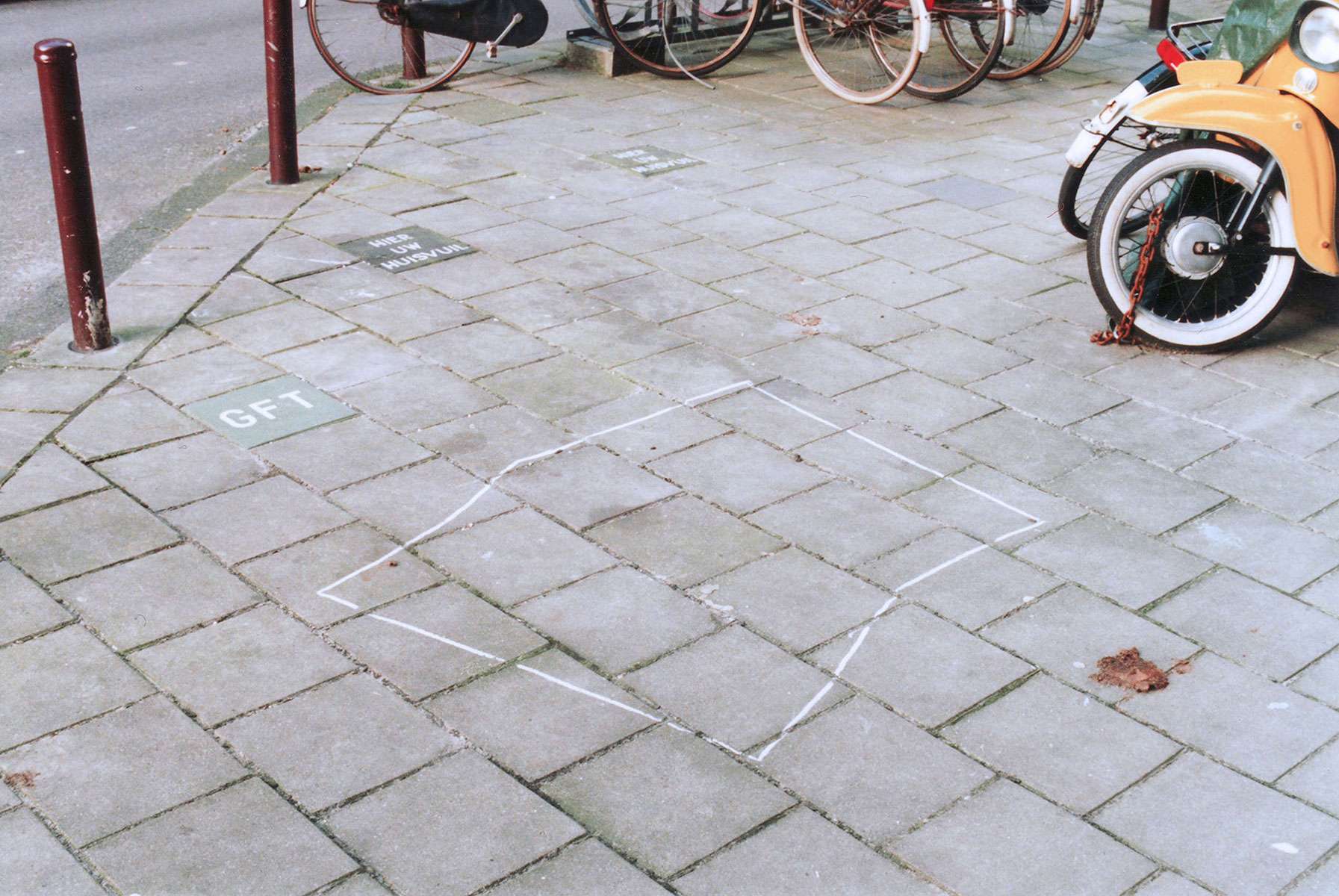 Greetings from the East Indies neighbourhood – Tweede Atjehstraat / photos / various sizes / 1994
Greetings from the East Indies neighbourhood – Tweede Atjehstraat / photos / various sizes / 1994
For the owners/residents, this is where they say goodbye to their carpets. I have consistently recorded the last position of the carpets by drawing a chalk line around them. After marking the farewell position, I rolled up the carpets and took them with me.
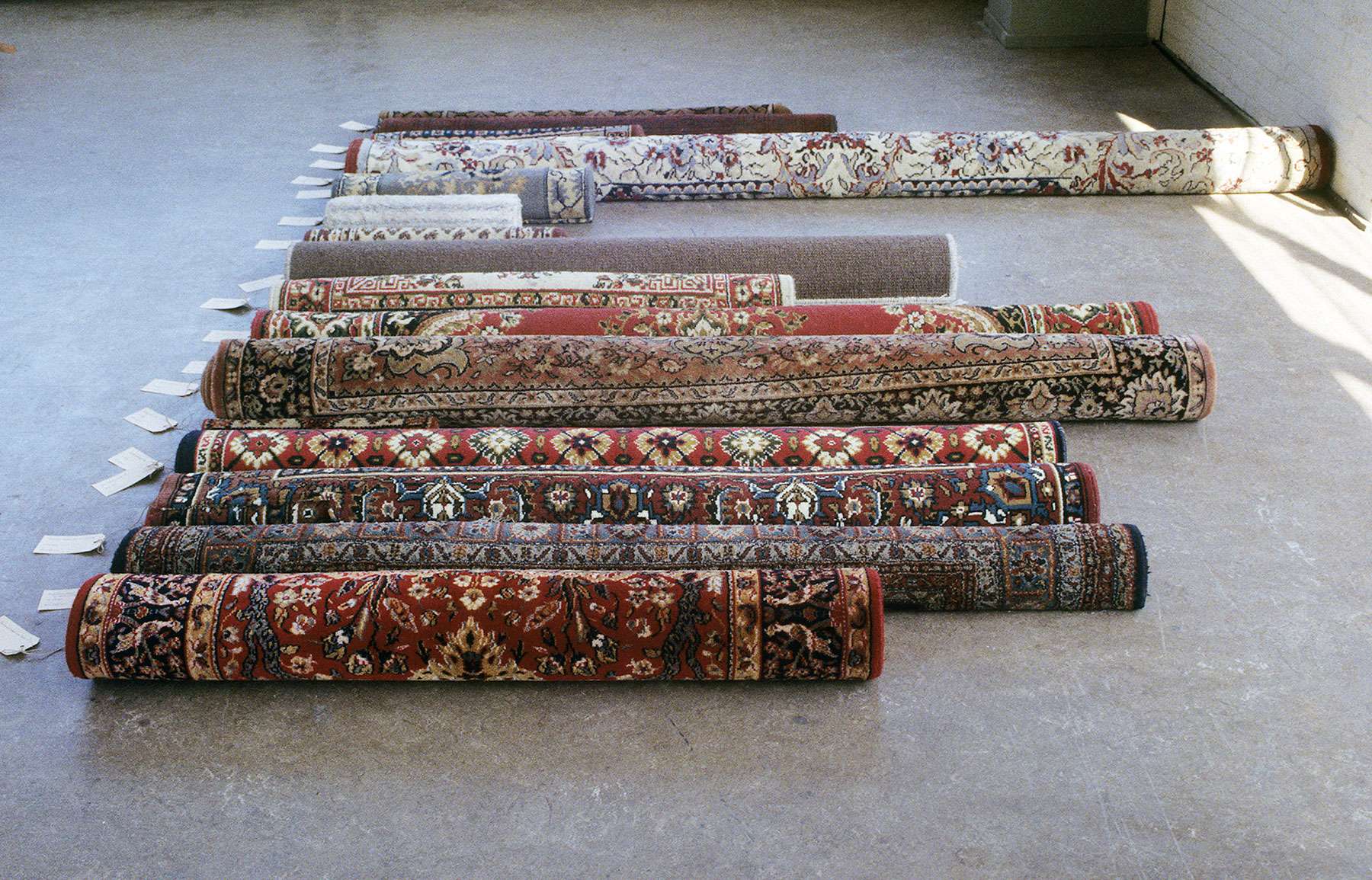
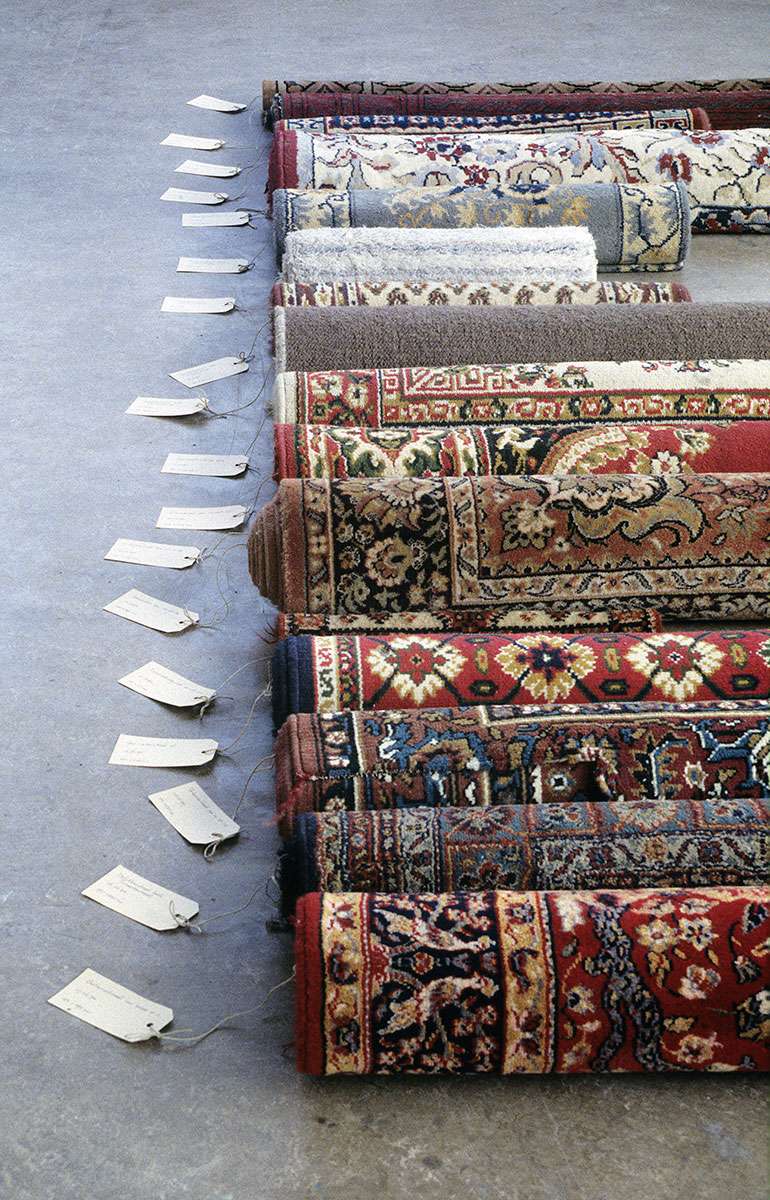
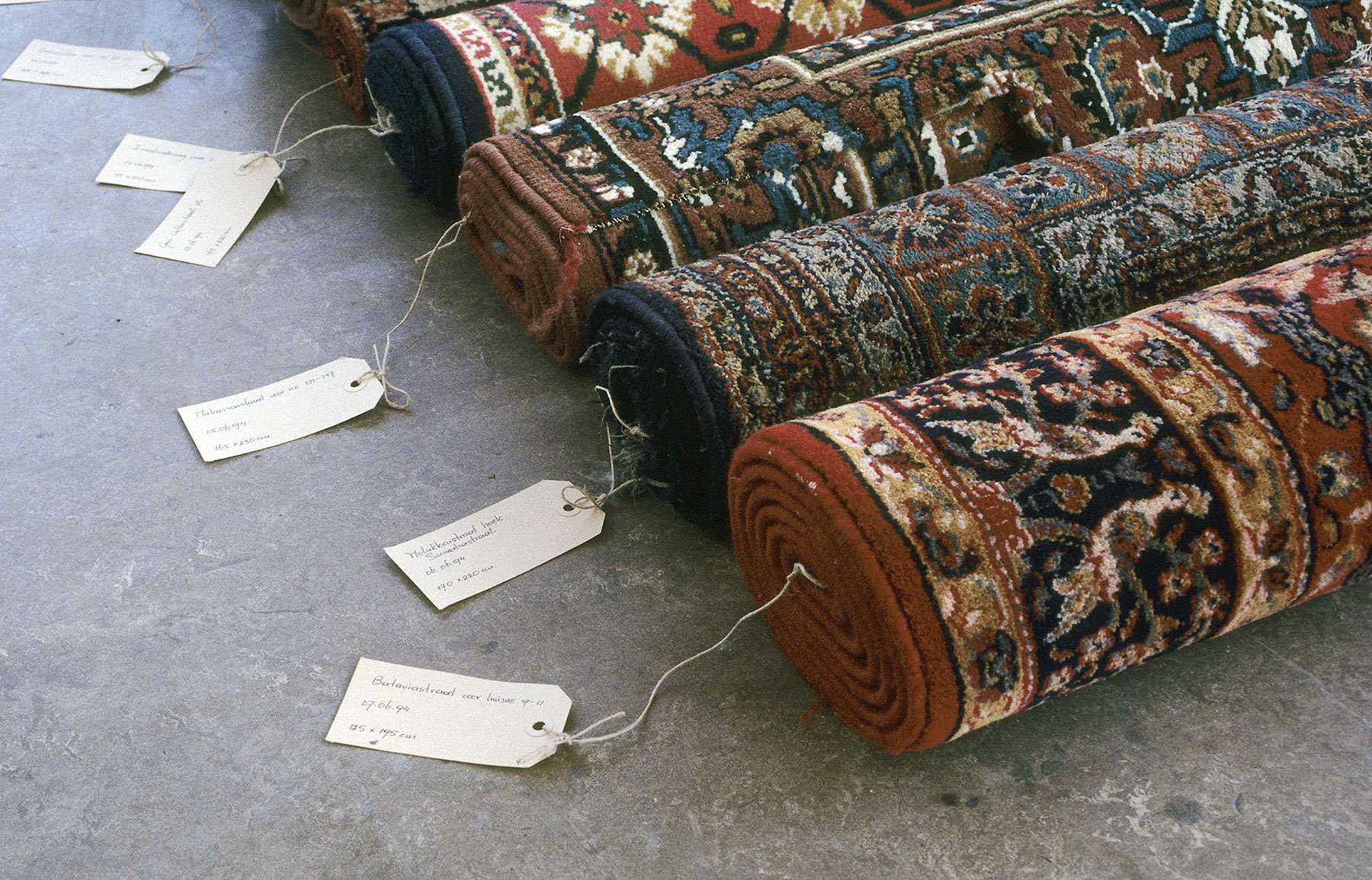 Greetings from the East Indies neighbourhood / old carpets, rope, paper / various sizes / 1994
Greetings from the East Indies neighbourhood / old carpets, rope, paper / various sizes / 1994
The carpets all carry obvious traces of use. People have lived with them. Most of the carpets probably lay on the floor, but this is also a neighbourhood where they may have lain on the table. Signs of wear and tear and discoloration show where owners/residents have walked over them, where furniture stood and which parts were exposed to light.
Carpets from Greetings from the East Indies neighbourhood / old carpets, rope, paper / various sizes / 1994
Below a studio photo.
 Studio photo which includes Your own place, Greetings from the East Indies neighbourhood and Passage
Studio photo which includes Your own place, Greetings from the East Indies neighbourhood and Passage

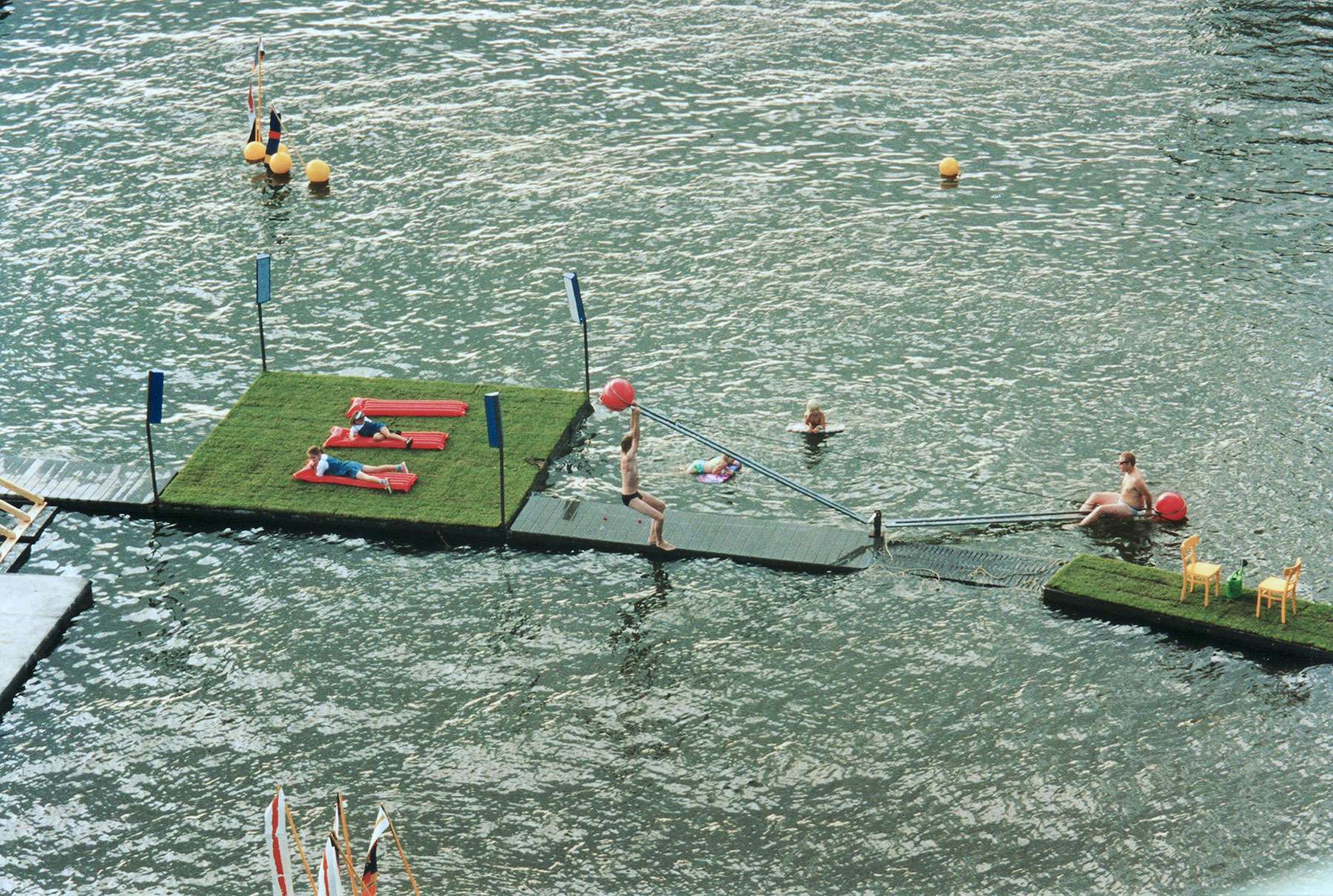
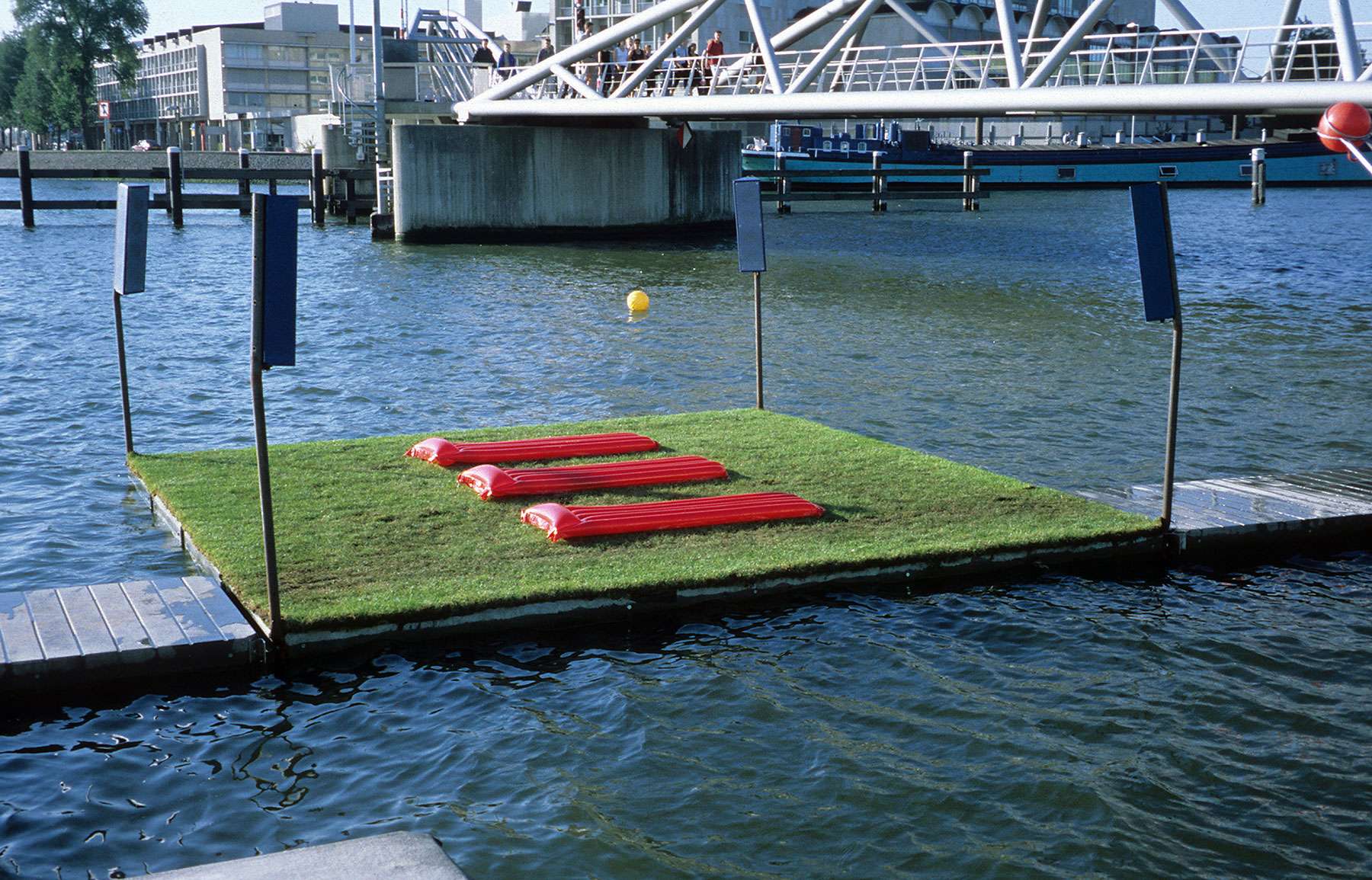
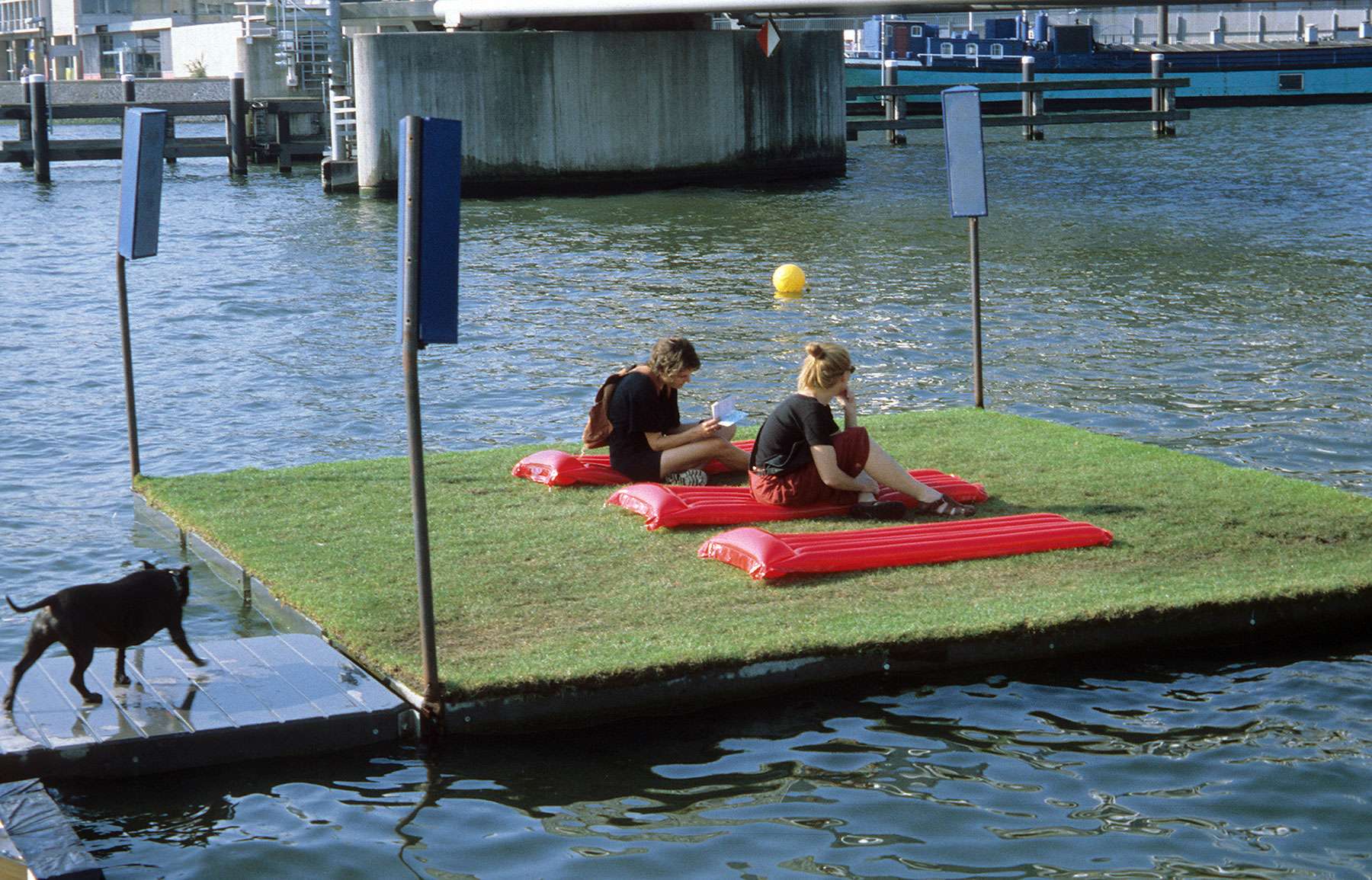
 Greetings from IJ-City / in cooperation with Leta Spooren in the Oosterdok, Amsterdam / concrete floaters, grass, plastic air beds, CD players, speakers, metal / 650x650x200cm / 1999 / photos AT, JL
Greetings from IJ-City / in cooperation with Leta Spooren in the Oosterdok, Amsterdam / concrete floaters, grass, plastic air beds, CD players, speakers, metal / 650x650x200cm / 1999 / photos AT, JL
Group exhibition Y-city, floating squares, Oosterdok, Amsterdam
In the context of the creation of the new islands near Amsterdam – IJburg district – Ontwerpers A’dam organized a workshop about the use of public space that is under pressure. In the accompanying manifestation, Y-City – floating squares on the water in the Oosterdok in Amsterdam, the use of floating public space was explored.
Under the title, Greetings from IJ-City Leta Spooren and I participated with a floating sound boxing ring. Our starting point was: every explanatory adjective added to ‘space’ in an urban environment causes a fight.
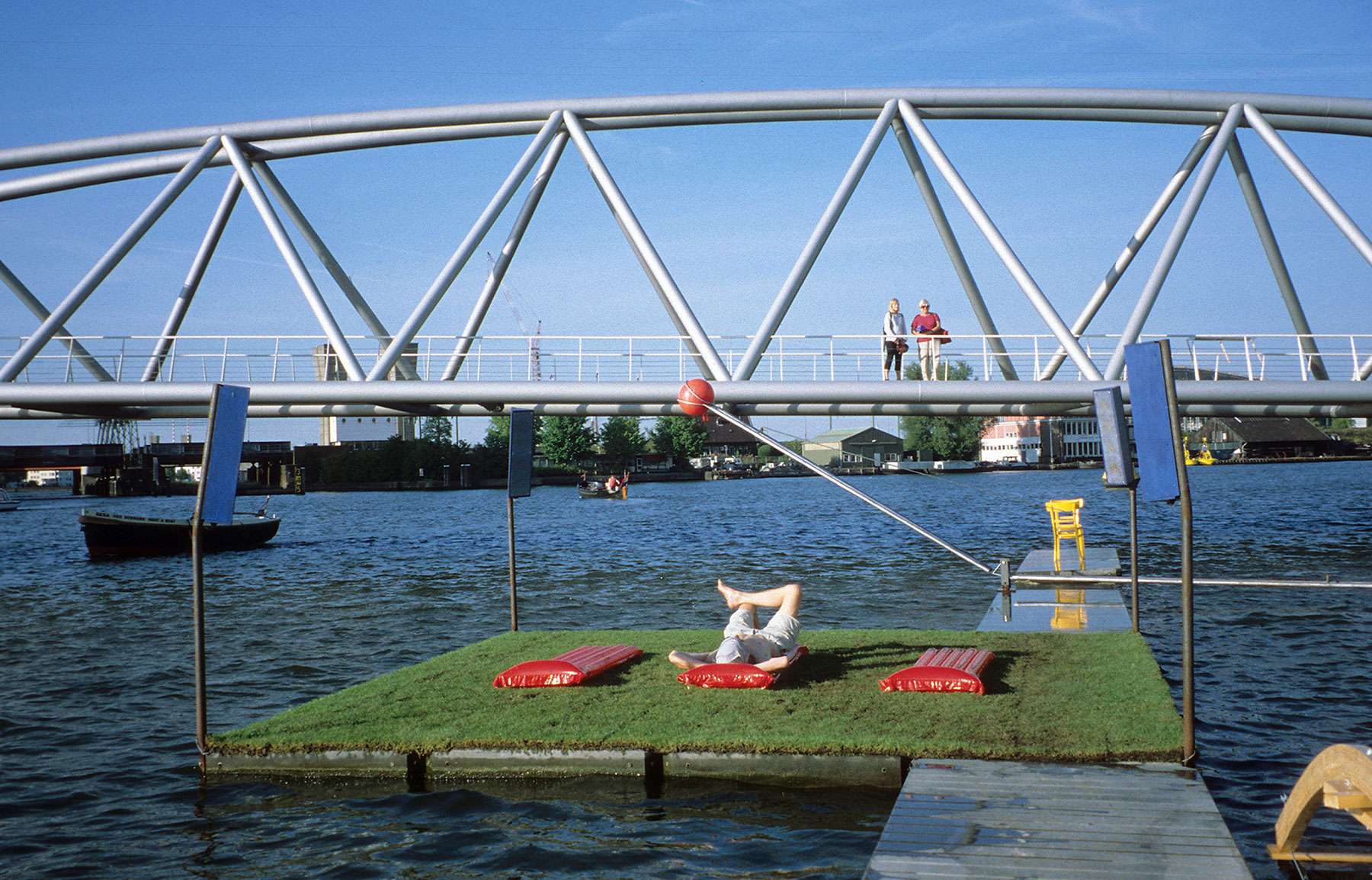
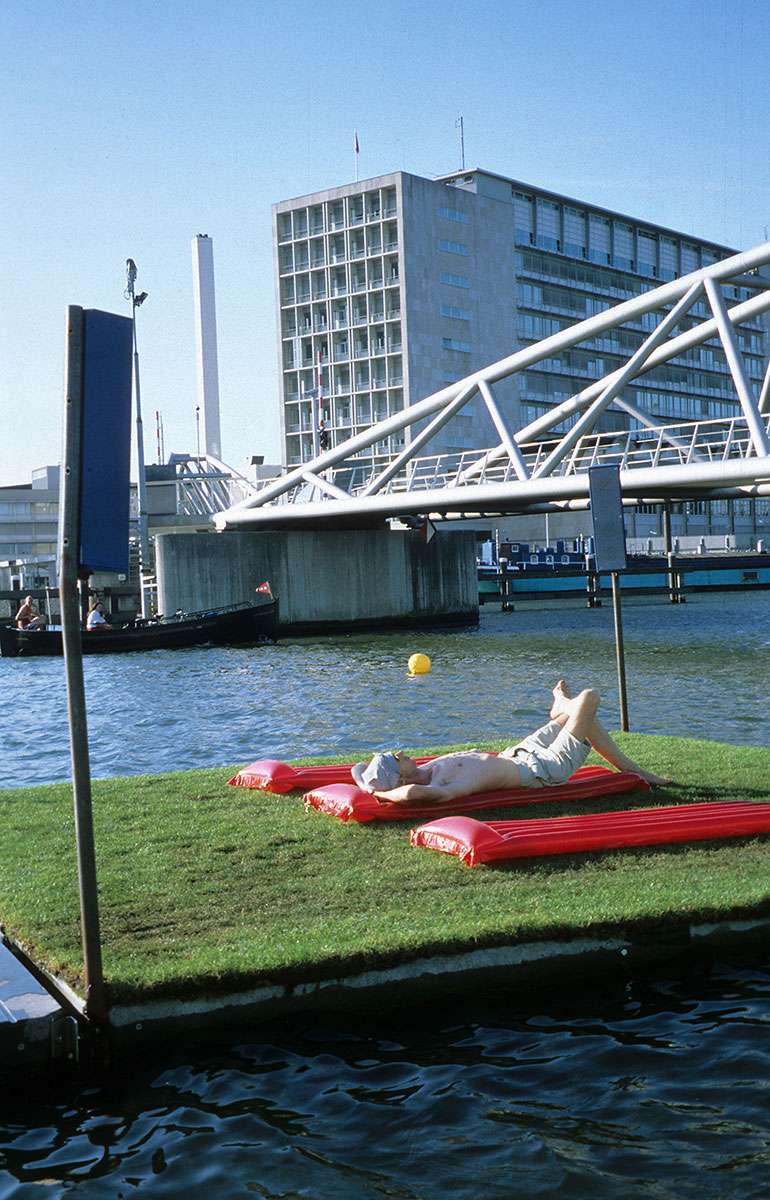
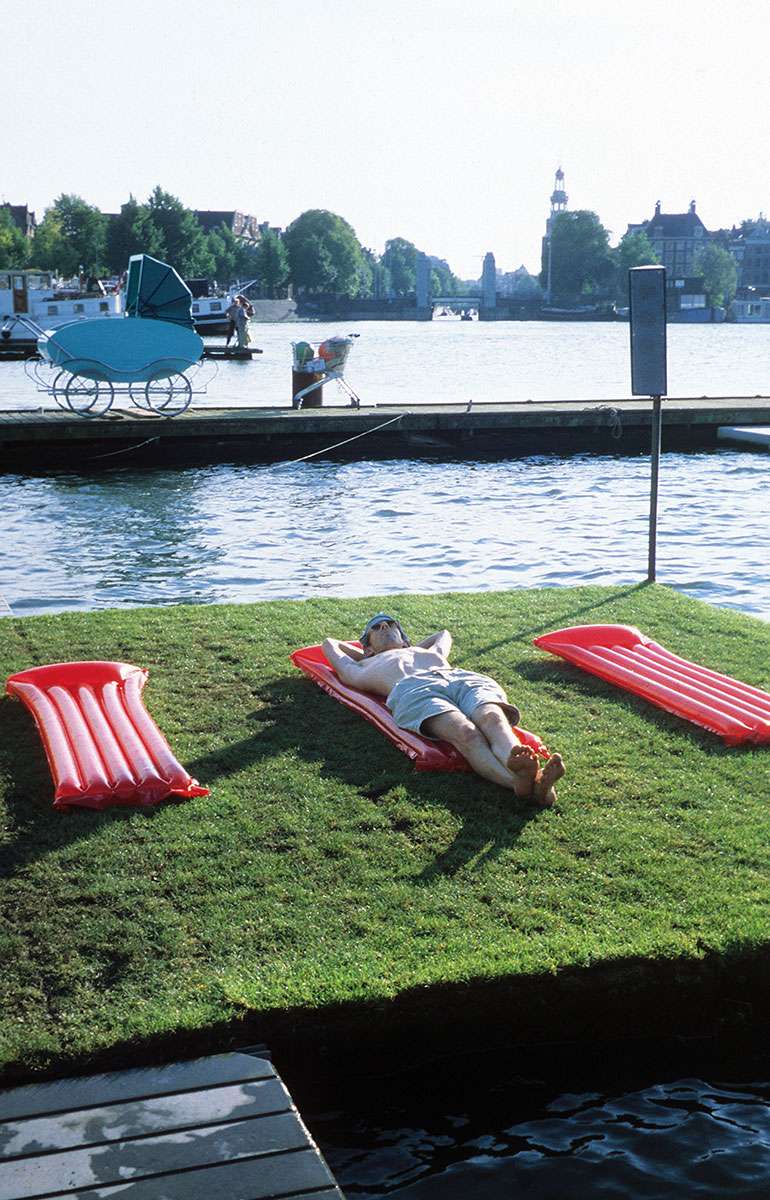 Greetings from IJ-City / in cooperation with Leta Spooren in the Oosterdok, Amsterdam / concrete floaters, grass, plastic air beds, CD players, speakers, metal / 650x650x200cm / 1999 / photos AT, JL
Greetings from IJ-City / in cooperation with Leta Spooren in the Oosterdok, Amsterdam / concrete floaters, grass, plastic air beds, CD players, speakers, metal / 650x650x200cm / 1999 / photos AT, JL
Our sound boxing ring consisted of a floating grass island with a loudspeaker on a pole in every corner. Different monologues about ‘public space ’sounded simultaneously from the 4 speakers. You could – literally – lie on an airbed on the grass in the middle of a sound fight.
In the context of Greetings from IJ-City we published a CD of all the monologues with the name Texts on Open Space.
Greetings from IJ-city – Texts on Open Space / in cooperation with Leta Spooren / self- published CD (in dutch only) / 1999
On 2 different tracks, 2 monologues from a total of 8 people who are professionally involved in public space, can be heard simultaneously.- Erik Hehenkamp, architect and designer, co-initiator Y-City project
- Geertje Offerhaus, director of Environmental Center Amsterdam
- Jos Gadet, planner, works at SPD Amsterdam (o.i.b.)
- Marian Breeman, board member, community centre Havens Oost Amsterdam
- Meike Skolnik, activist, works at Environmental Defense in Amsterdam (o.i.b.)
- Rob Aben, landscape architect, works for the SPD Amsterdam (o.i.b.)
- Ronald Wiggers, social geographer, works at project office IJburg, SPD Amsterdam (o.i.b.)
- Roy Berents, landscape planner, HAPS urban planner, works for the SPD Amsterdam (o.i.b.)
SPD = Spatial Planning Department
o.i.b = on an individual basis
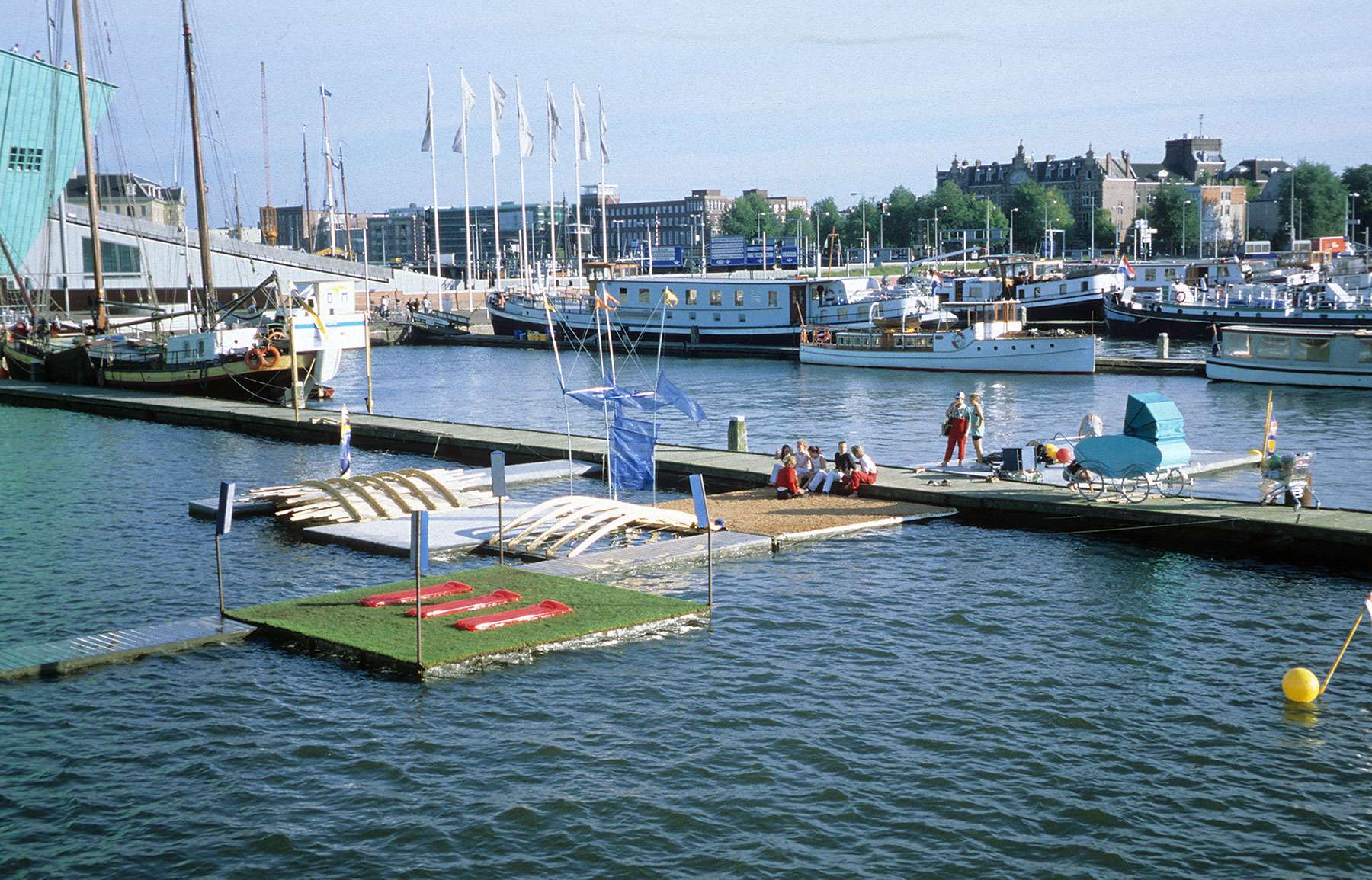
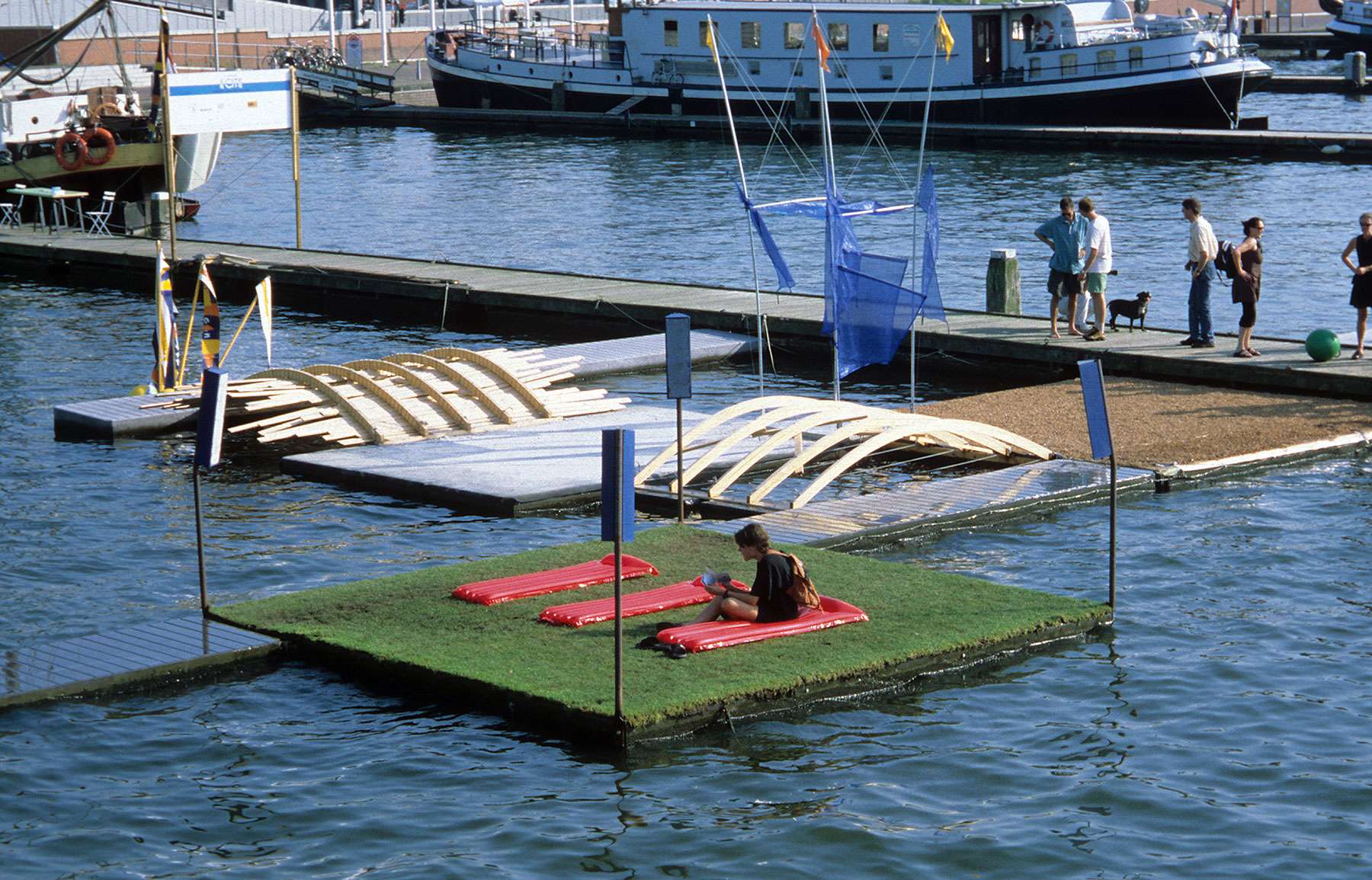
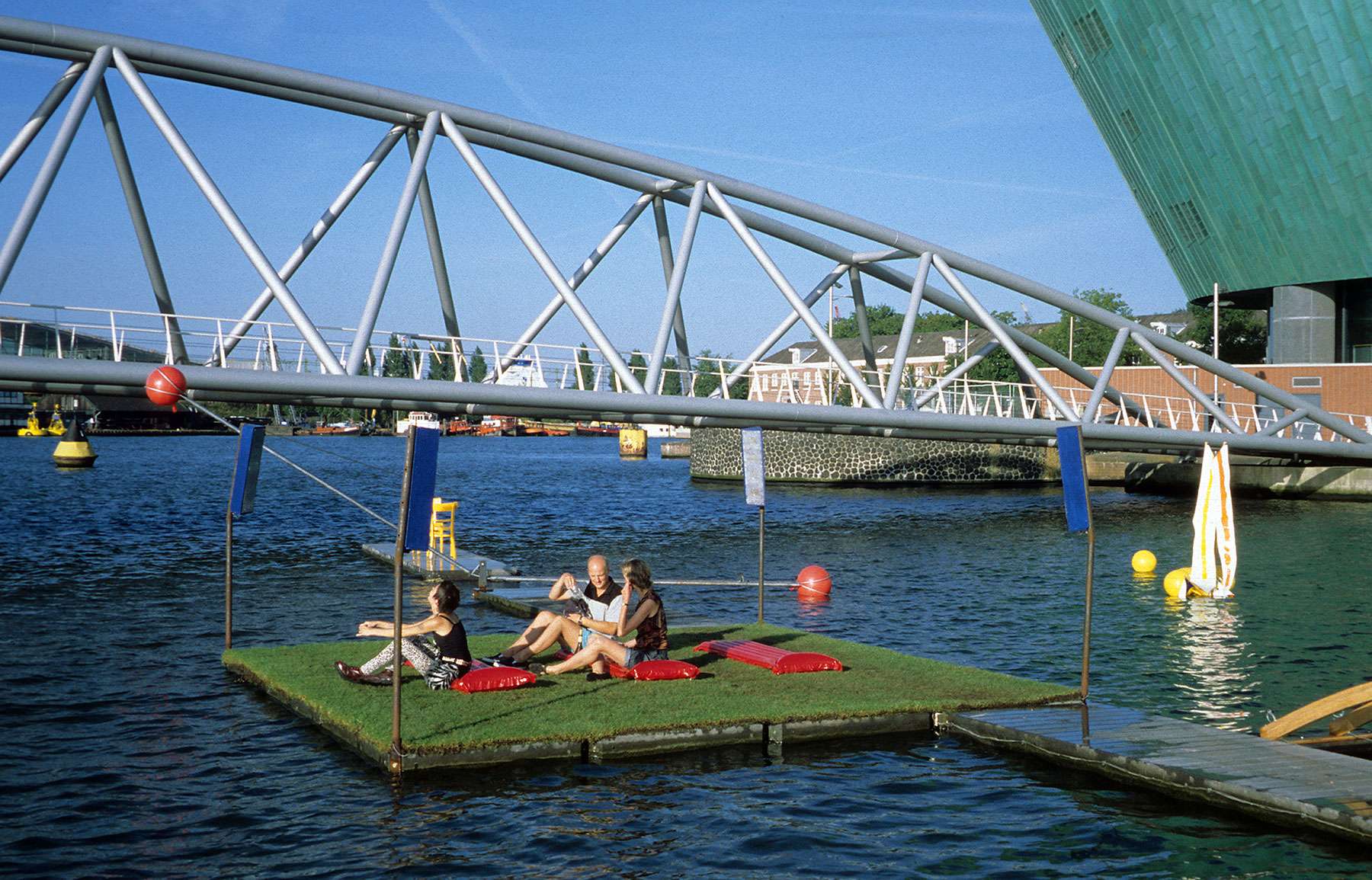
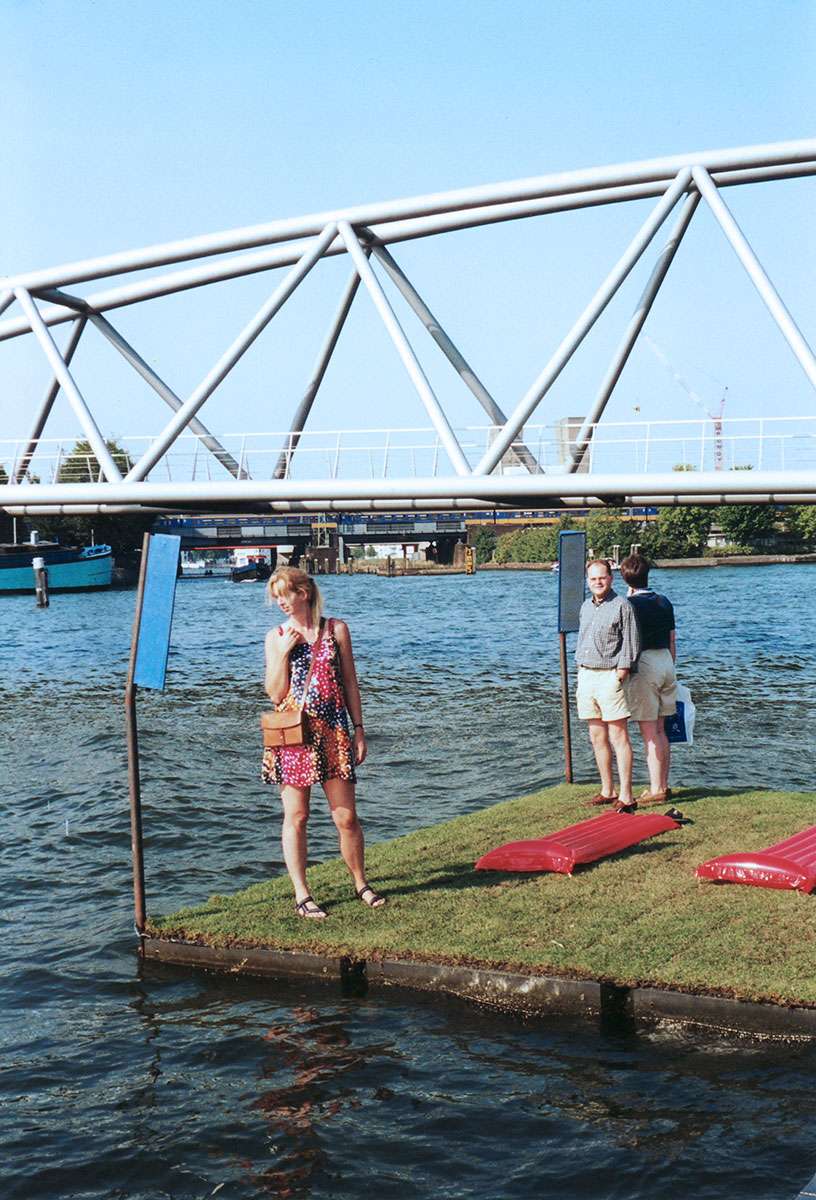
 Greetings from IJ-City / in cooperation with Leta Spooren in het Oosterdok, Amsterdam / concrete floaters, grass, plastic air beds, CD players, speakers, metal / 650x650x200cm / 1999 / photos AT, JL
Greetings from IJ-City / in cooperation with Leta Spooren in het Oosterdok, Amsterdam / concrete floaters, grass, plastic air beds, CD players, speakers, metal / 650x650x200cm / 1999 / photos AT, JL
‘Prised a little loose from the context we could perceive Il faut cultiver notre jardin … in our time as a spur to know the parameters of our enclosed space – from our house, our responsibilities, The most famous phrase about gardens: the concluding sentence of Voltaire’s Candide. After the unmasking of utopias, ideologies and the search for paradise on earth as dangerous illusions, the book ends with: ‘You said that exceptionally well,’ Candide replies, ‘but let us cultivate our garden.' Il faut cultiver notre jardin ...because these details – though they are still such platitudes – with the endless space of the wilderness, the hunt, the flight, the free will, the false alibis, wanting to be like God, portray our garden after all.
They are our garden.
Therefore a social symbol. Not in the first place the search for a paradise or the hopeless struggling through a labyrinth: Il faut cultiver notre jardin … Not a garden of weak compassion and interfering understanding, of philanthropy and socialism, but a garden in which flowers may bloom and blossom at any moment, from Narcissus, Hyacinthus, Adonis, Crocus that were once all people.’
Source: On the necessity of gardening, Huizinga reading 1990, by Gerrit Komrij
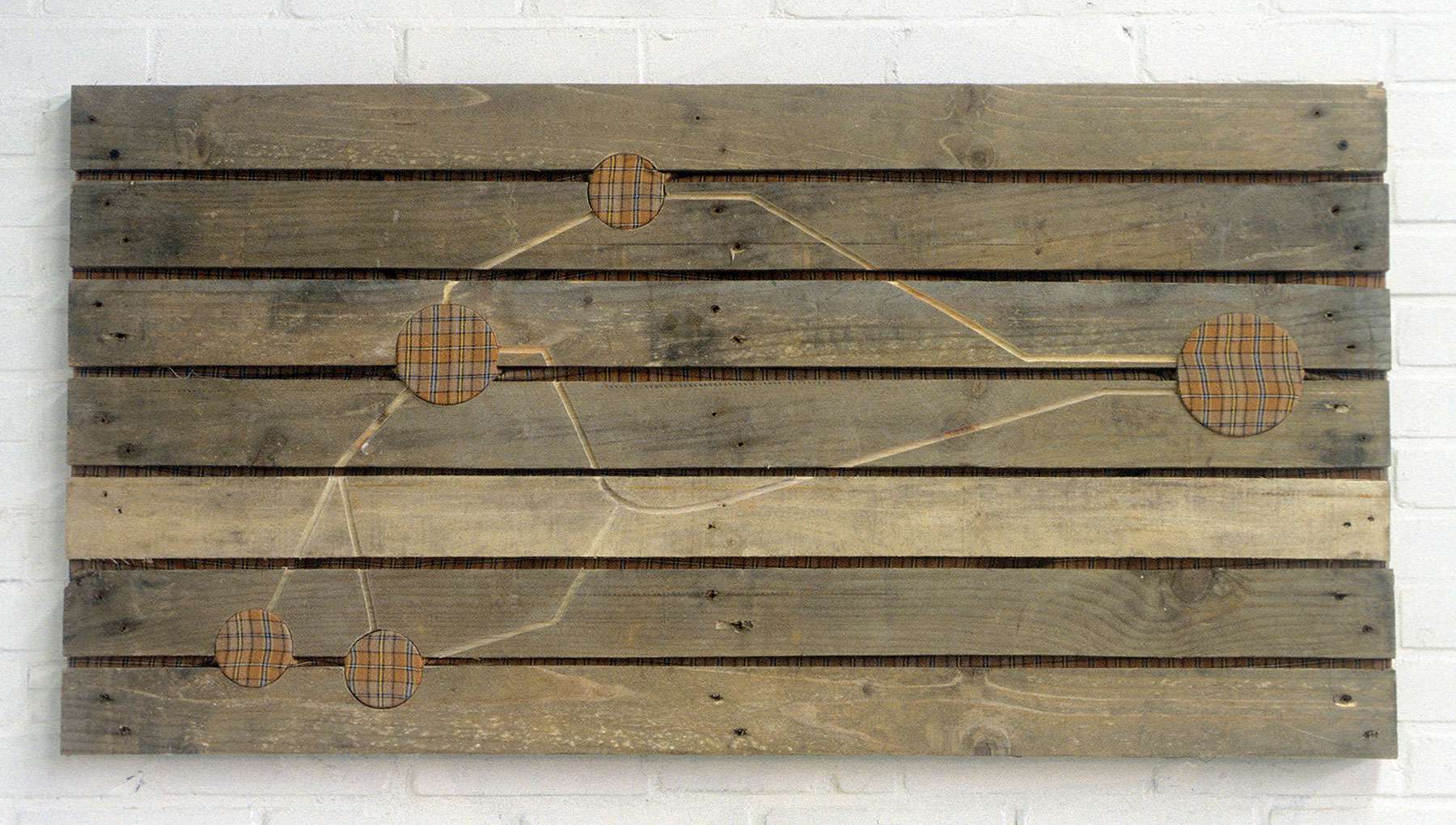 Own place (palette) / textile, wood / size / 1993
Own place (palette) / textile, wood / size / 1993
 Own place (polyester) / textile, polyester / size / 1993
Own place (polyester) / textile, polyester / size / 1993
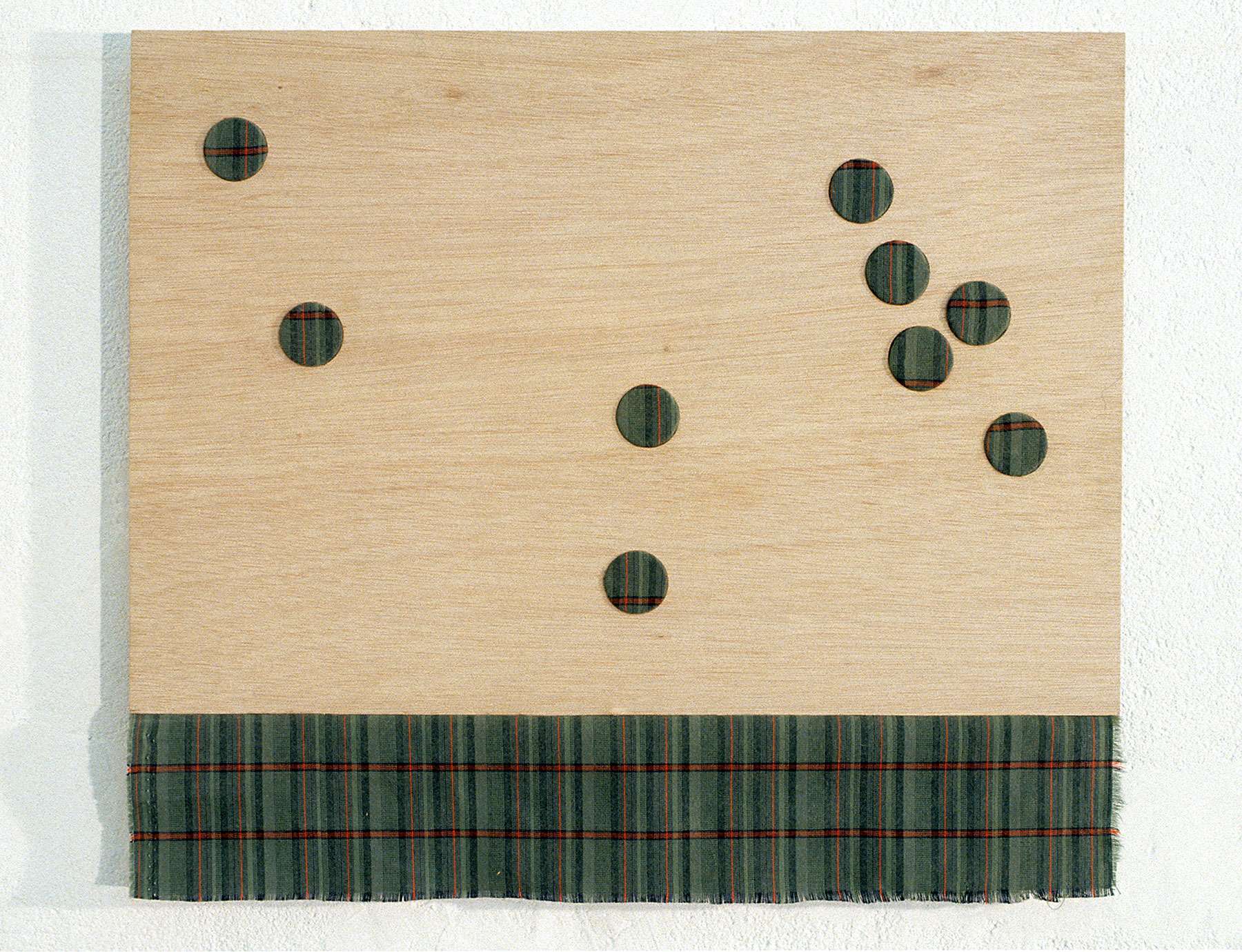 Own place (wood) / textile, wood / size / 1993
Own place (wood) / textile, wood / size / 1993
Using my own hometown and that of my 8 brothers and sisters I created the last 2 works above. In them I have recorded the mutual geographical distances in relation to each other. In a similar way, the first work records a number of special places from my youth.
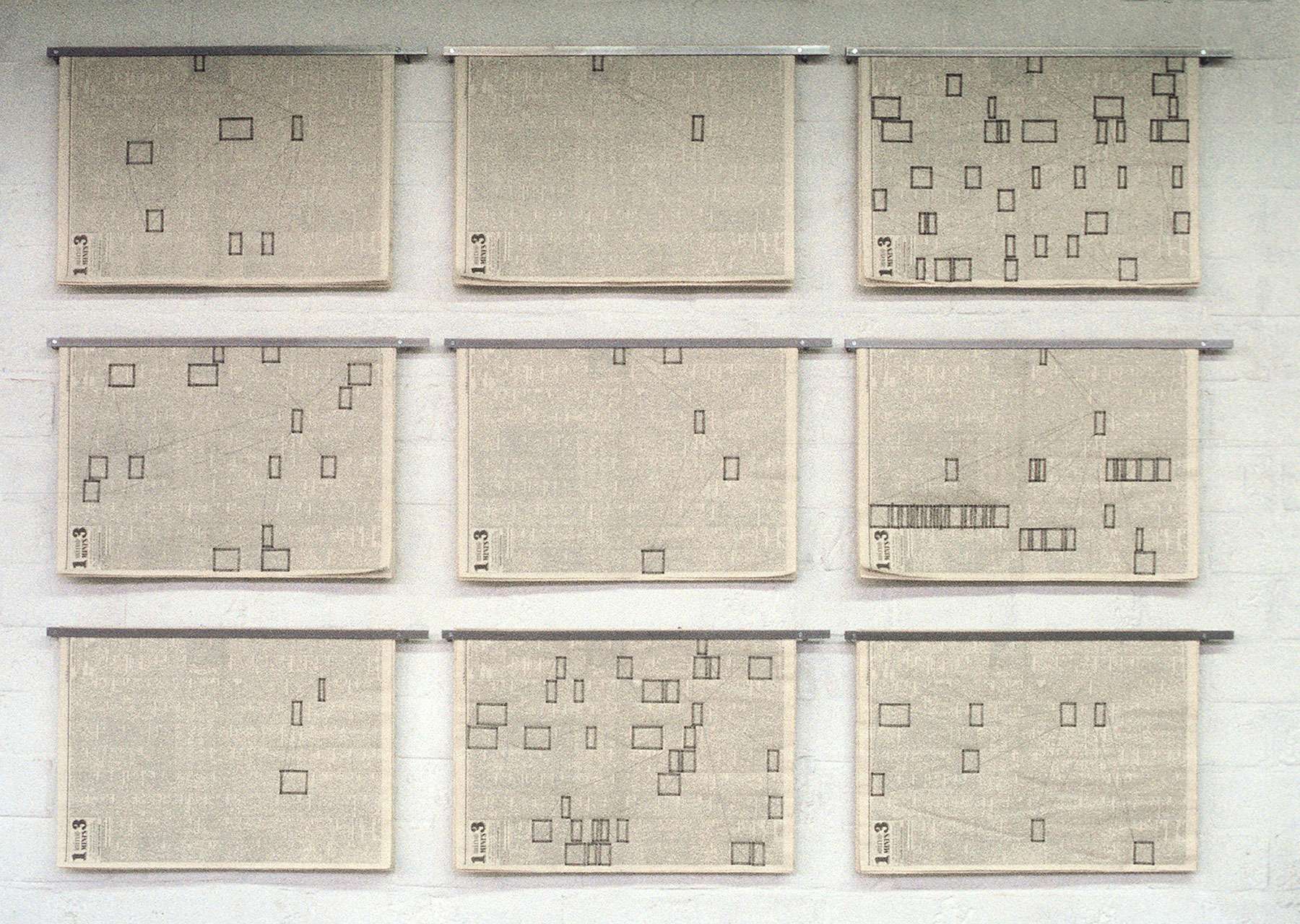
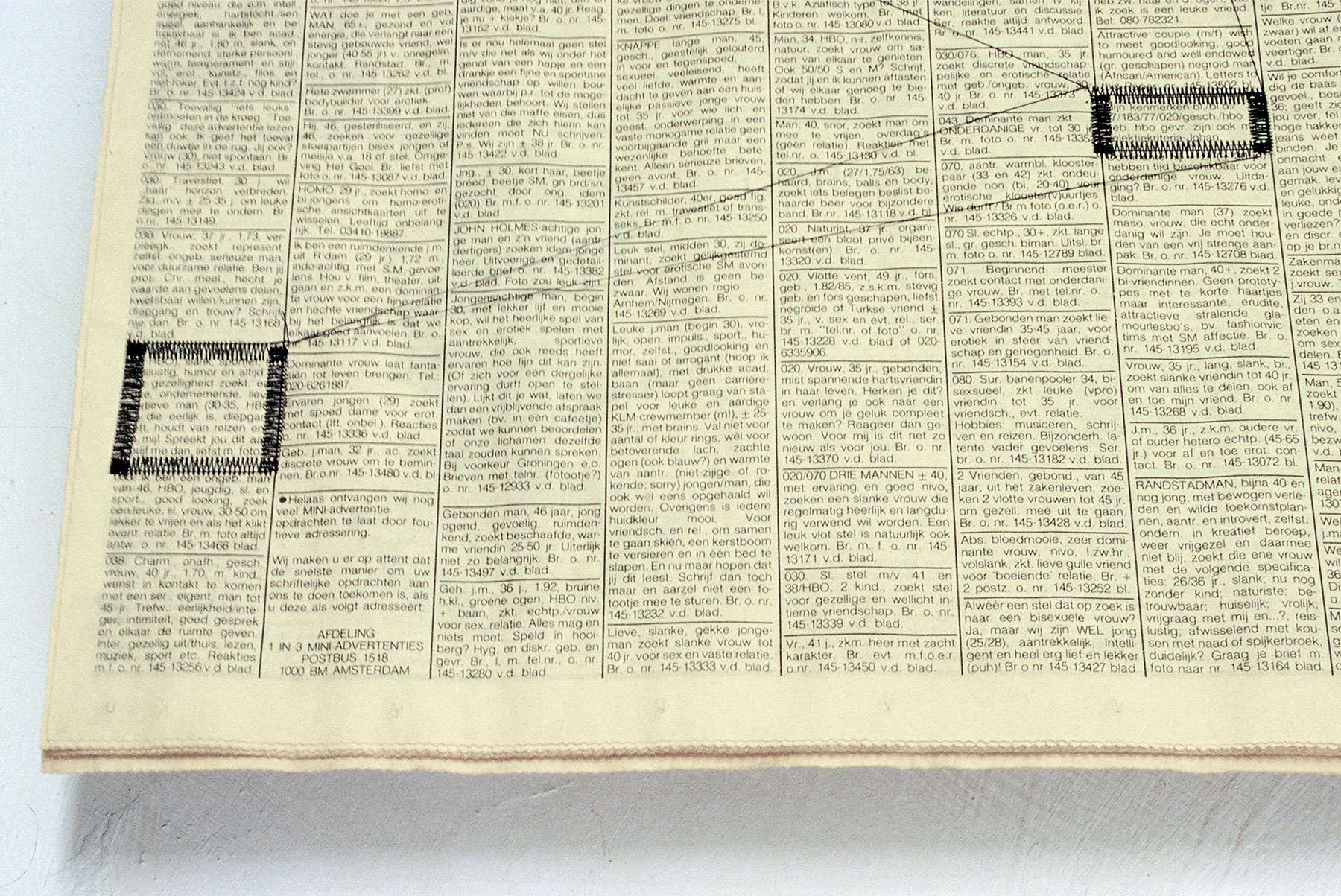
Bl/bl.o./37/185/75/020/gesch./hbo gevr./hbo geb. / newspapers, thread, metal / 215x150x3cm / 1992-1993
On the personals page of the Volkskrant newspaper of Saturday, 7 November 1992, I presented myself using 9 more or less objective criteria. I also collected these criteria, that are often used in personals, from other personals on the same page.
Then I consistently took 1 criterion as guideline and selected people who met this criterion. The selections were connected to each other using a thread, forming its own group. My own advertisement always acted as the starting point.
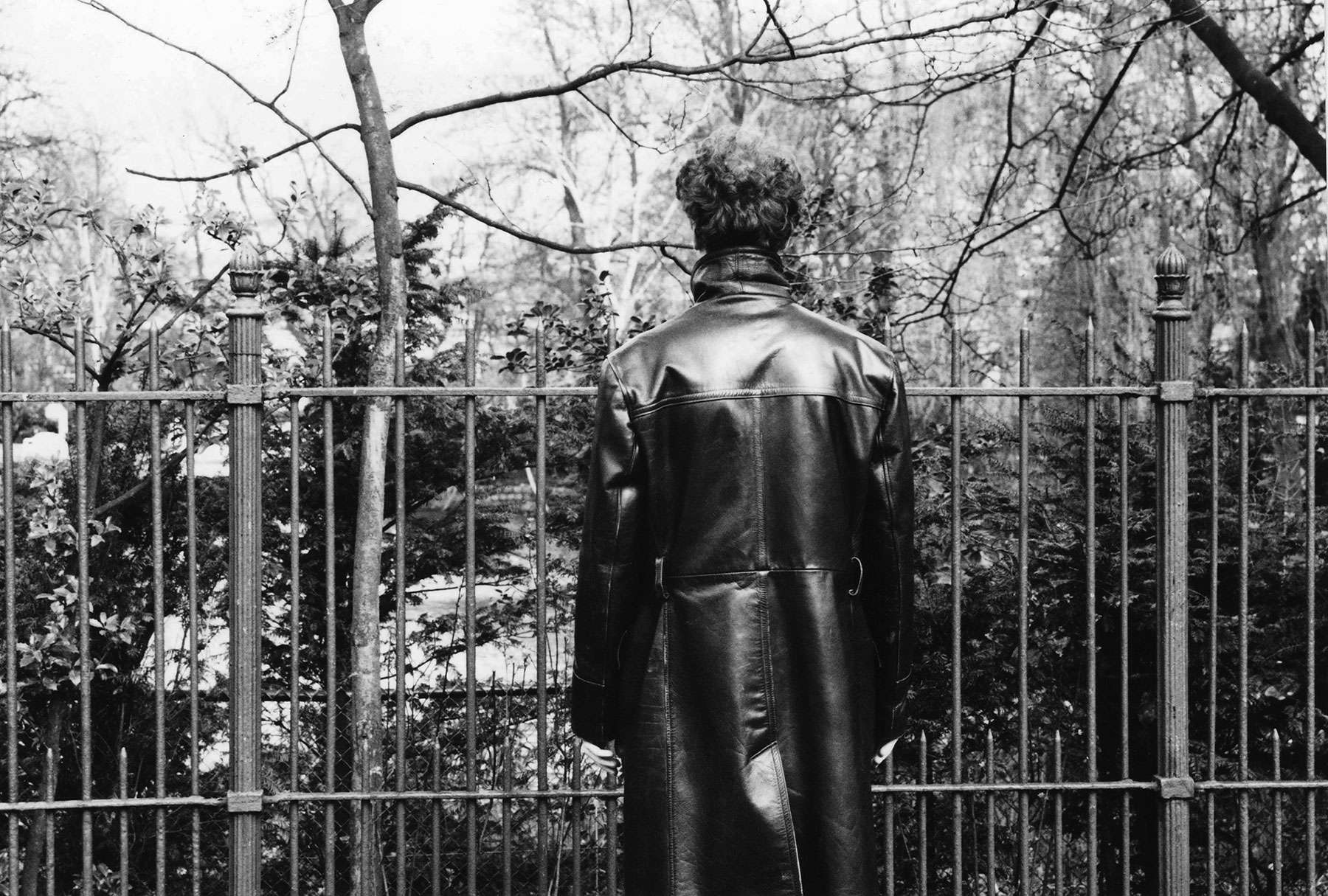
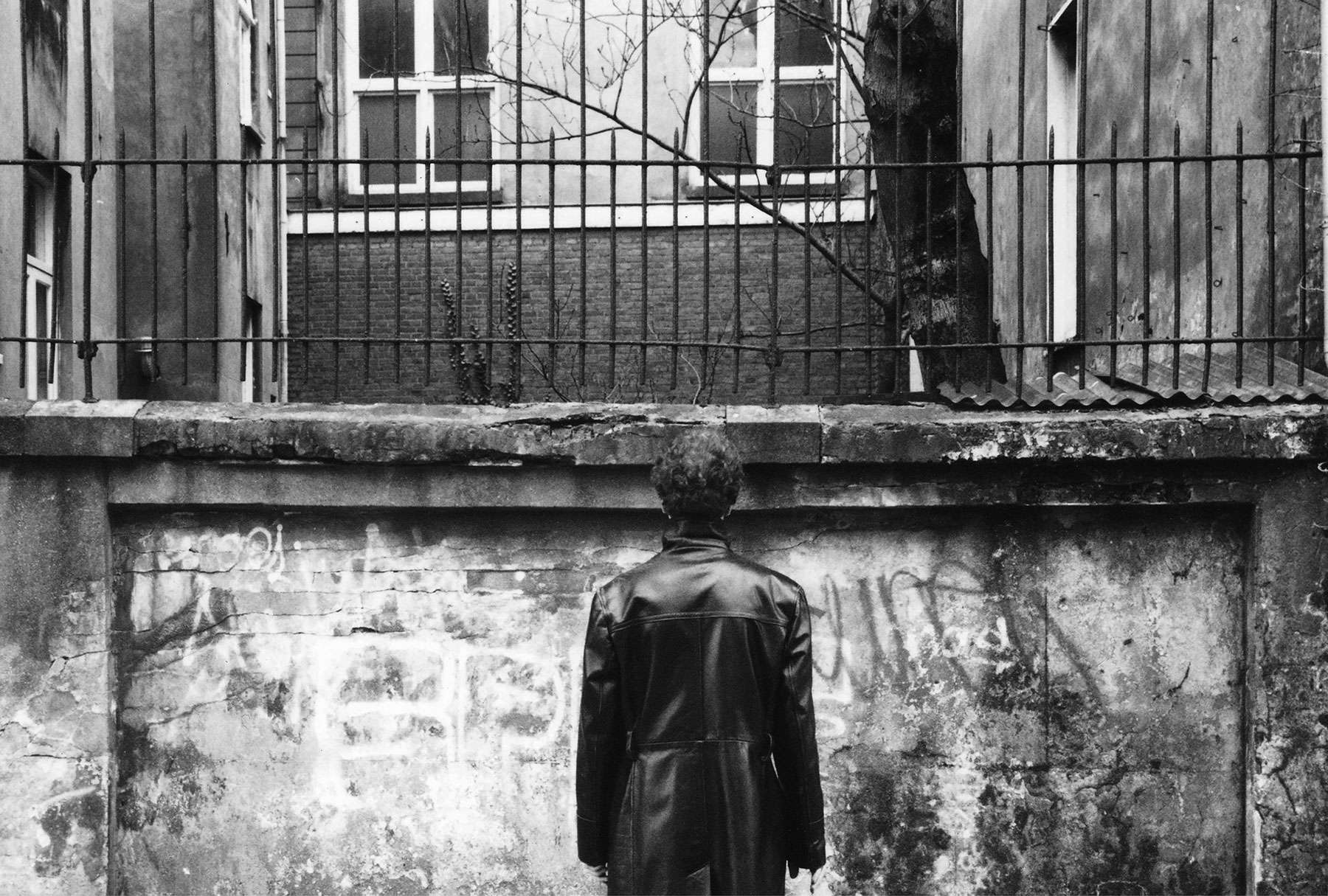
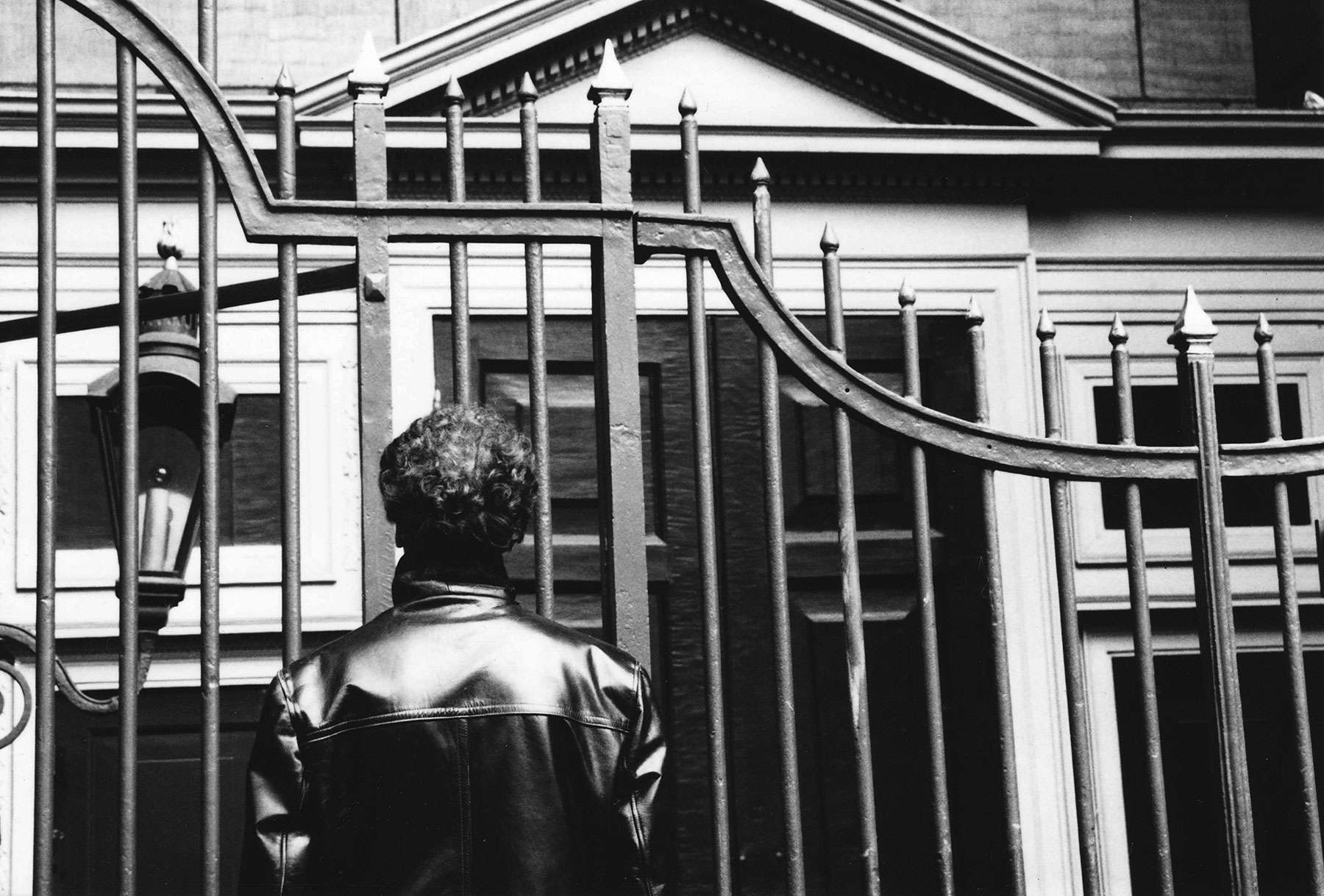
‘There is no freedom in the desert sands,
Despite the fact there are no stakes or fences.
If to be free’s your aim, then your best chance
Is stylish roaming through a maze of trenches.
Along each path you take you’ll meet with much
Coercion, but so doing won’t fall prey to
Gauche demolishers of fences, to such
As seek one hellish jail all are conveyed to’
Source: Everything unreal. Choice of poems, by Gerrit Komrij, 1984. Translation © 1998 John Irons.

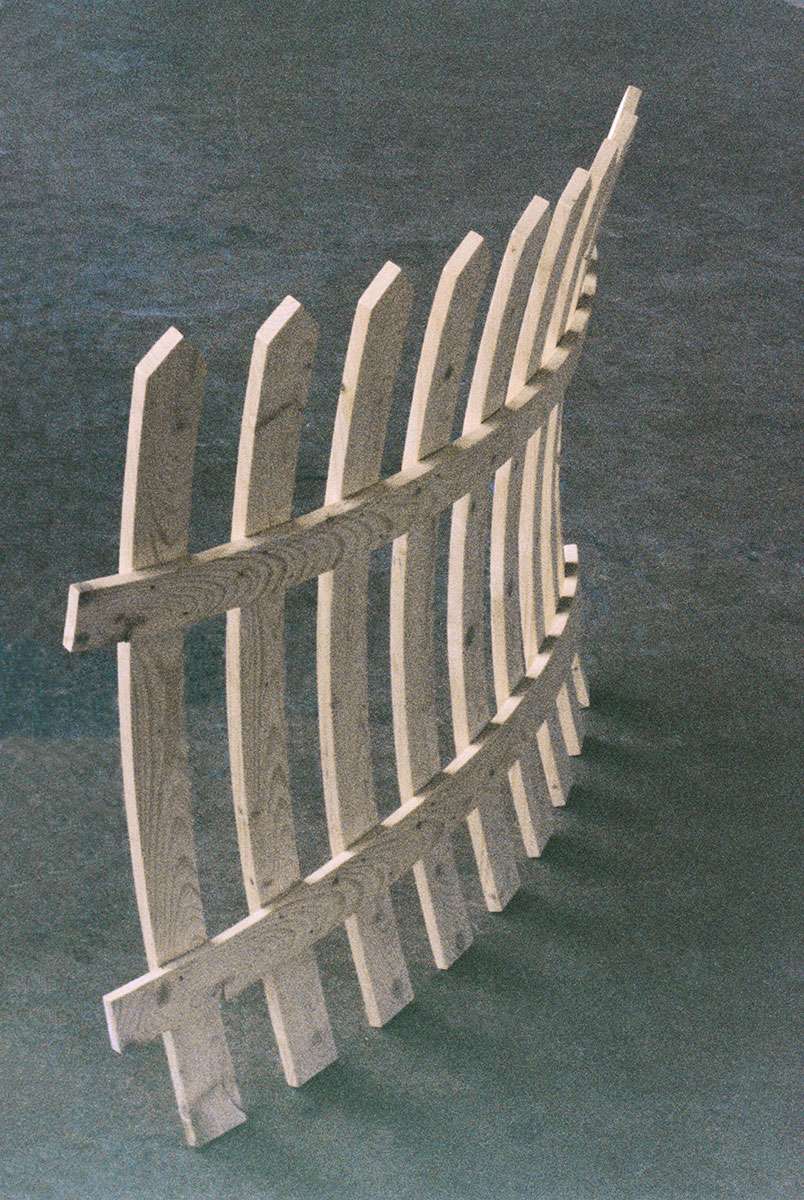 no title (slanted fence) / wood / size / 1992
no title (slanted fence) / wood / size / 1992
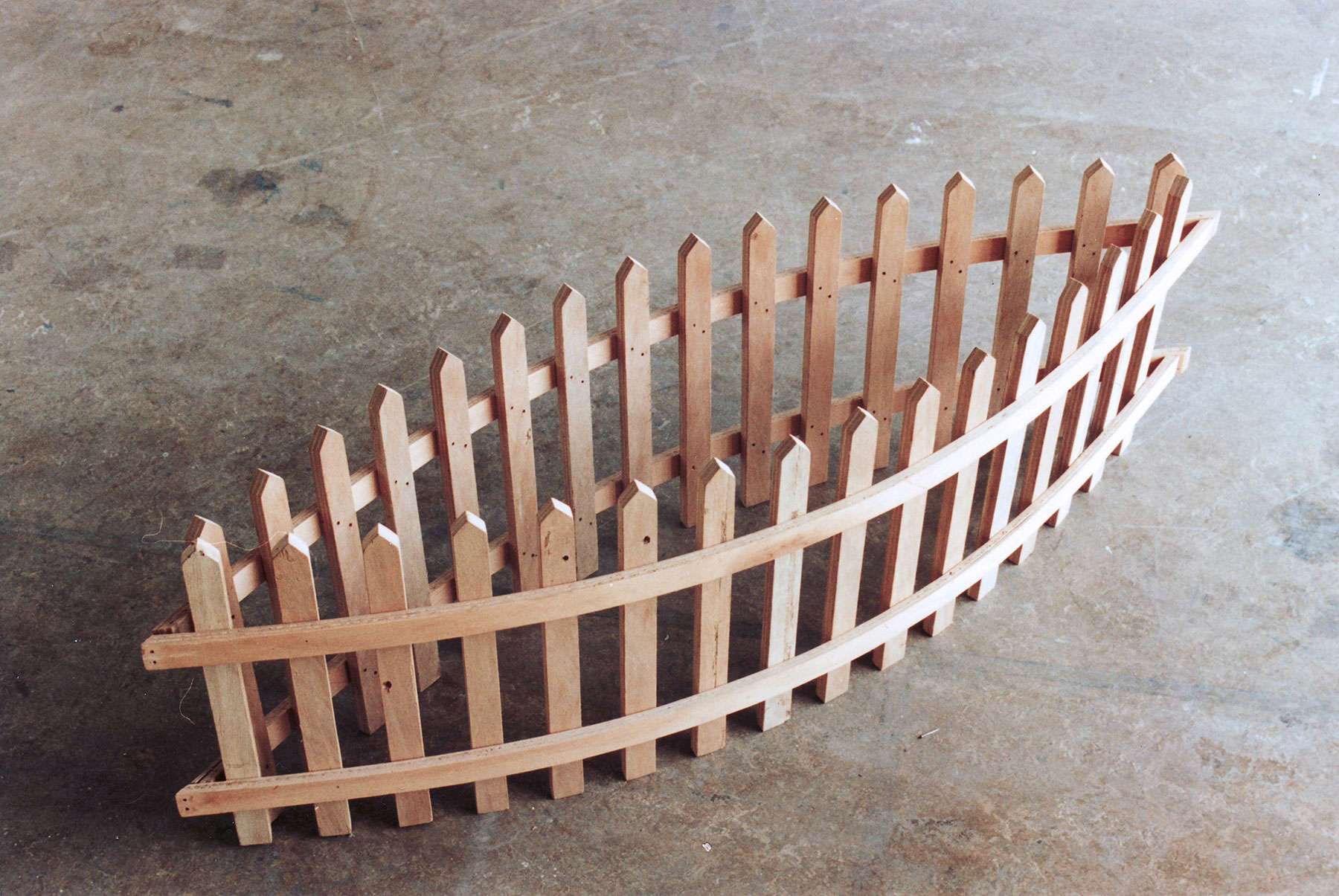 no title (boat fence) / wood / size / 1992
no title (boat fence) / wood / size / 1992
 no title (corner fence) / wood / size / 1992
no title (corner fence) / wood / size / 1992
A division in the landscape causes a change in movement and often a change in looking and perception. This makes the separation and delineation important features of every garden, just as the edge is a critical feature of a carpet.
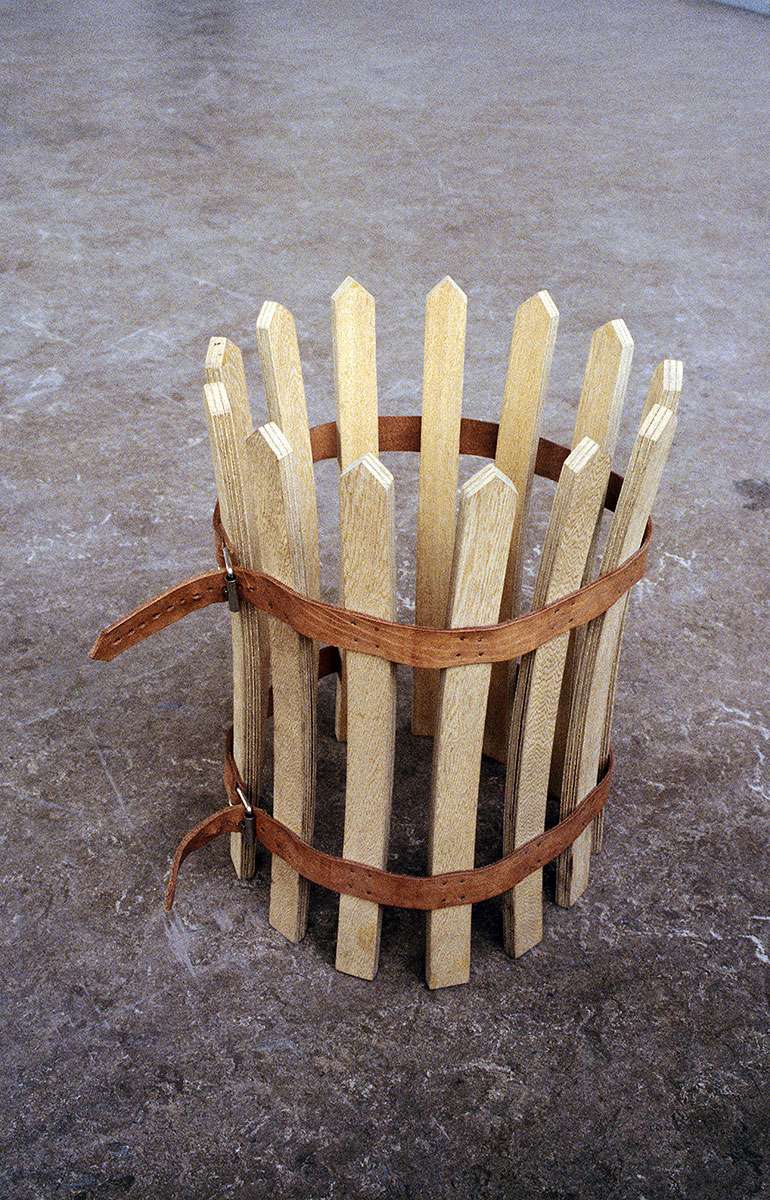 no title (corset fence) / wooden, leather belt, buckle / 35x35x45cm / 1992
no title (corset fence) / wooden, leather belt, buckle / 35x35x45cm / 1992
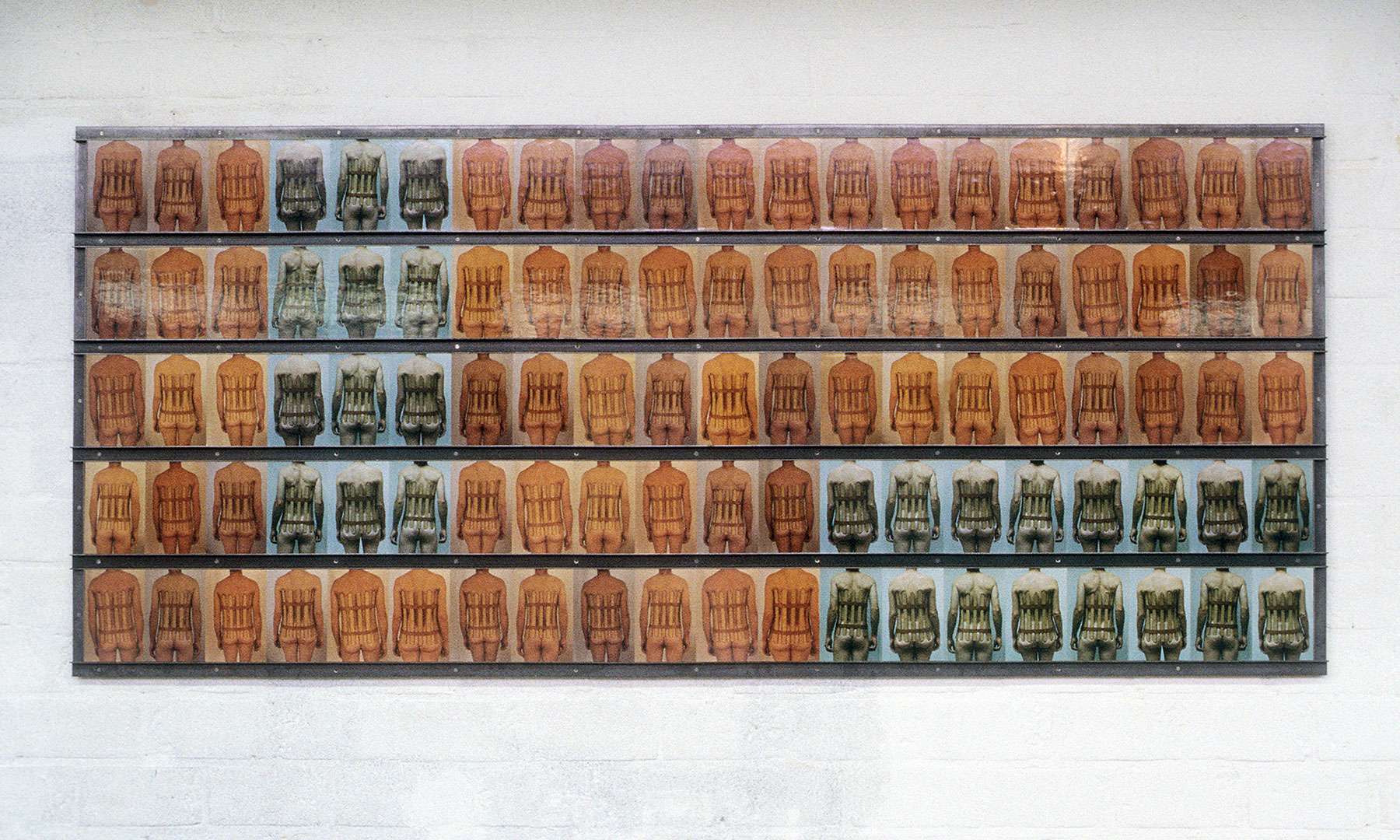 The Body, the Person, the City and the Boundary / photos, metal, wood / 87x204x4cm / 1993
The Body, the Person, the City and the Boundary / photos, metal, wood / 87x204x4cm / 1993
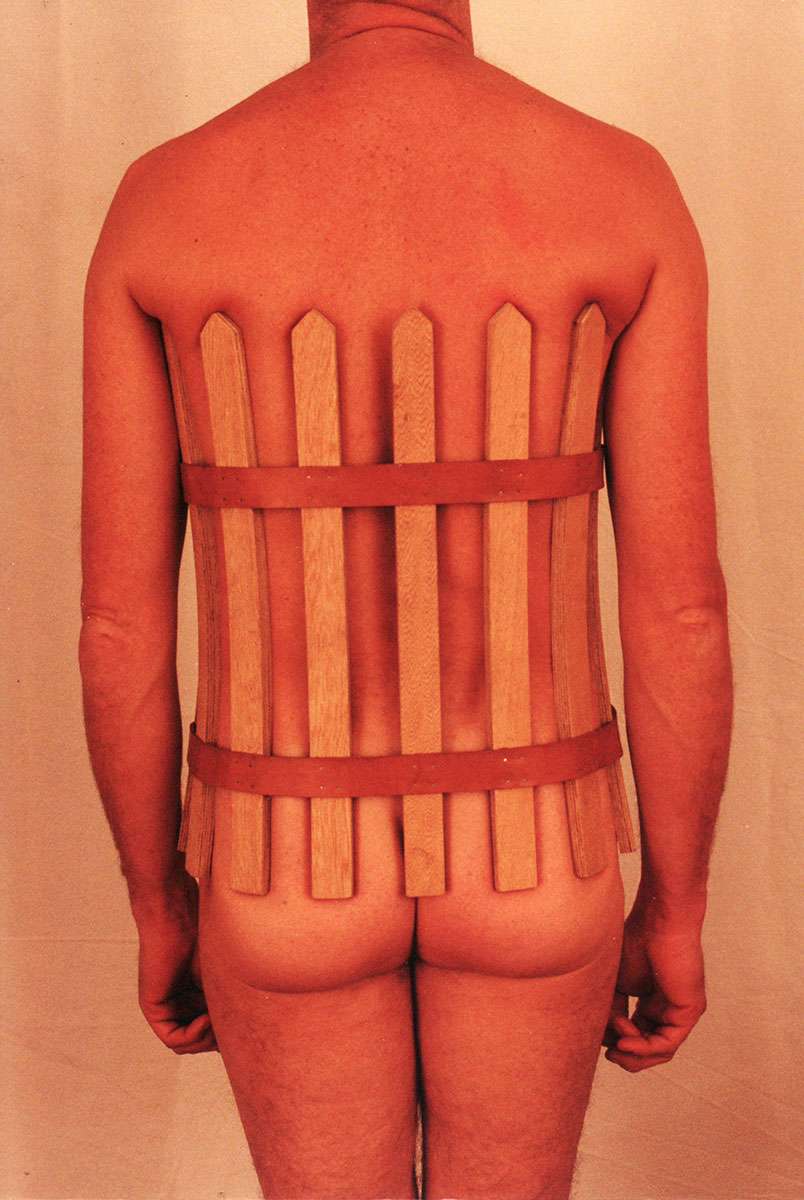
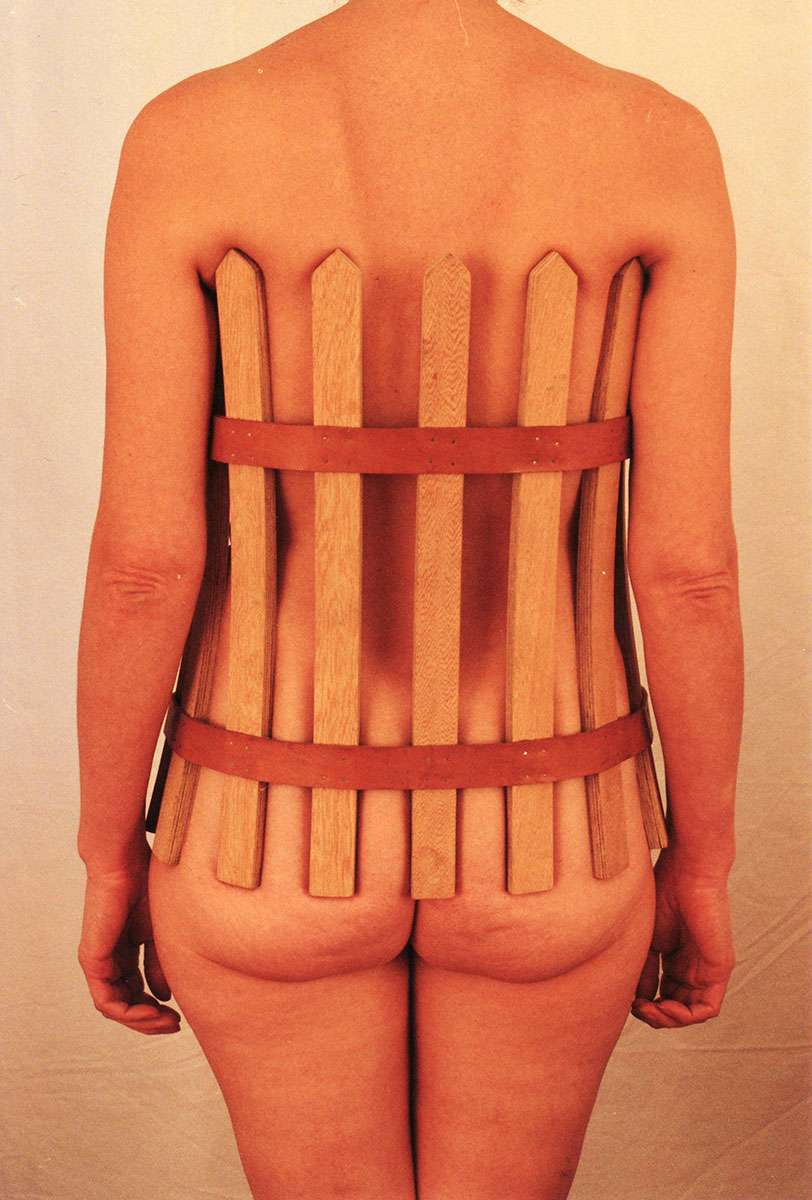
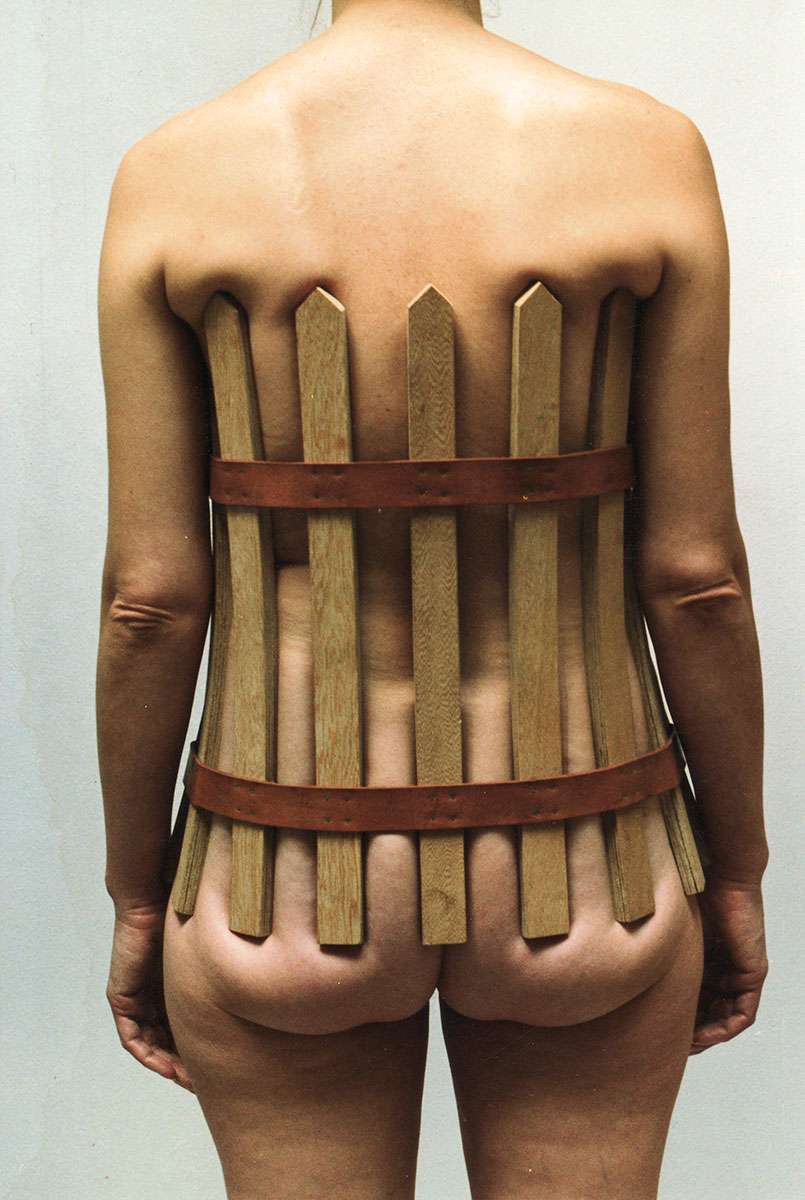
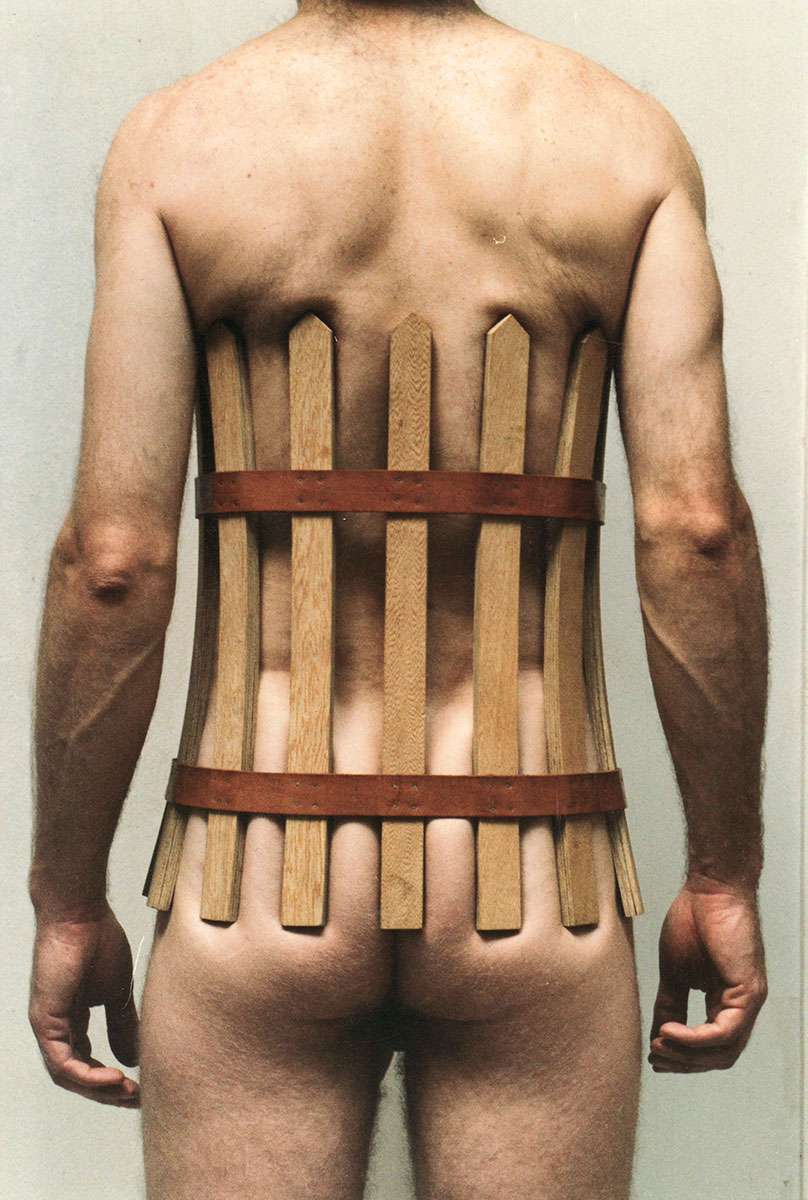 Elements from The Body, the Person, the City and the Boundary / photos, metal, wood / 87x204x4cm / 1993
Elements from The Body, the Person, the City and the Boundary / photos, metal, wood / 87x204x4cm / 1993
If a boundary is drawn on your own garden or your own place, if you look inwards, it may provide concentration and an enrichment of the (mental) scope. However, a boundary can also be drawn on the surroundings. Then it causes a limitation, a clash and blocked scope.
On the personal, physical level, our skin is our boundary, reinforced by clothing. In The Body, the Person, the City and the Boundary body and garden are linked to each other by using fencing as a garment. It is like a corset that not only encircles the body, but also laces it in.
I applied the concept of lacing previously in a combination of bread and metal in This is my bread. See below for a version in wool and a belt.
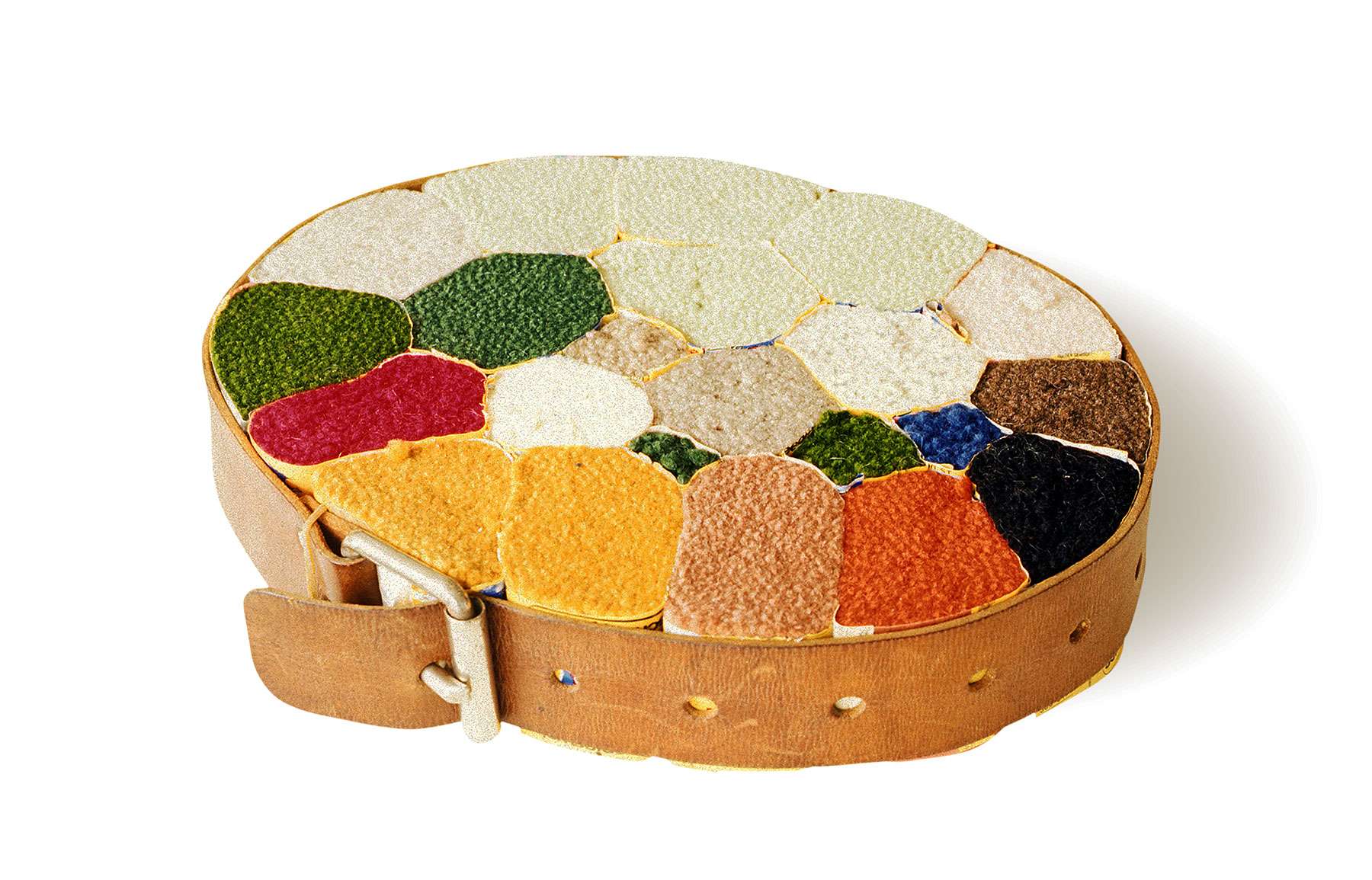 no title (belt 1) / wool, leather belt, buckle / 34x29x6cm / 1995
no title (belt 1) / wool, leather belt, buckle / 34x29x6cm / 1995
Hieronder nog een aantal foto's uit het atelier.
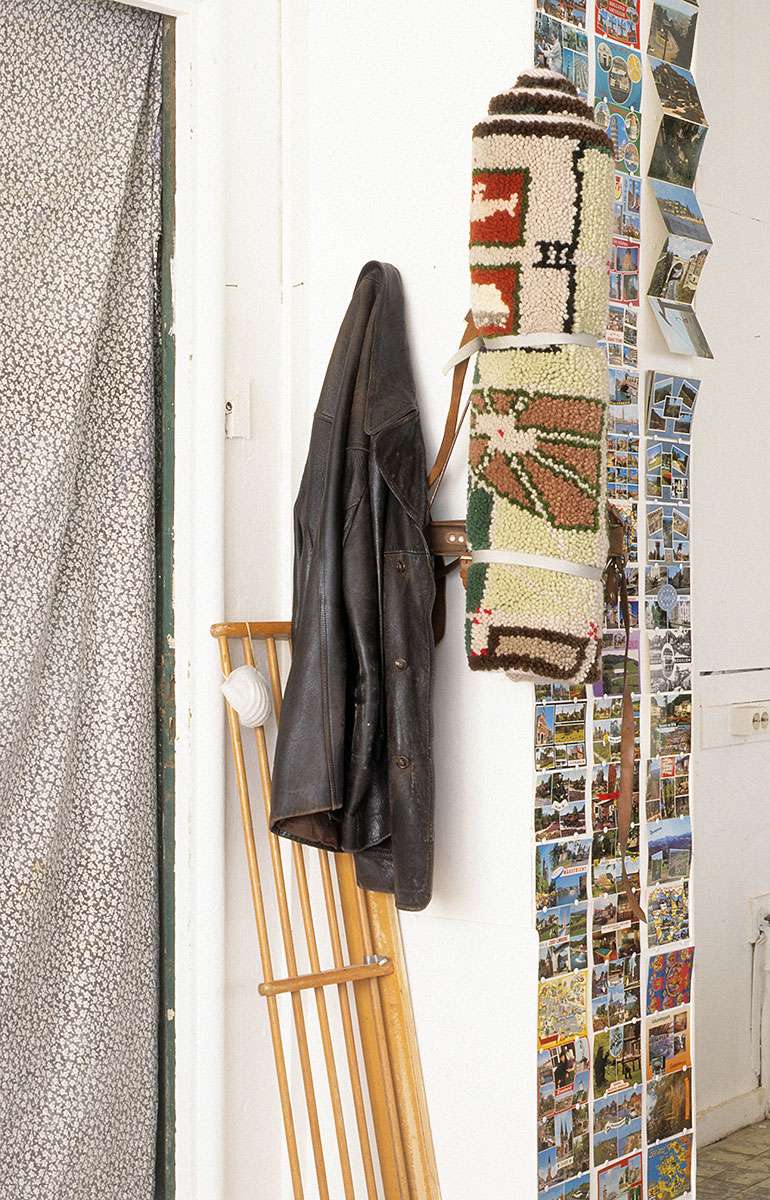
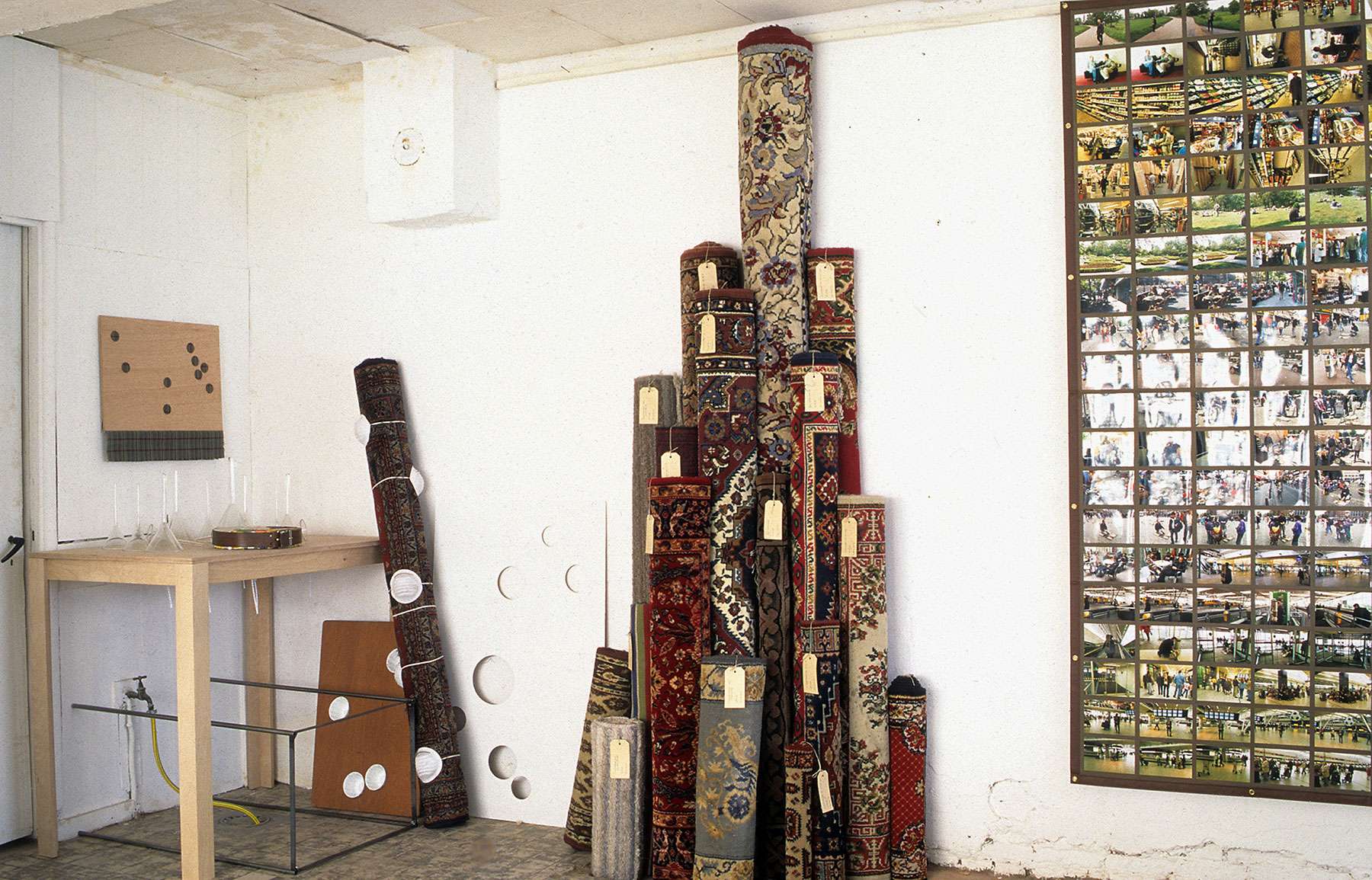 Studio photos
Studio photos